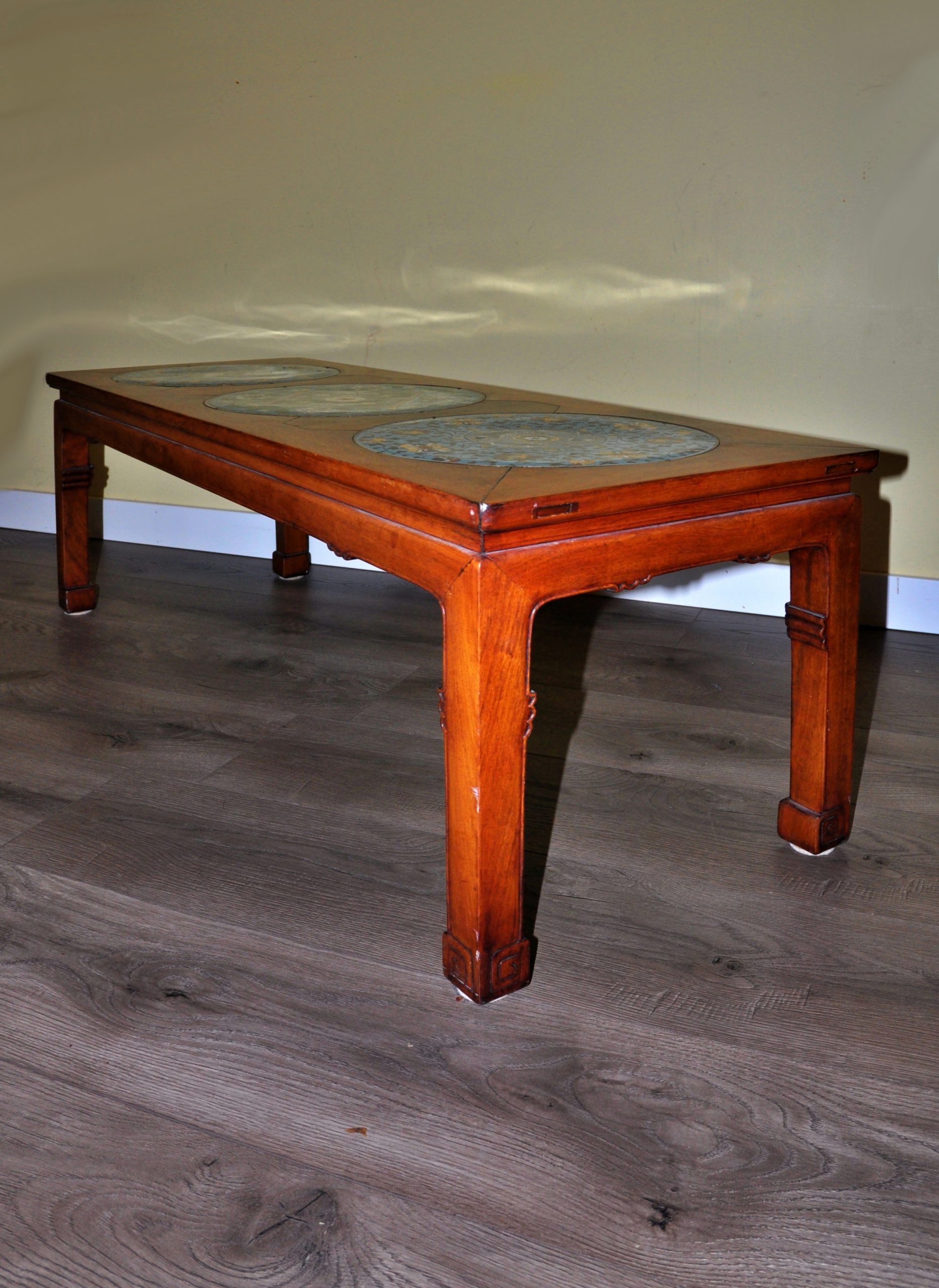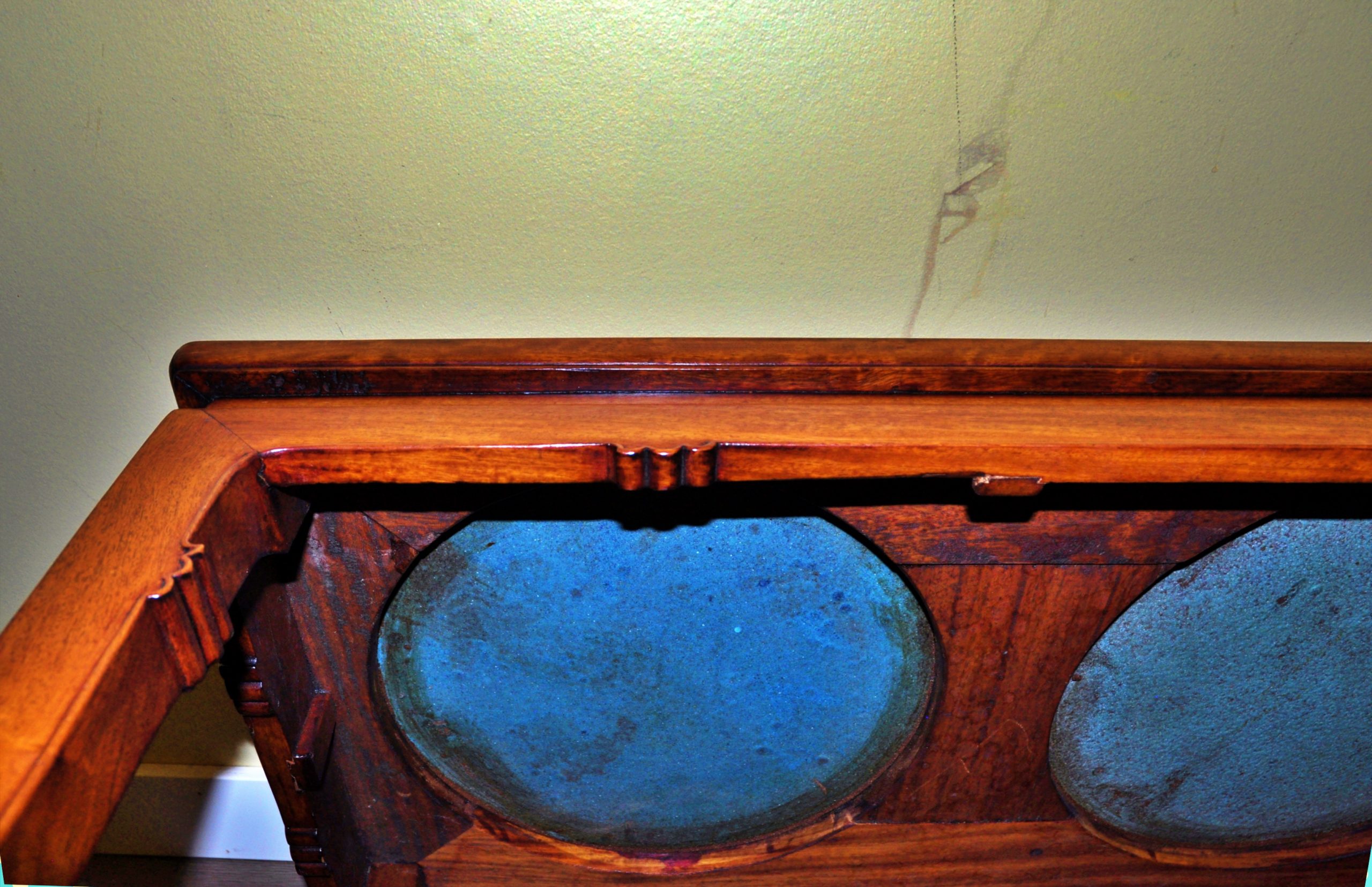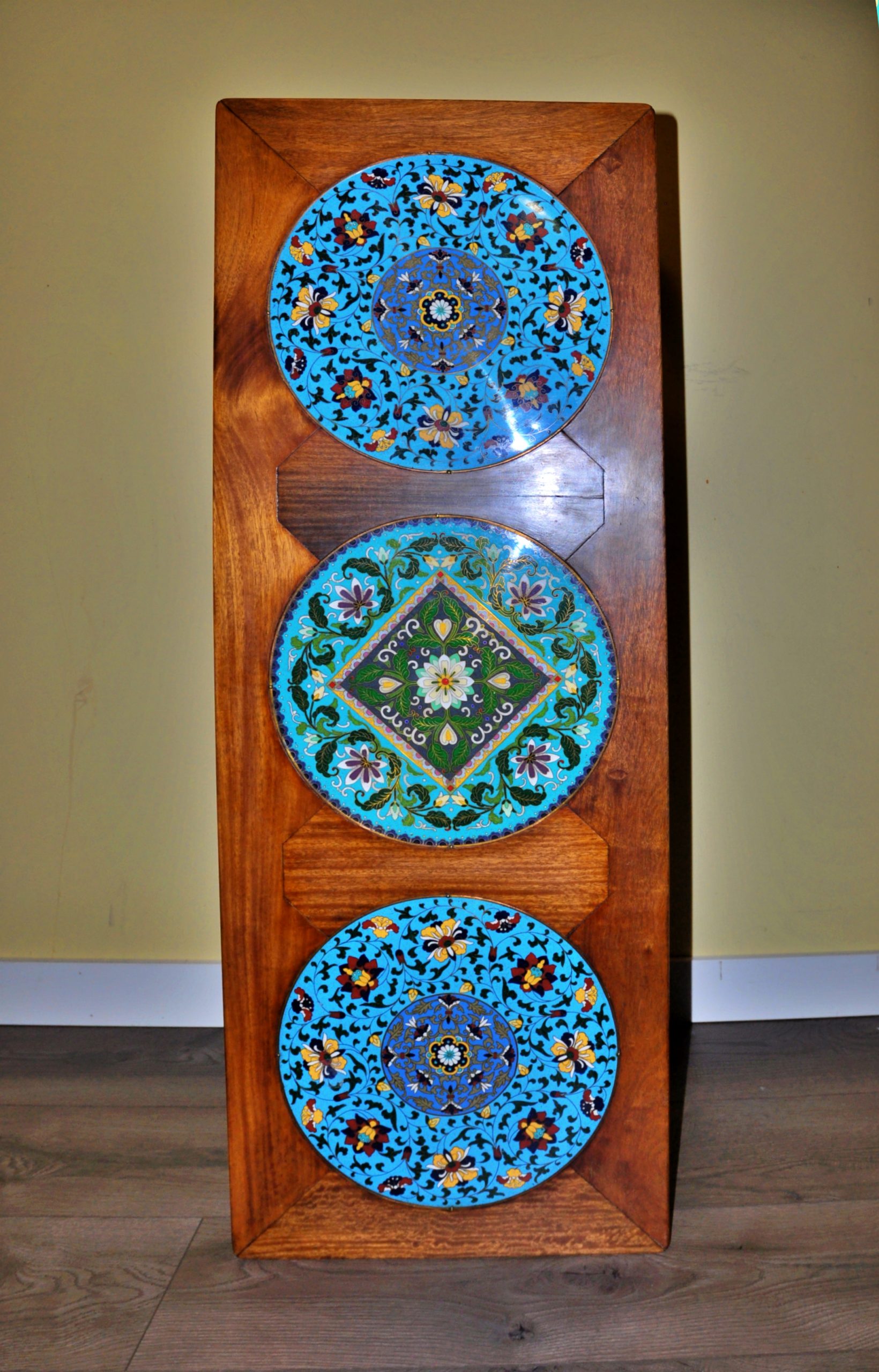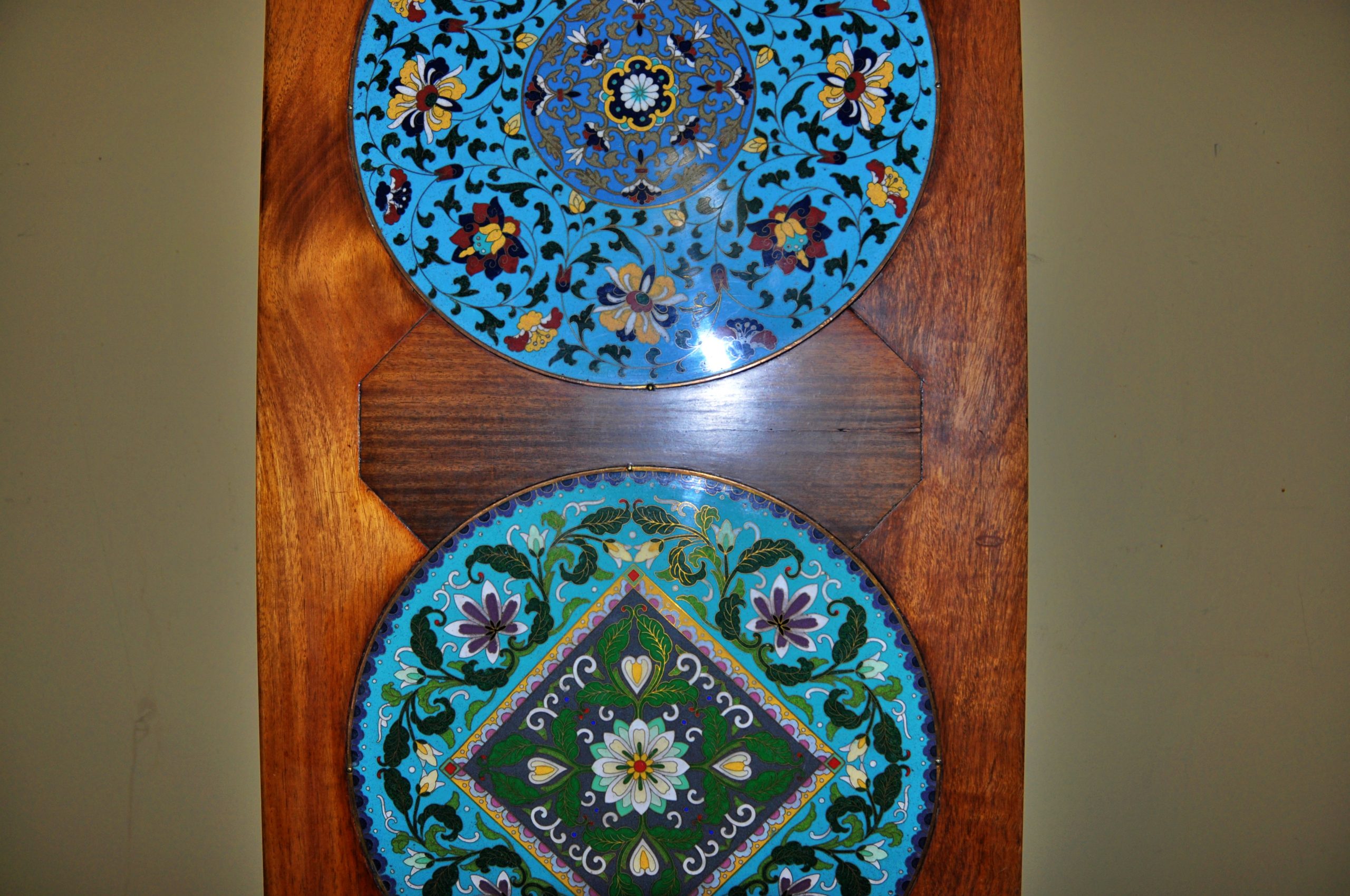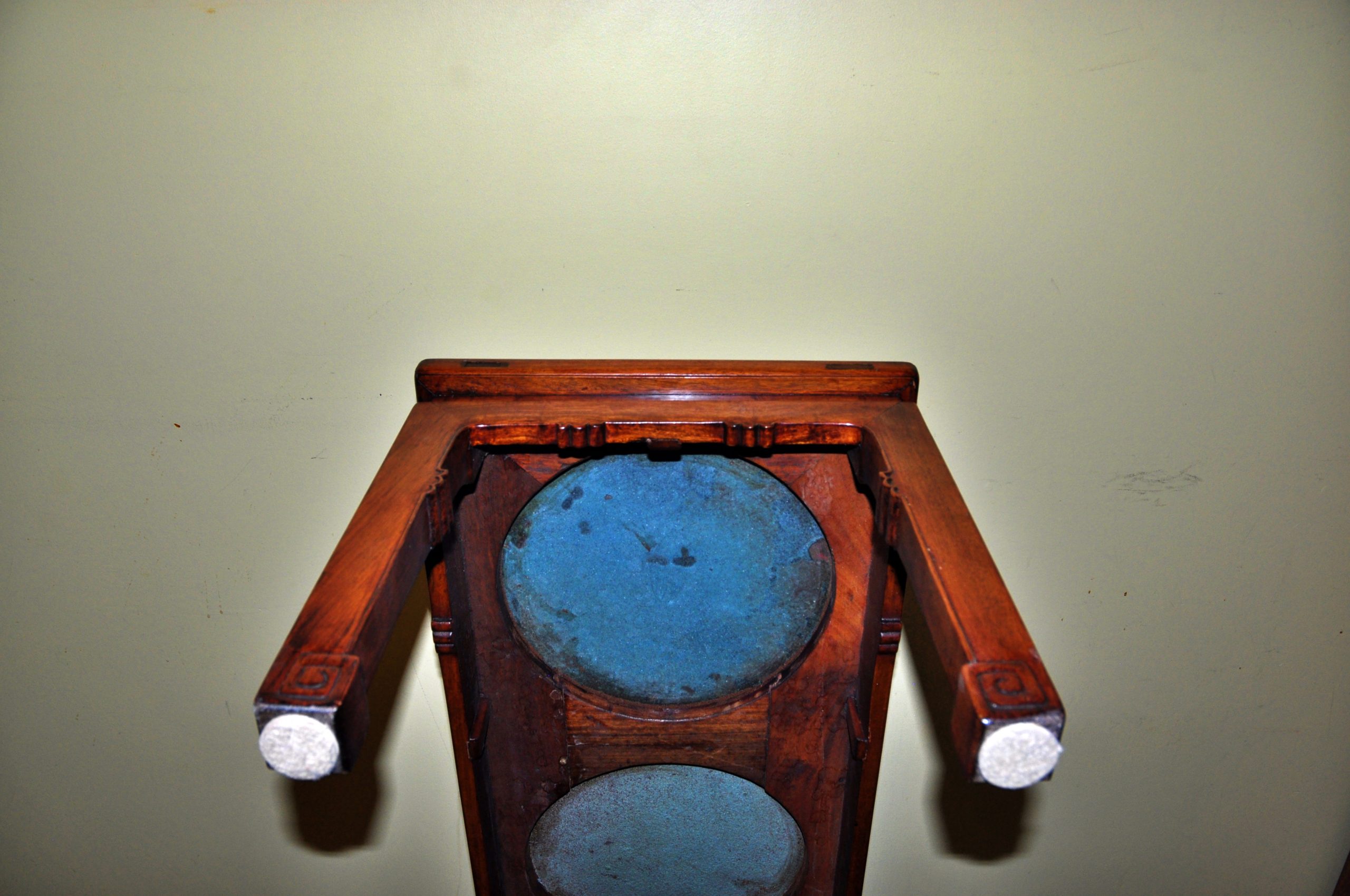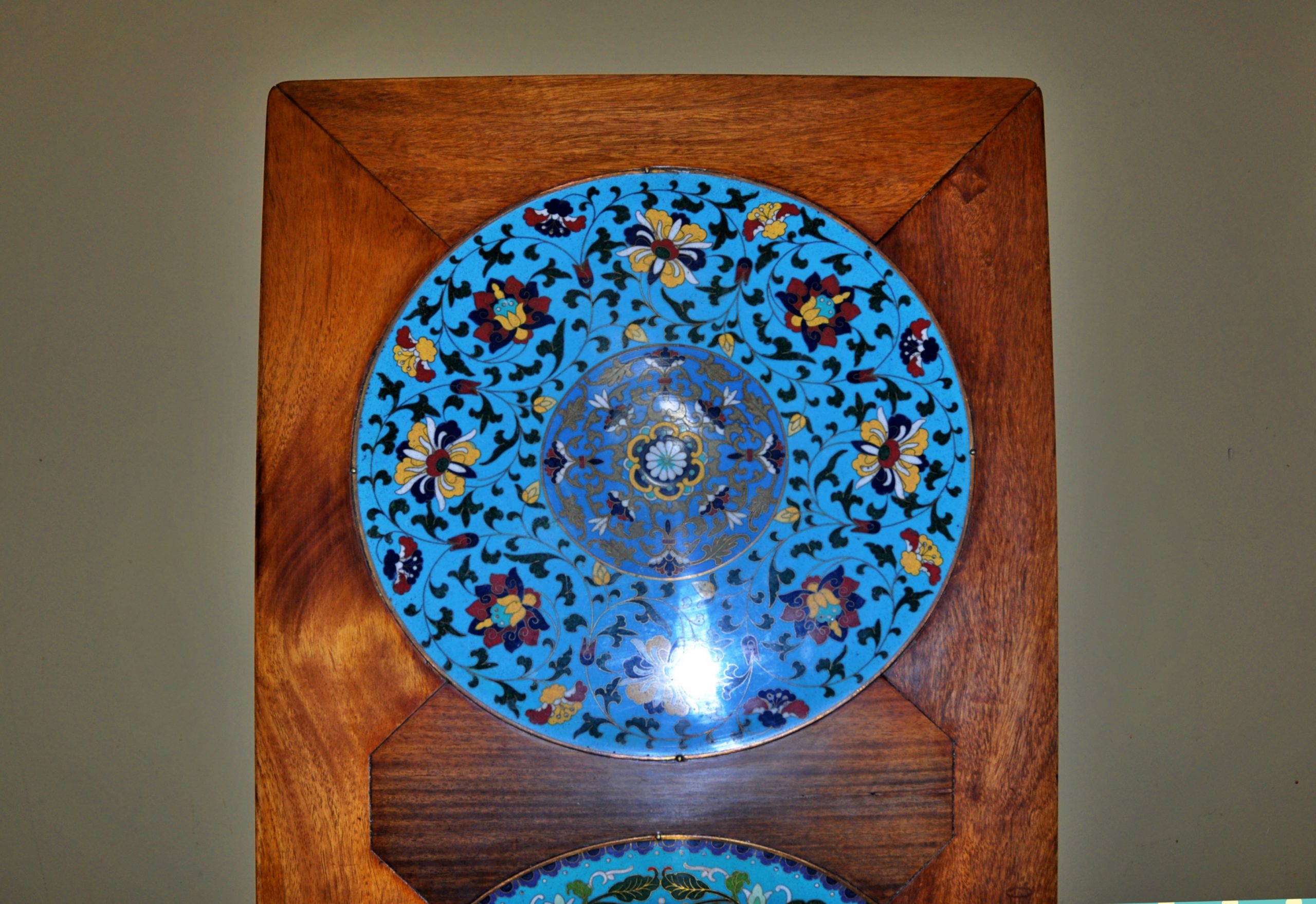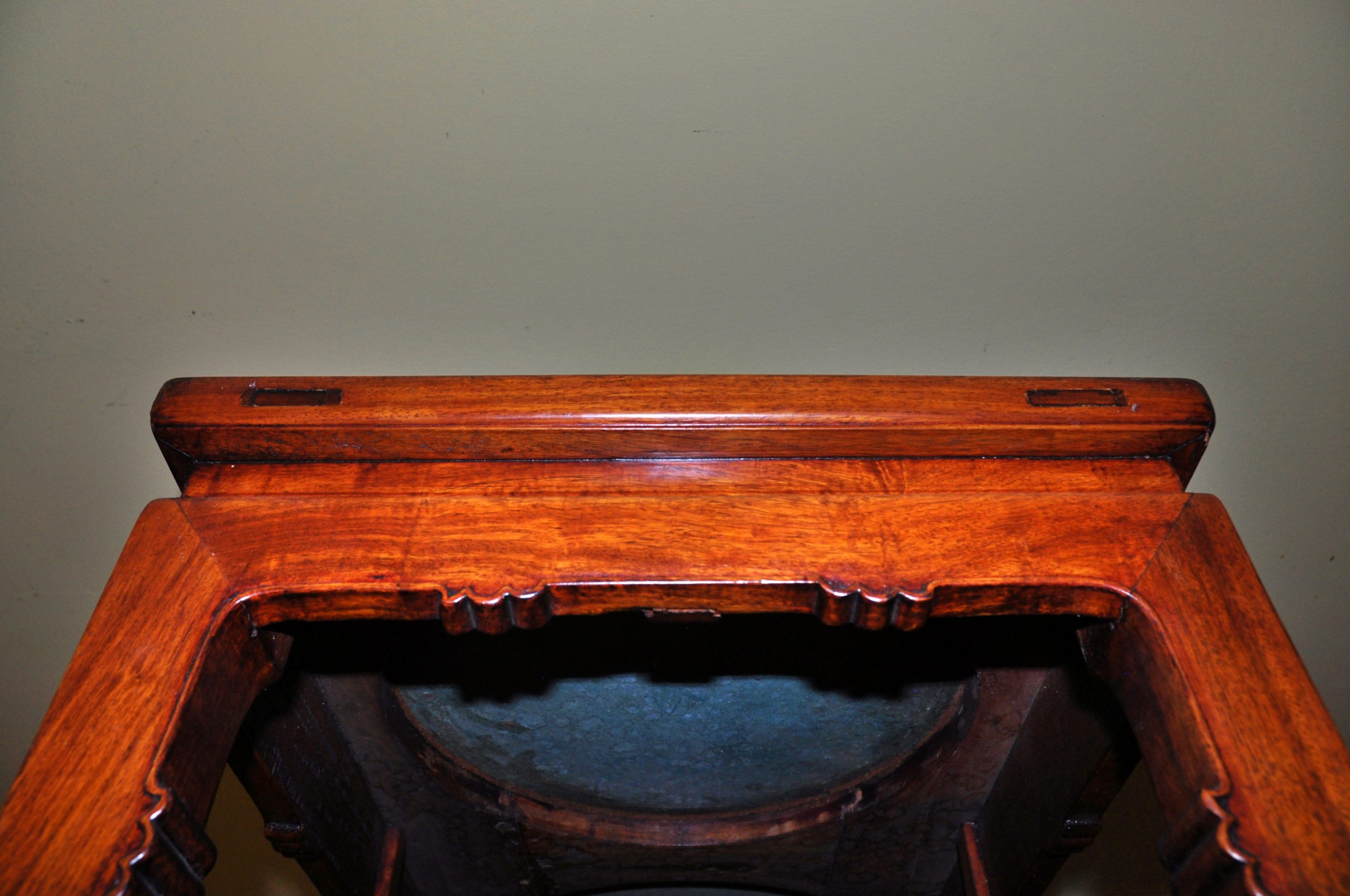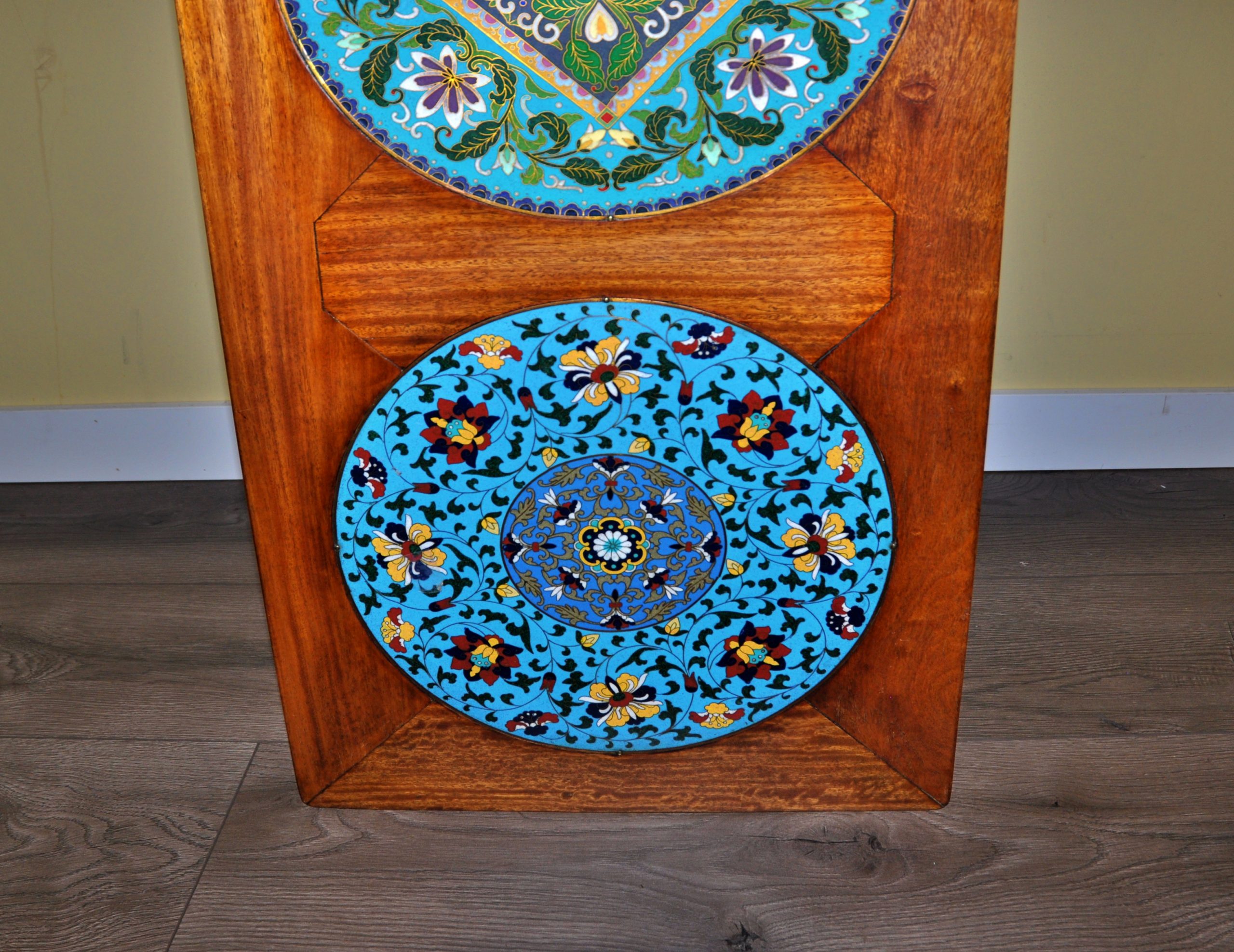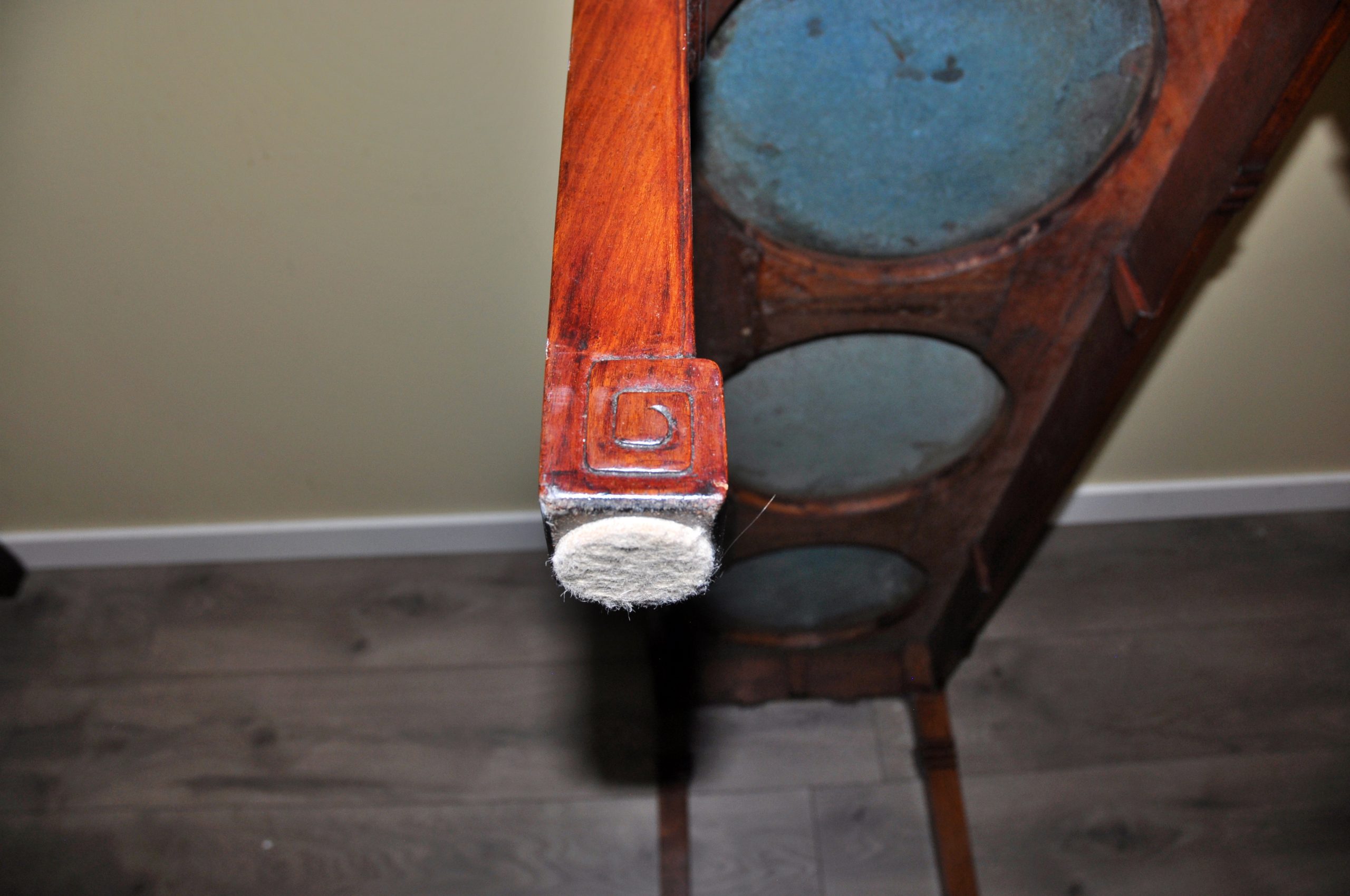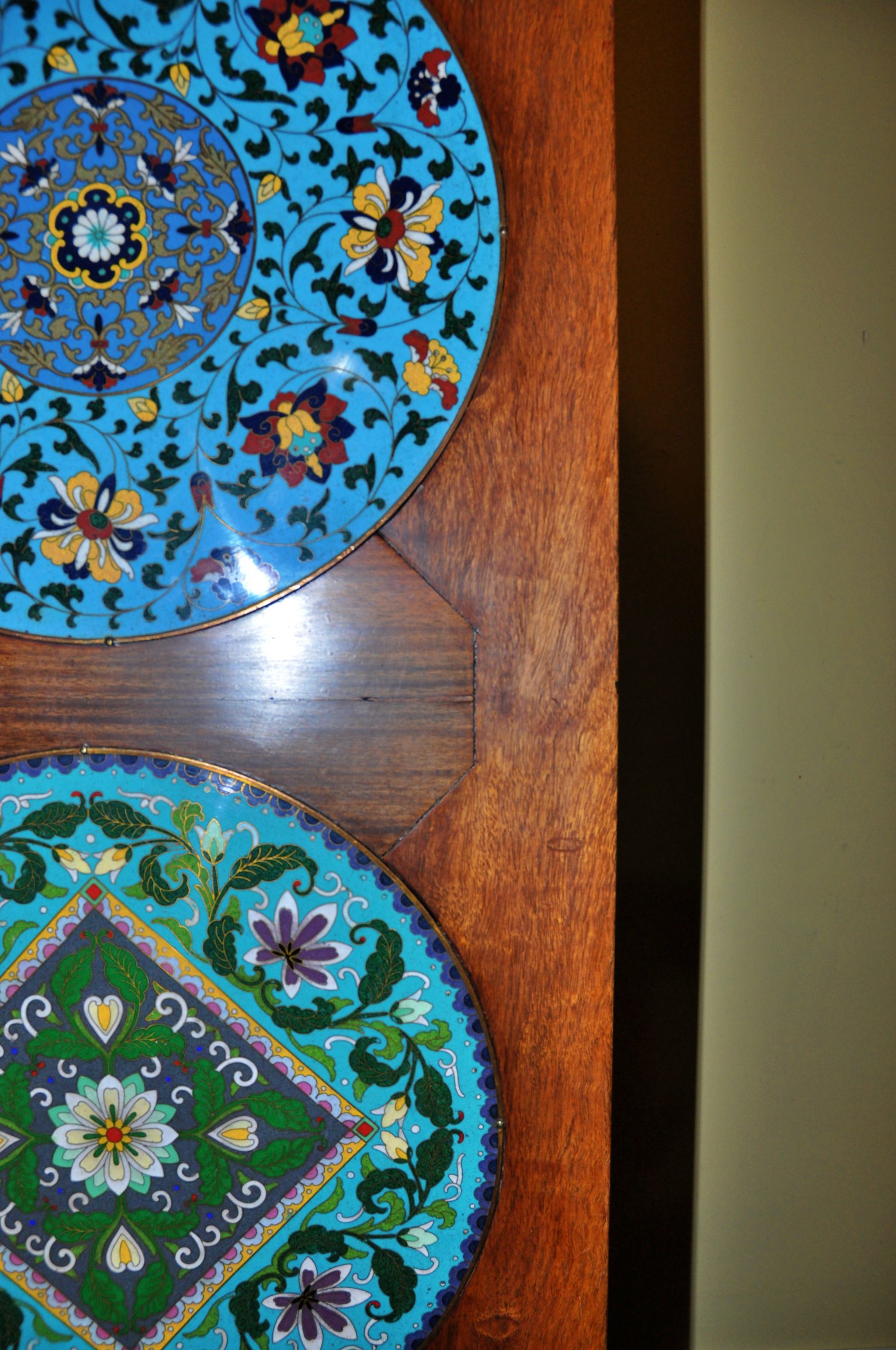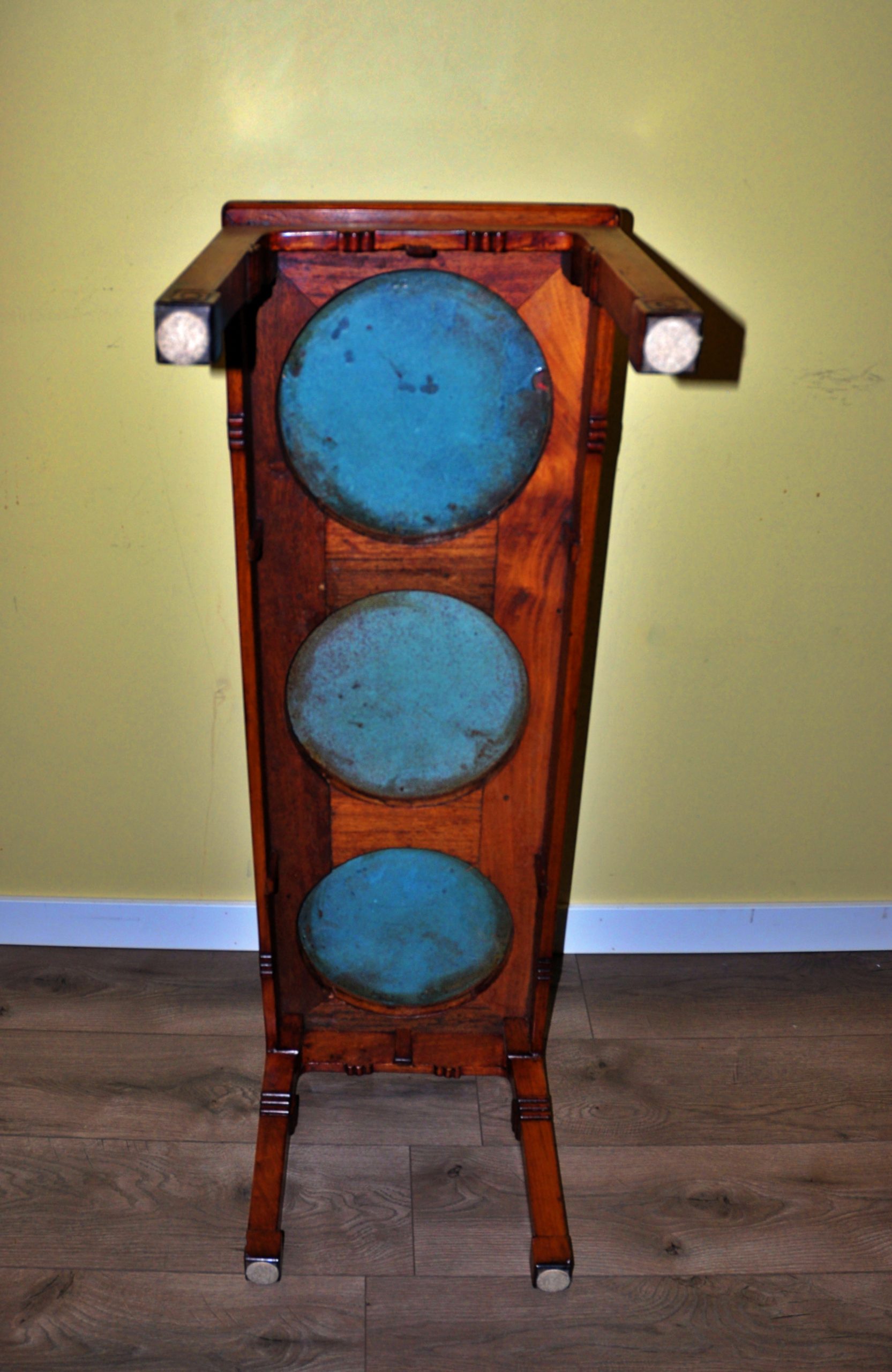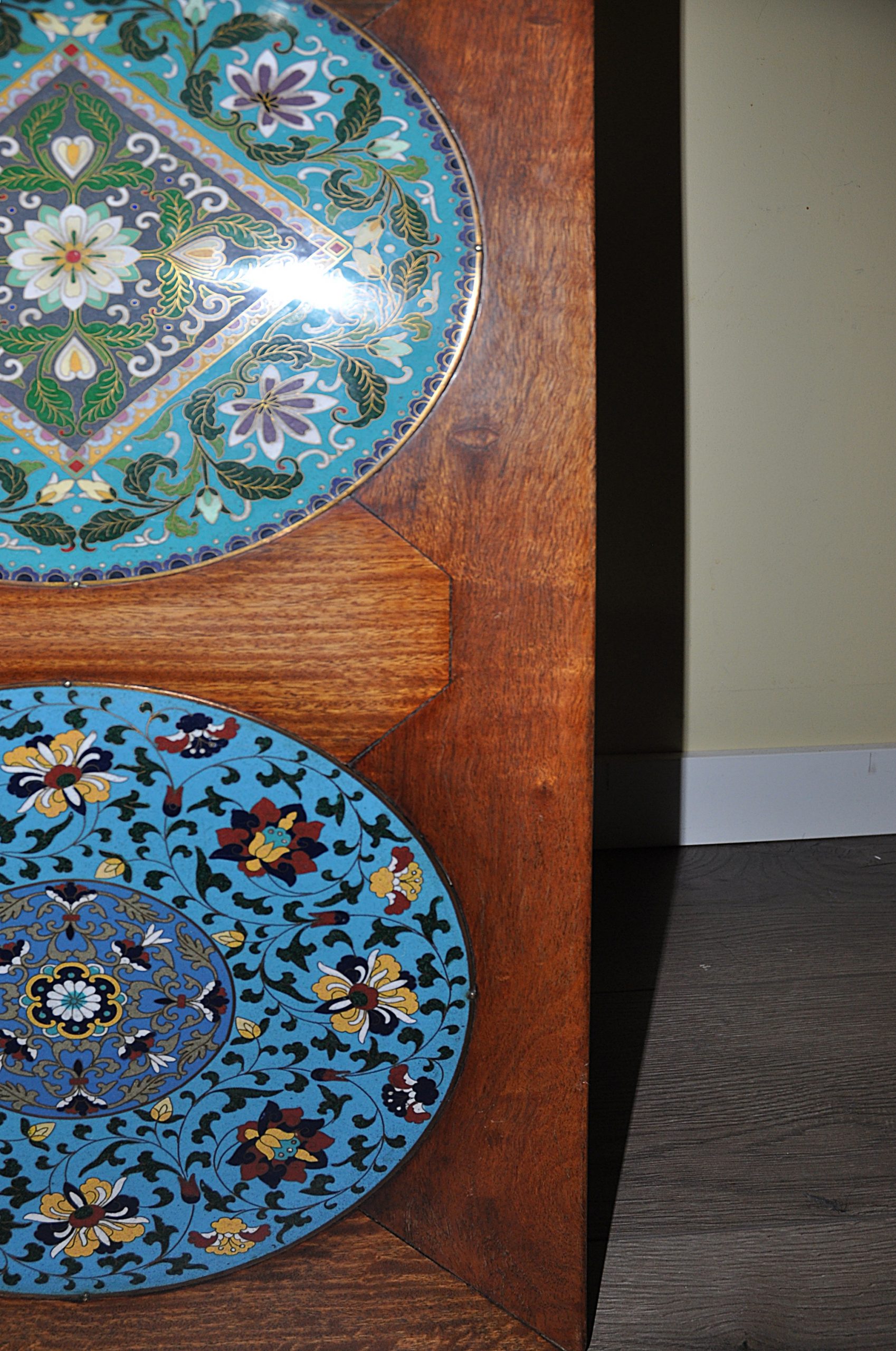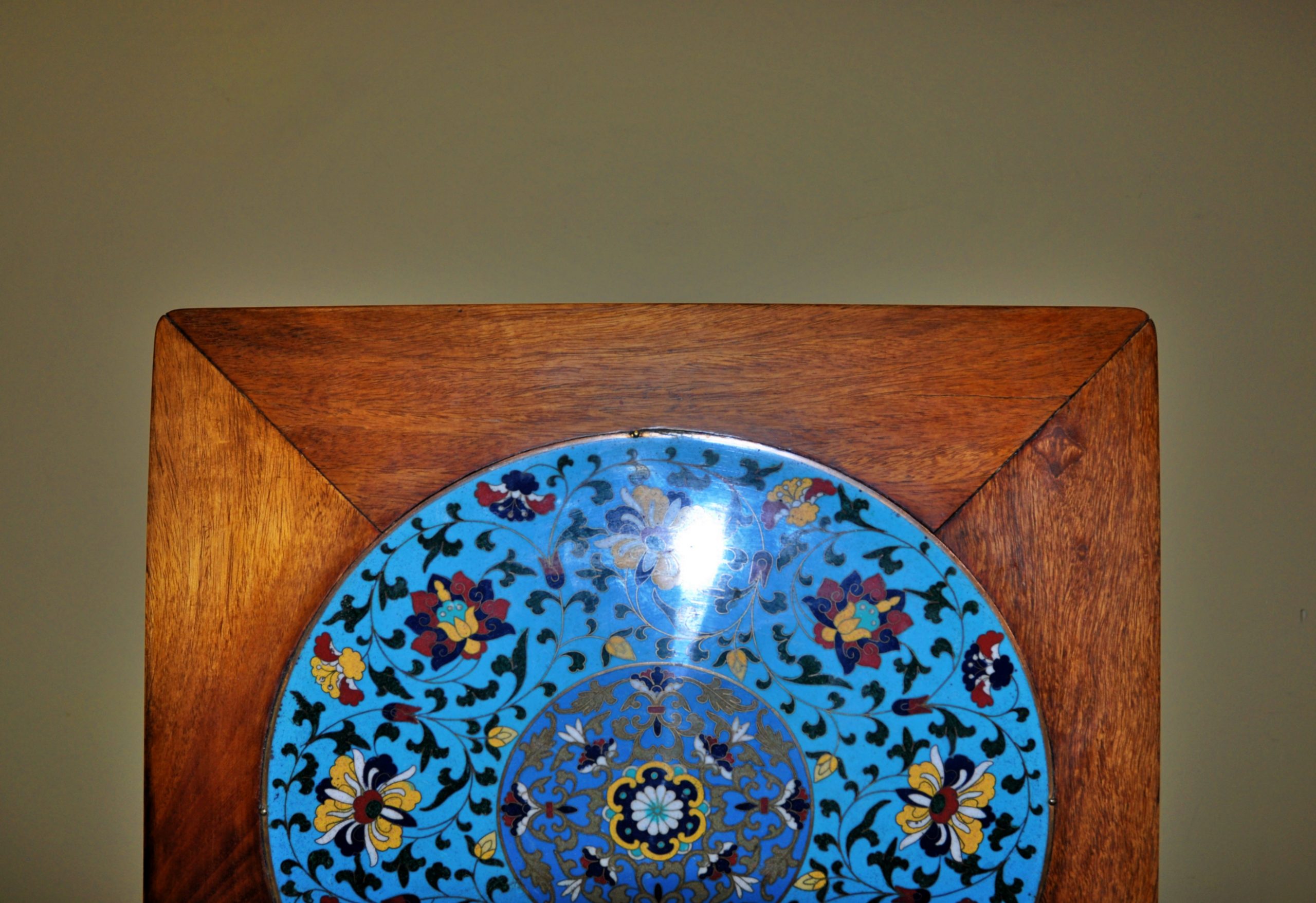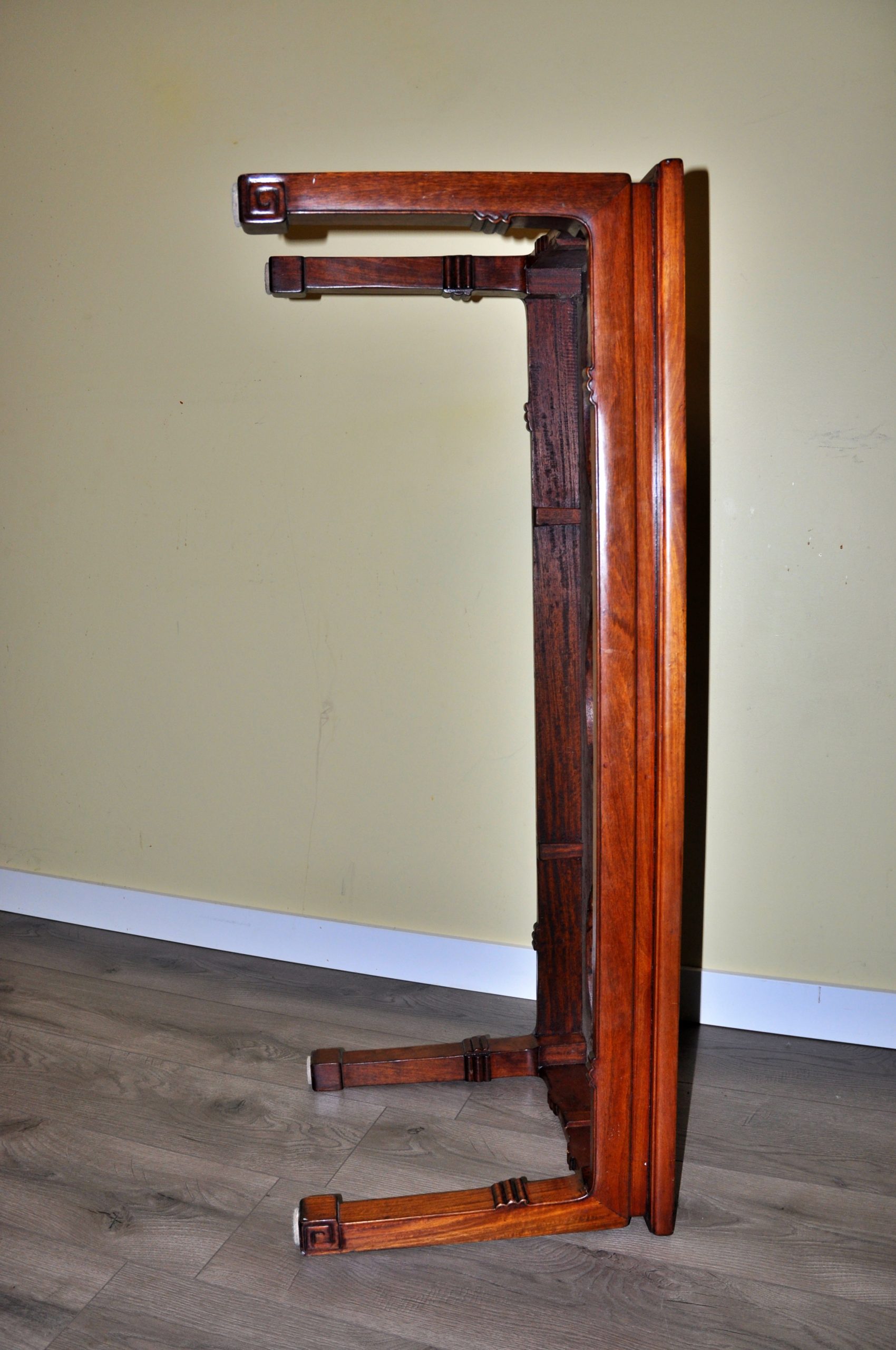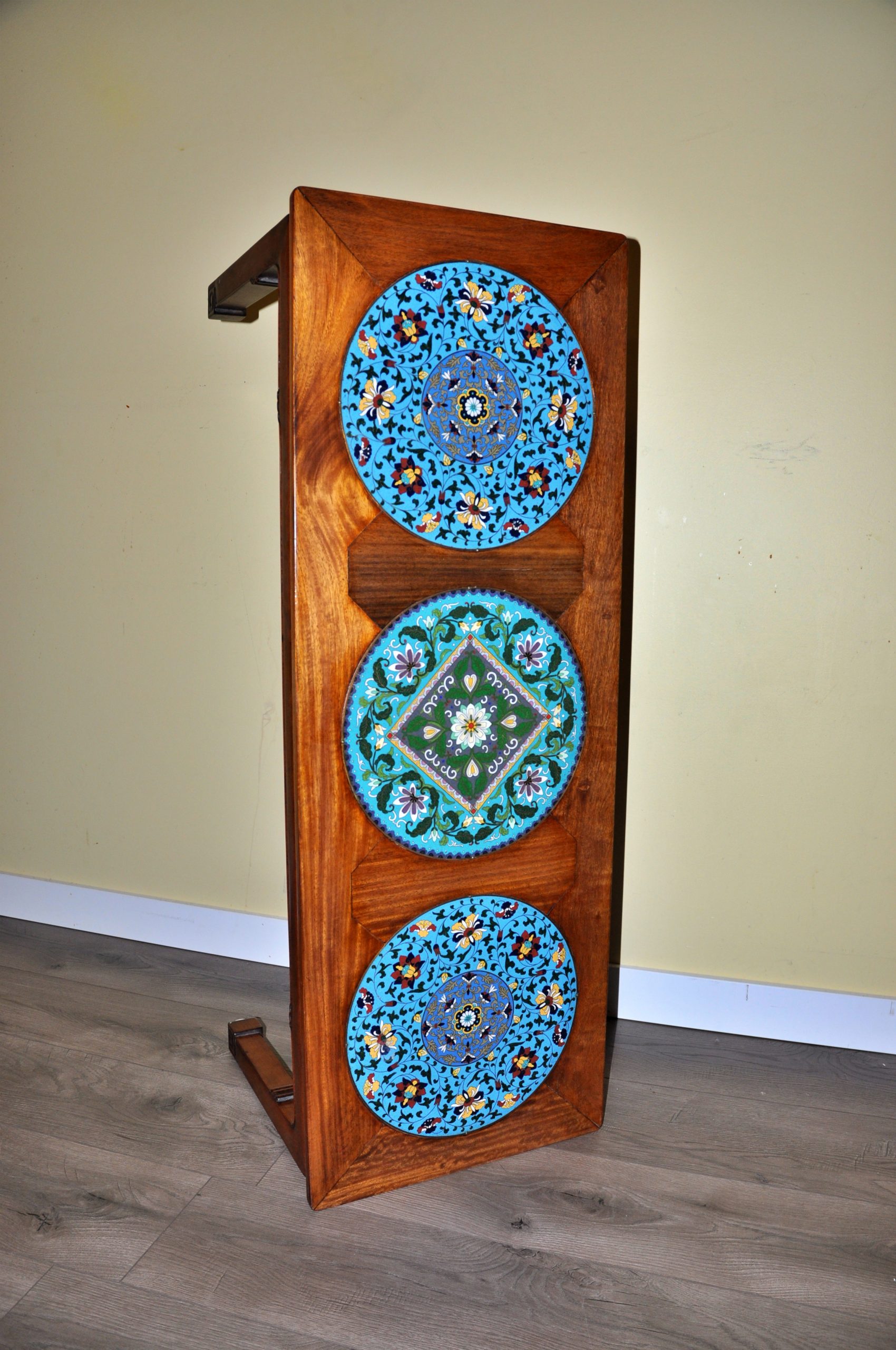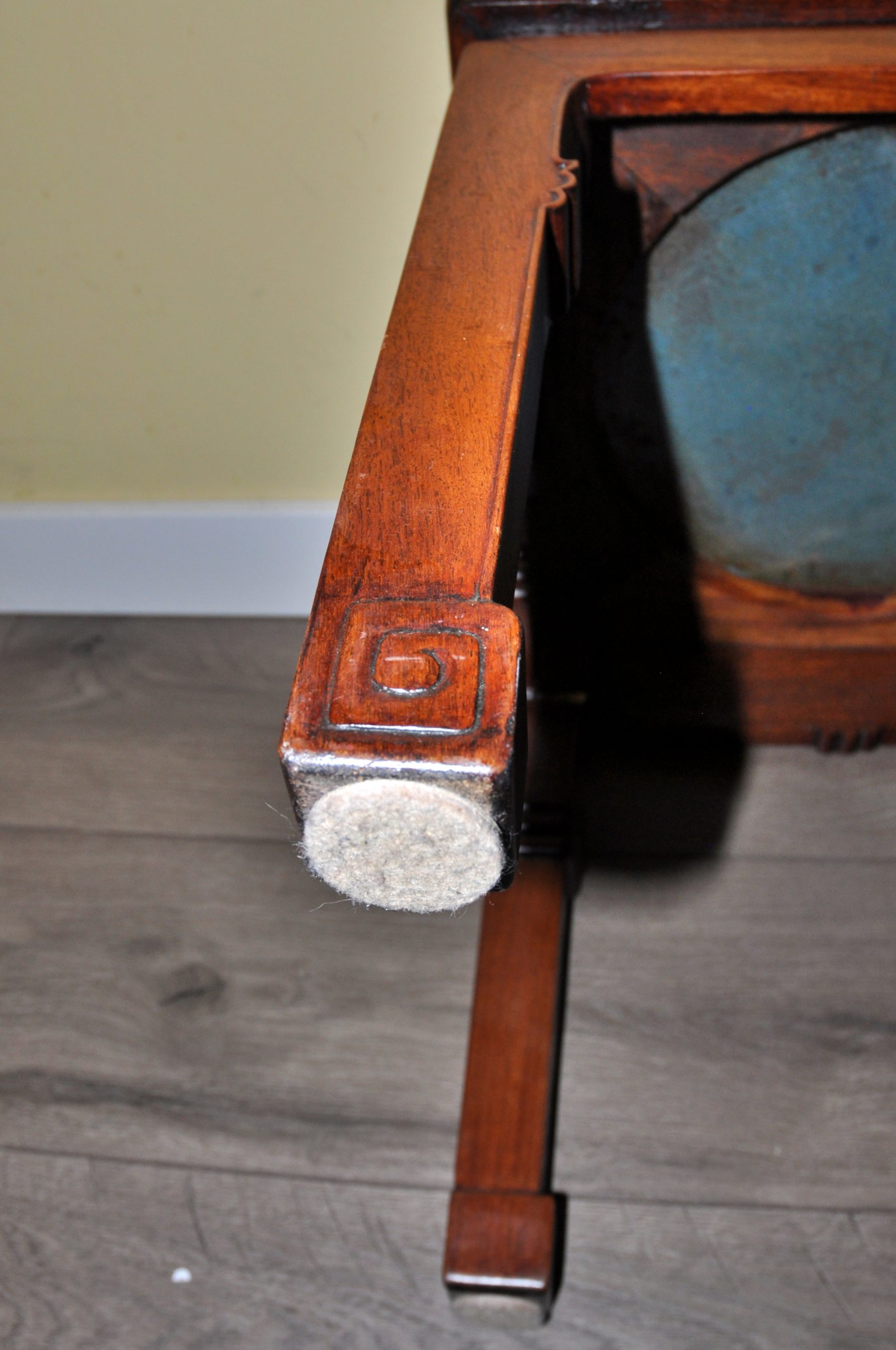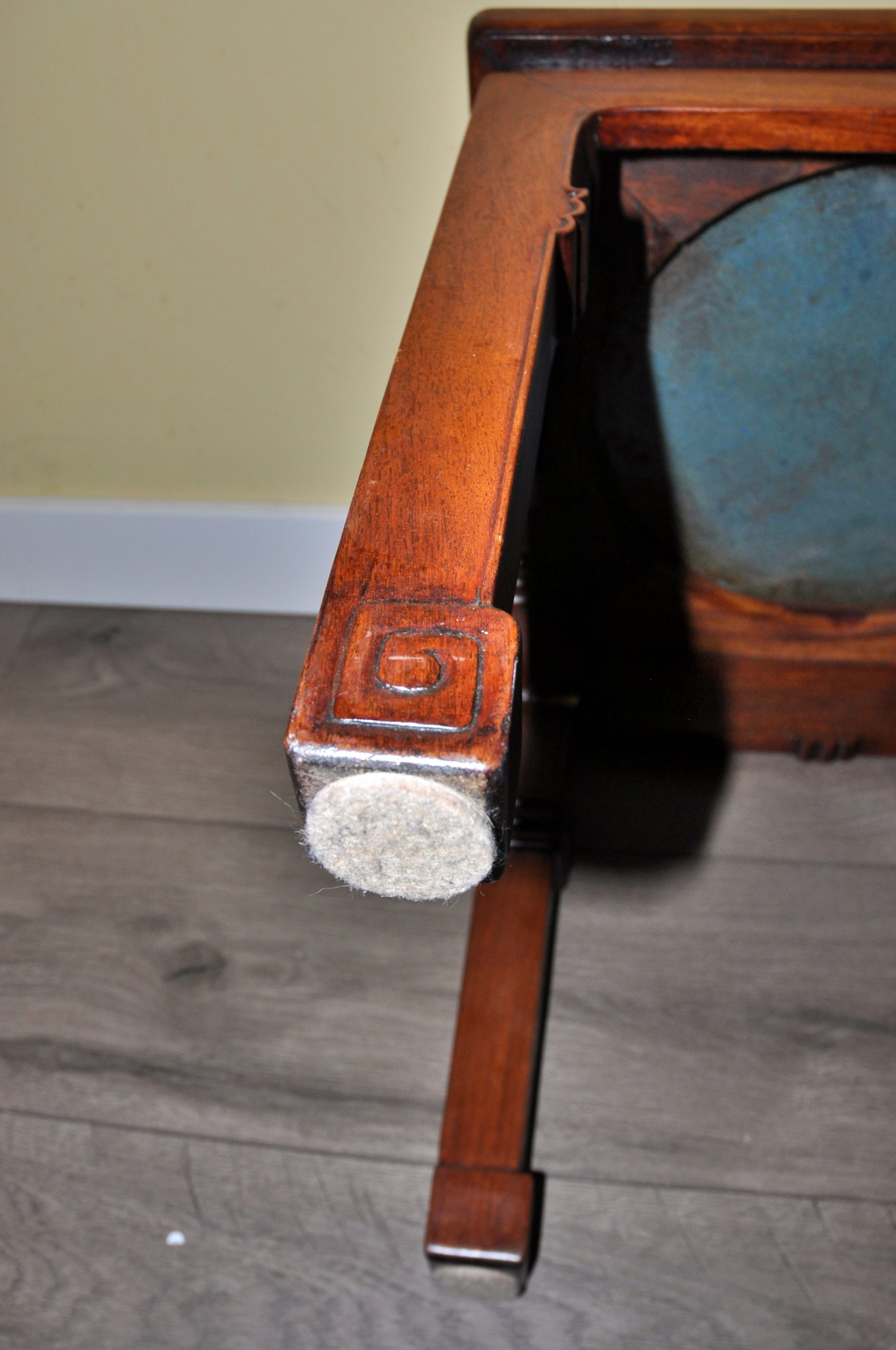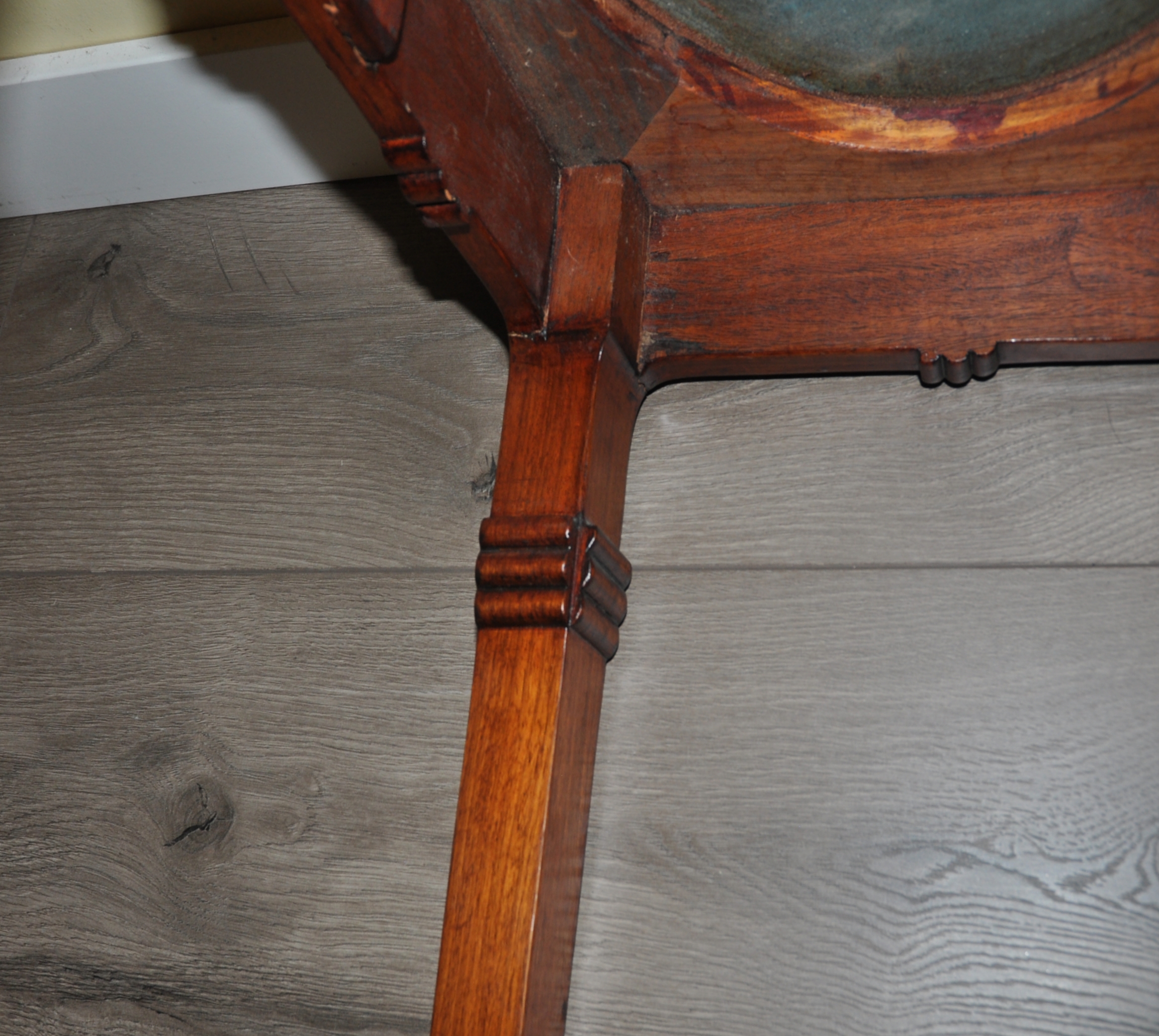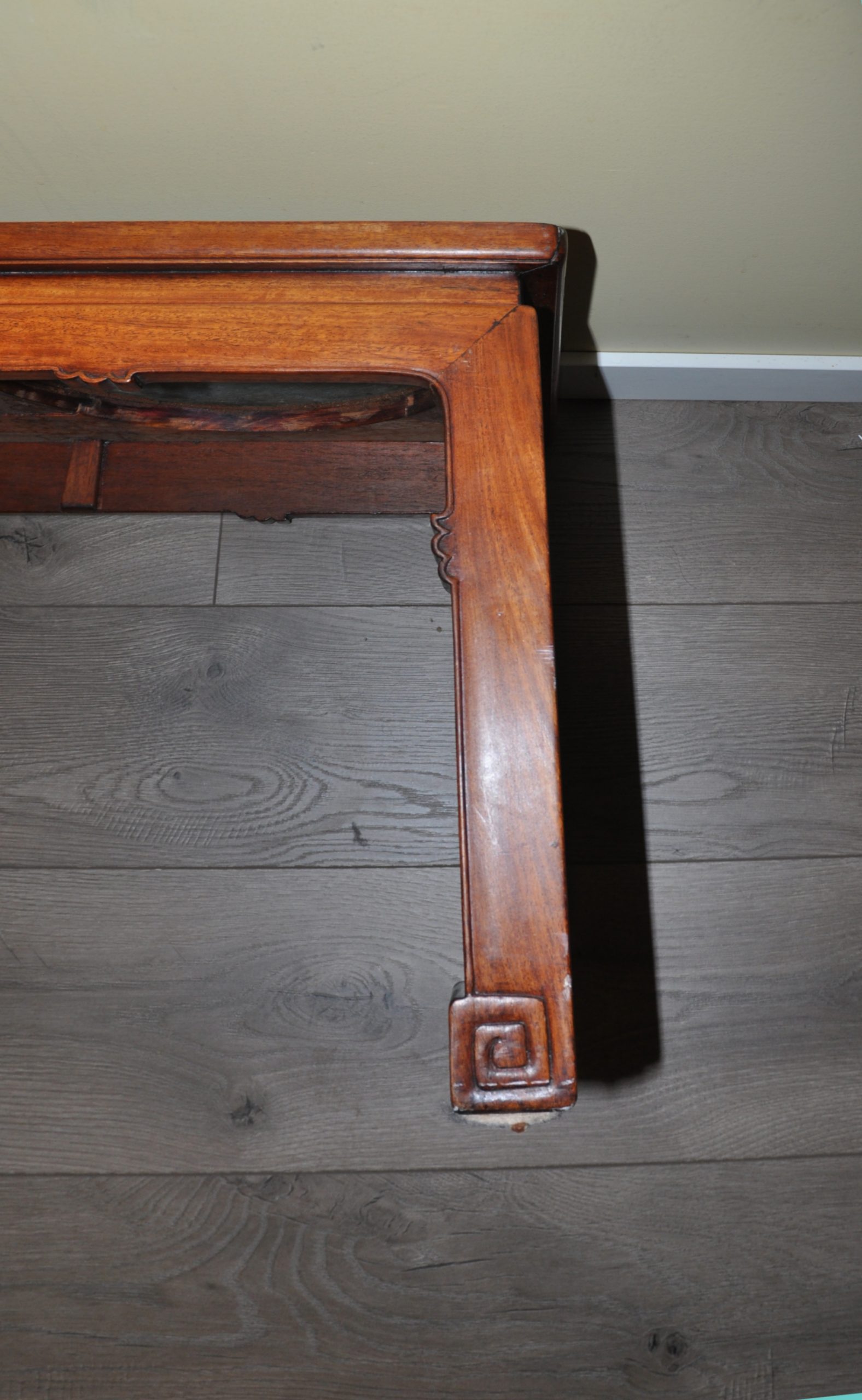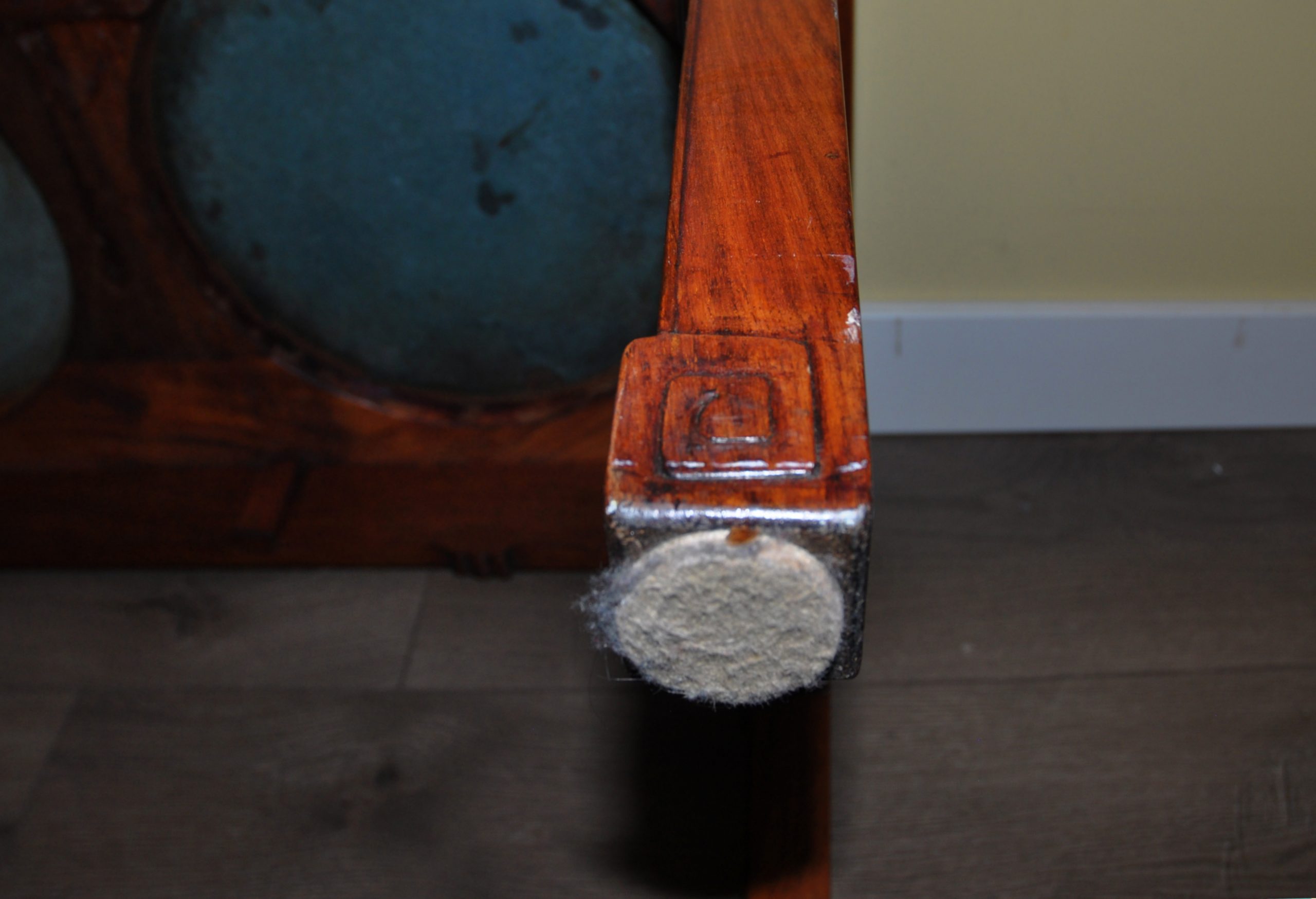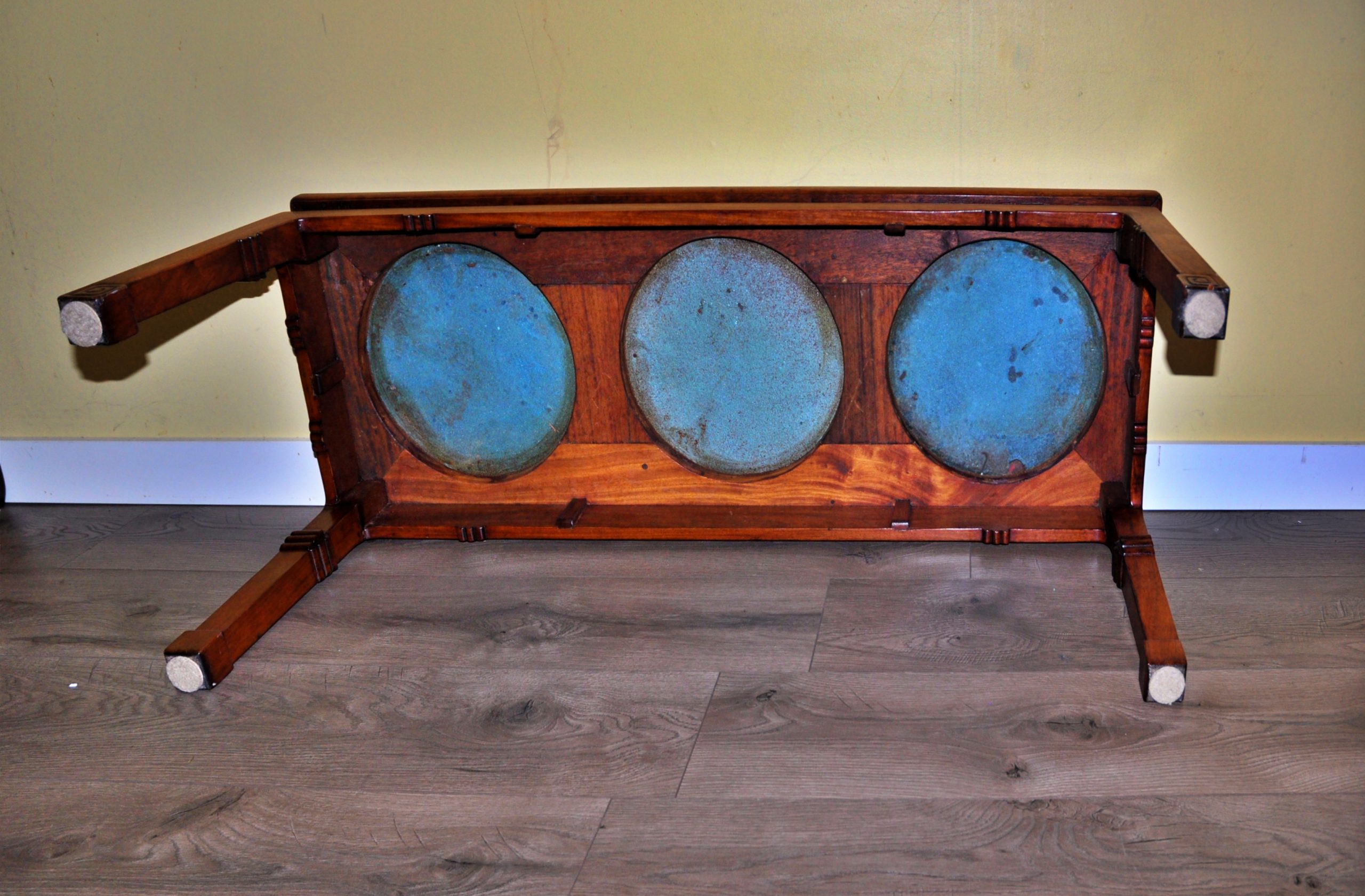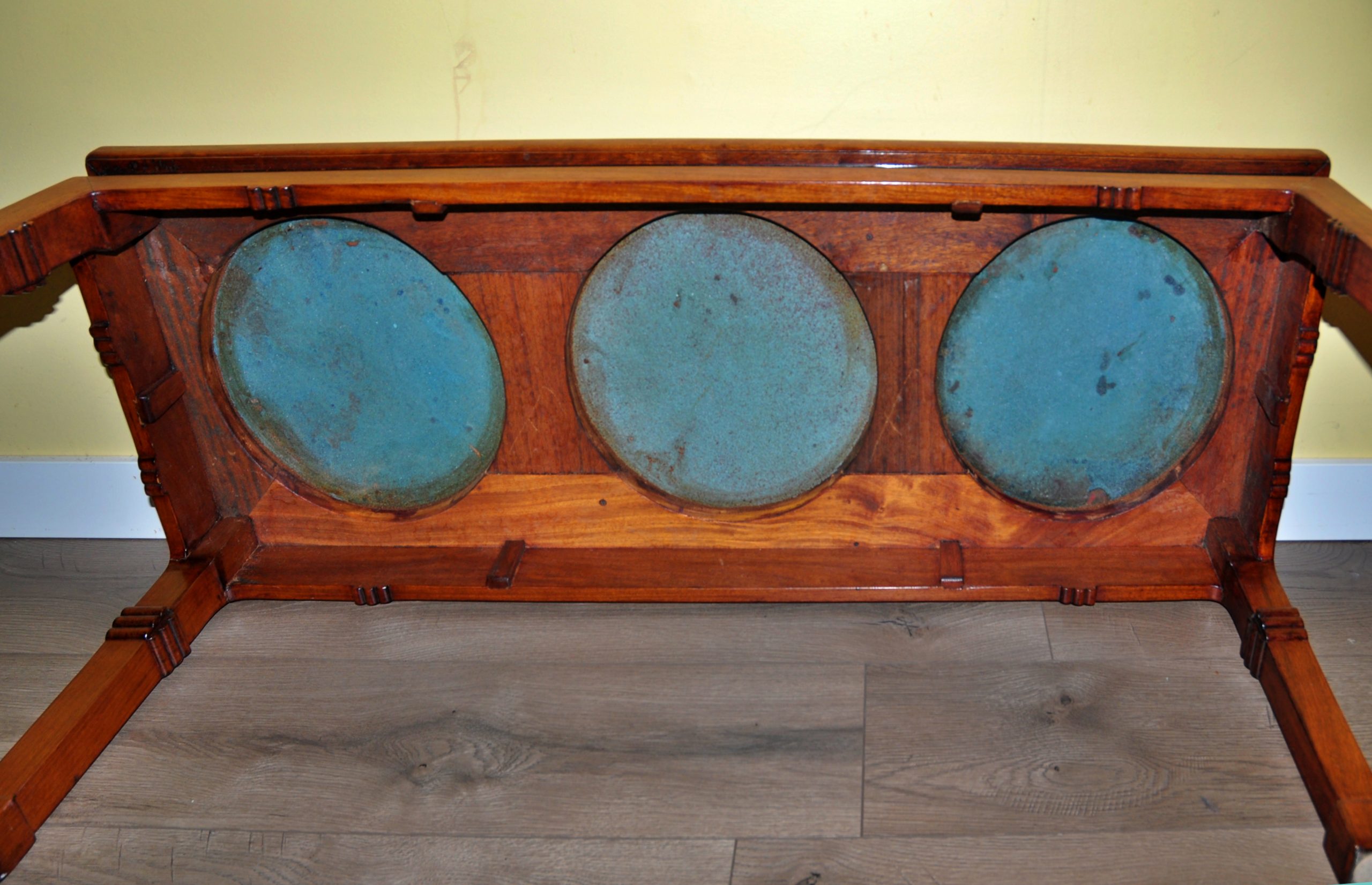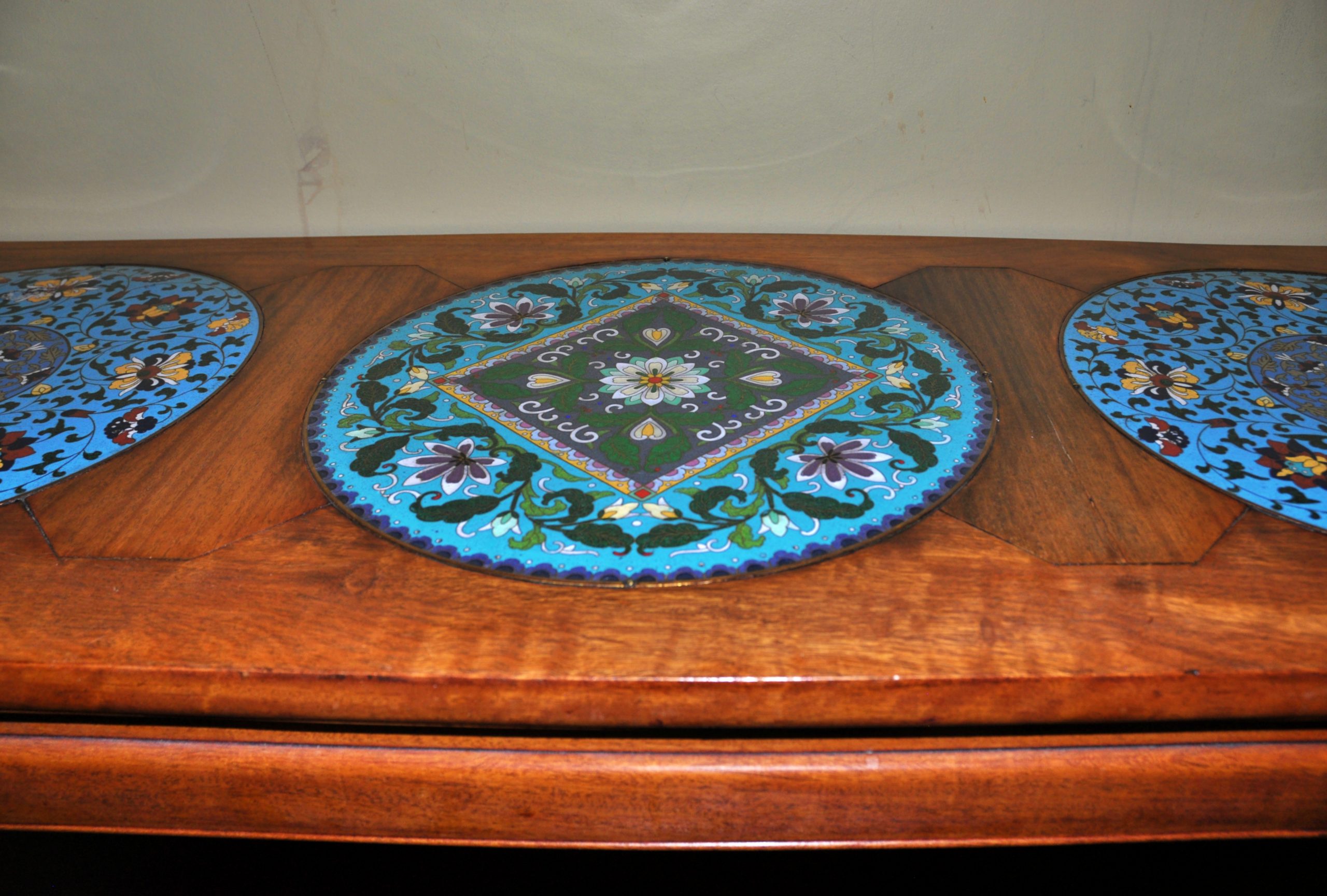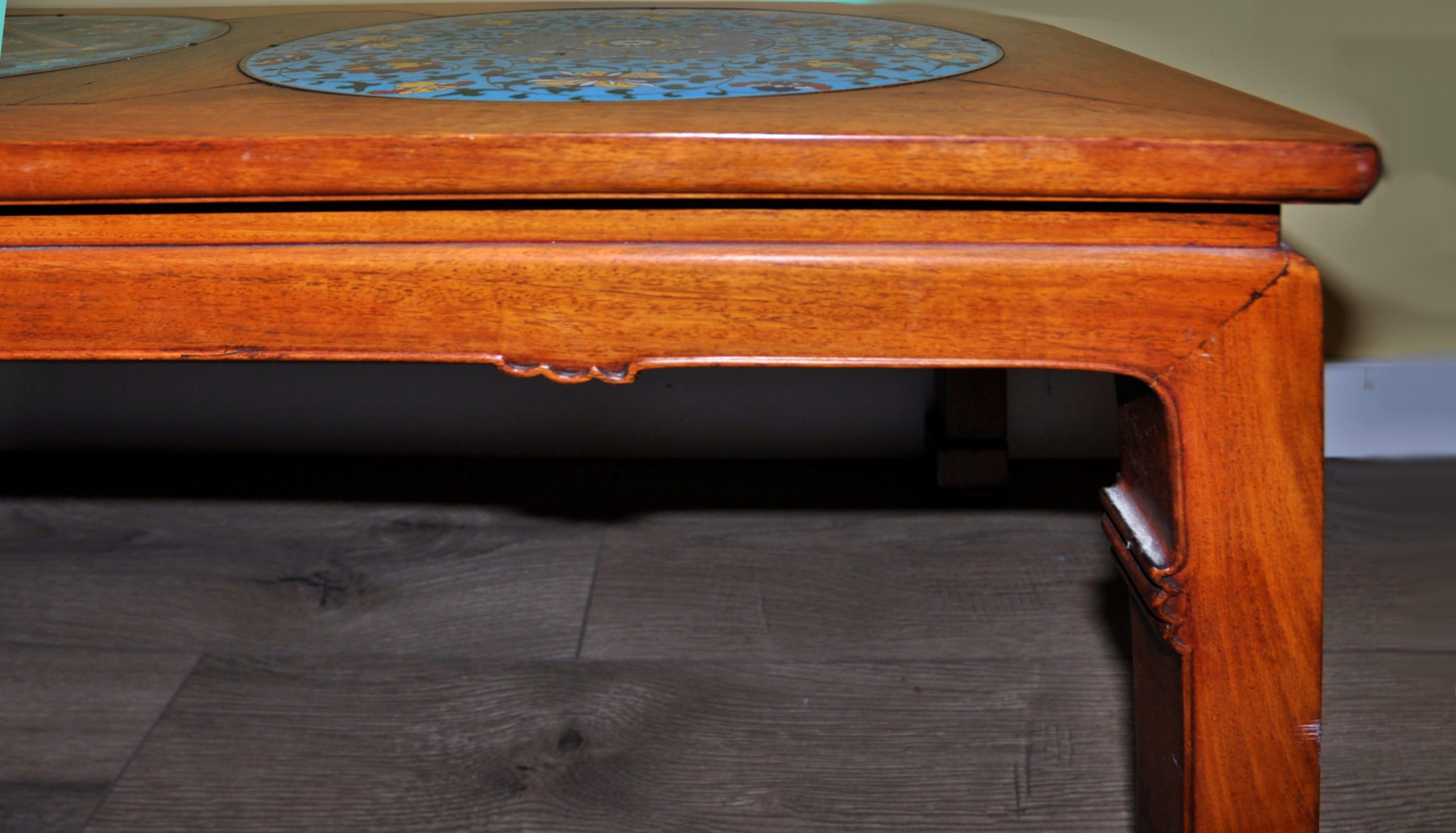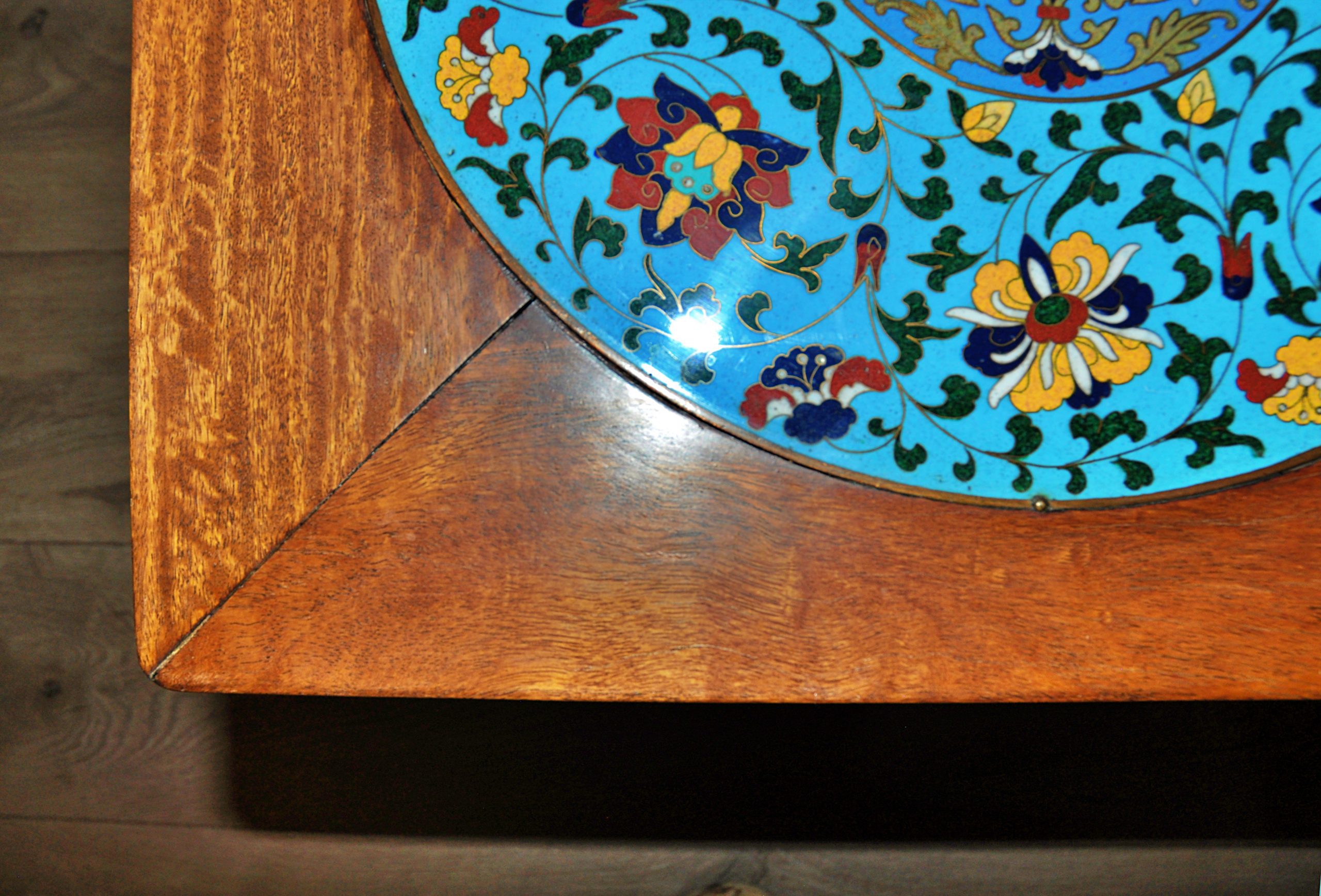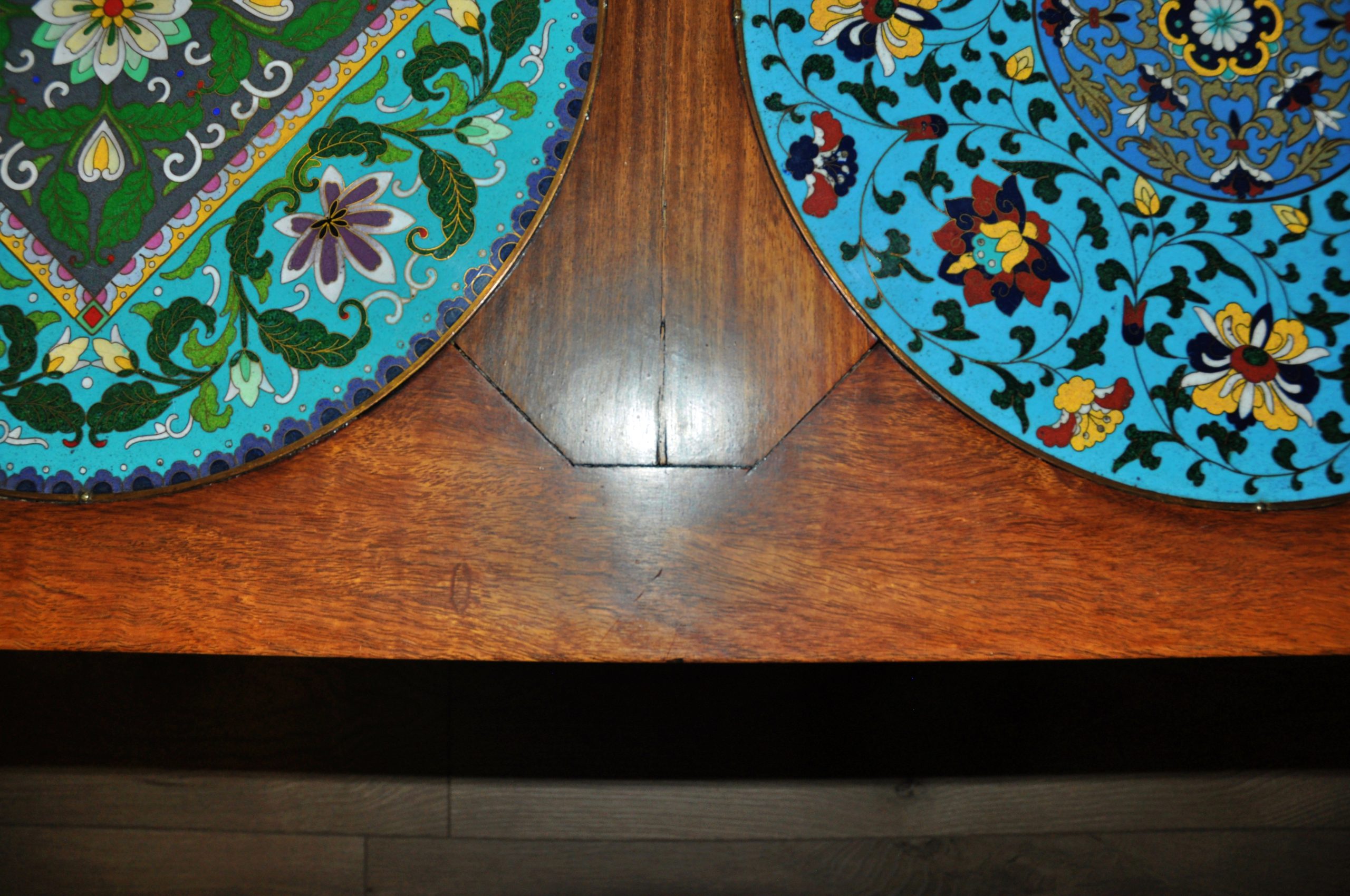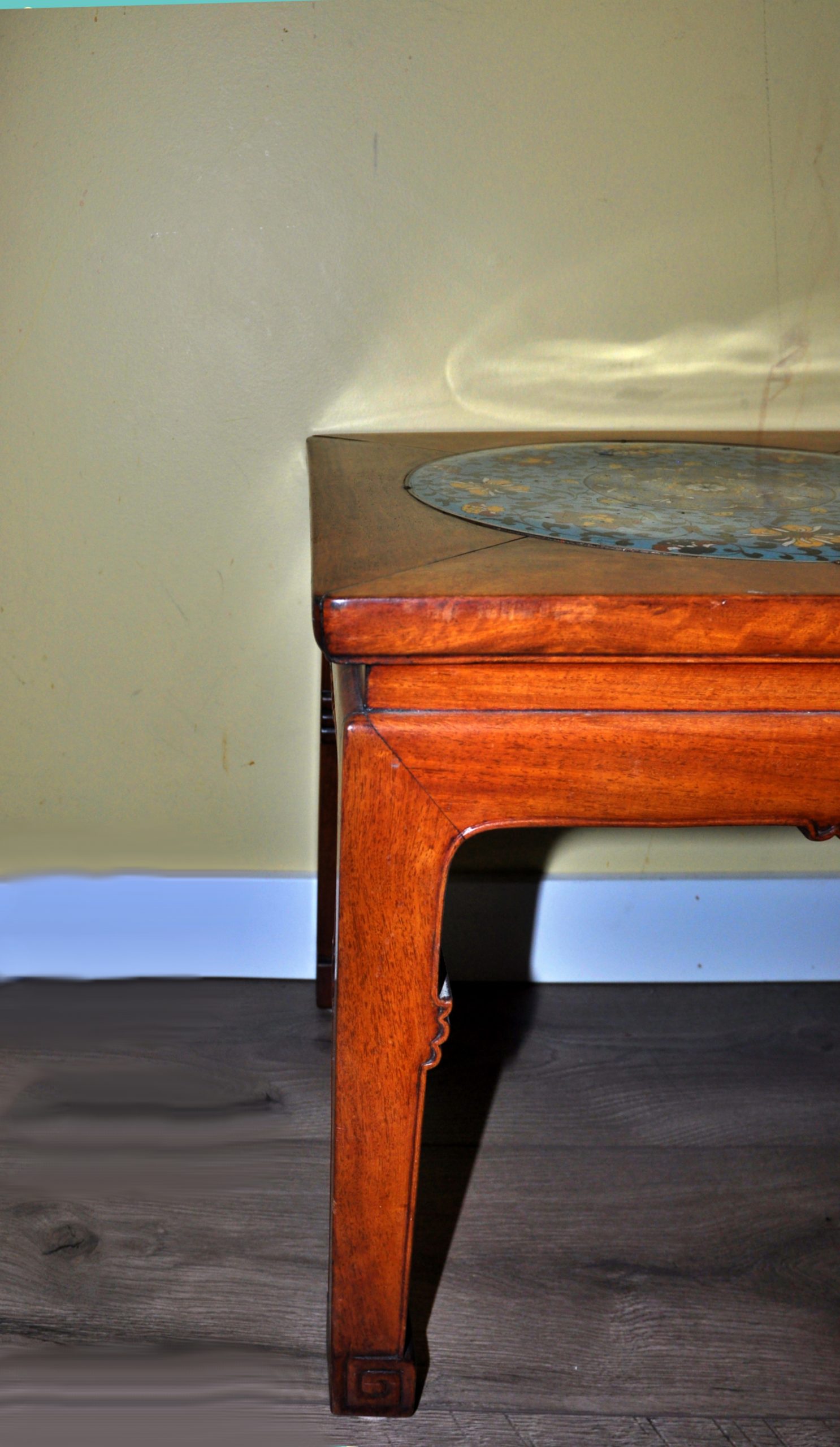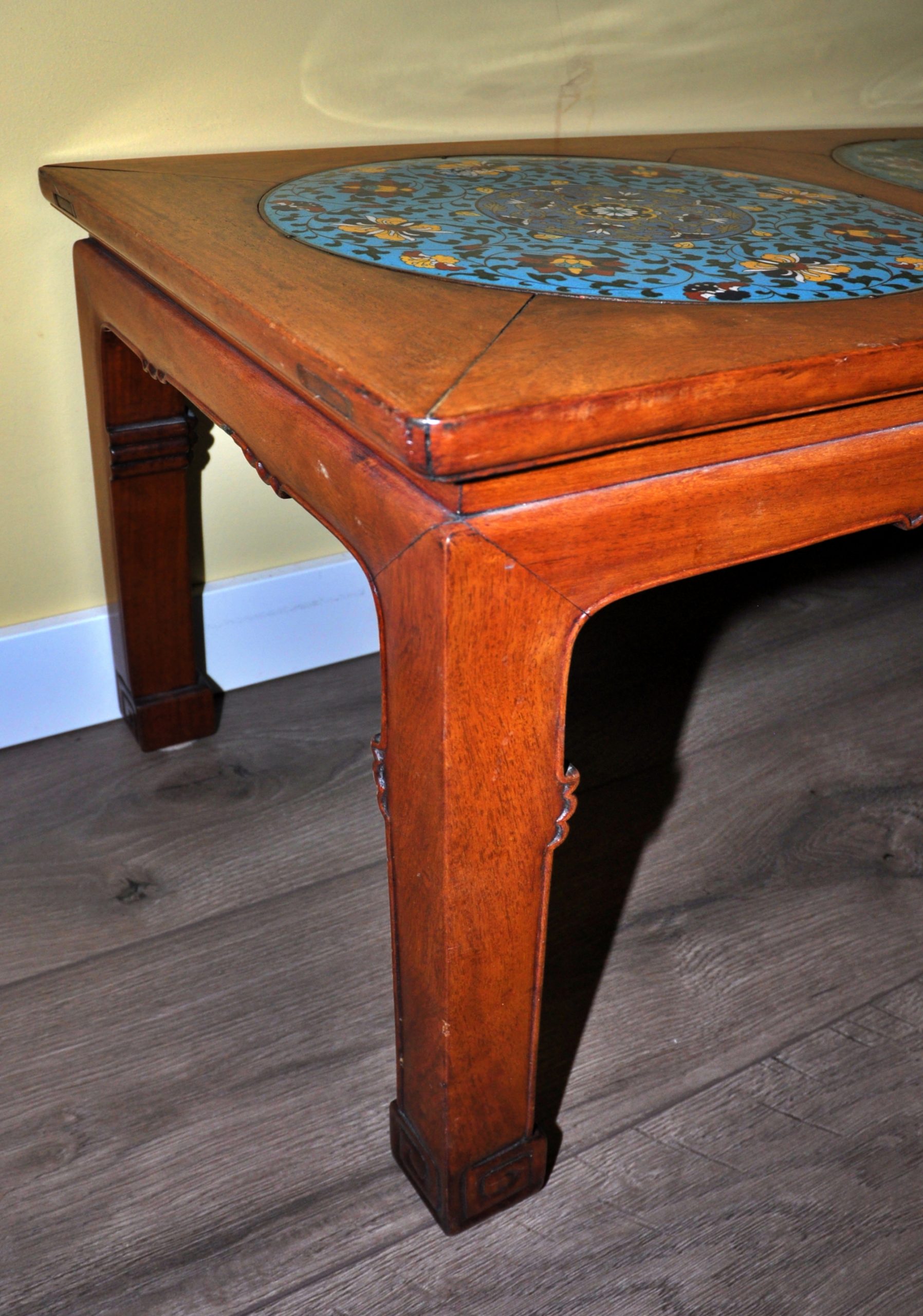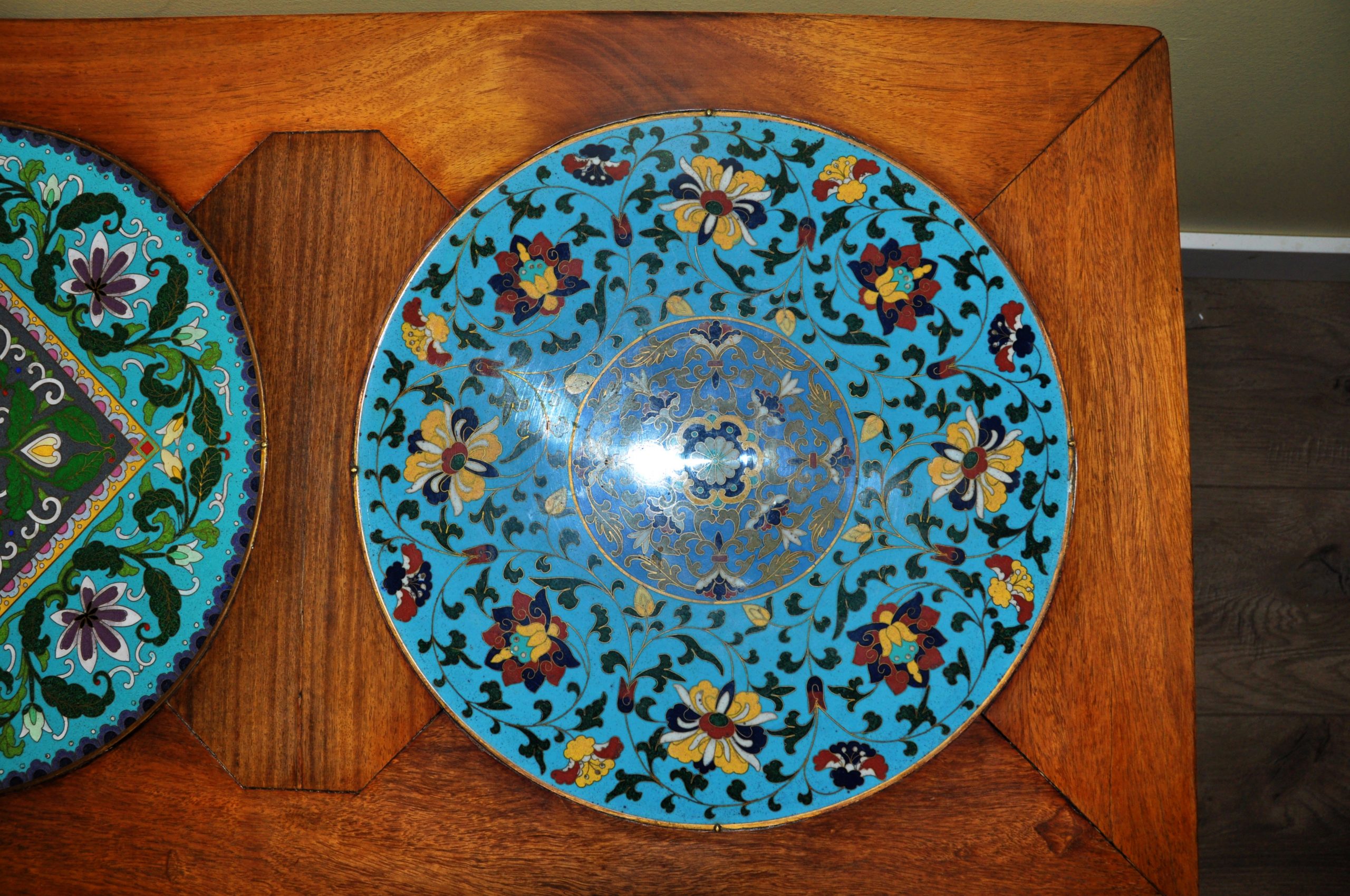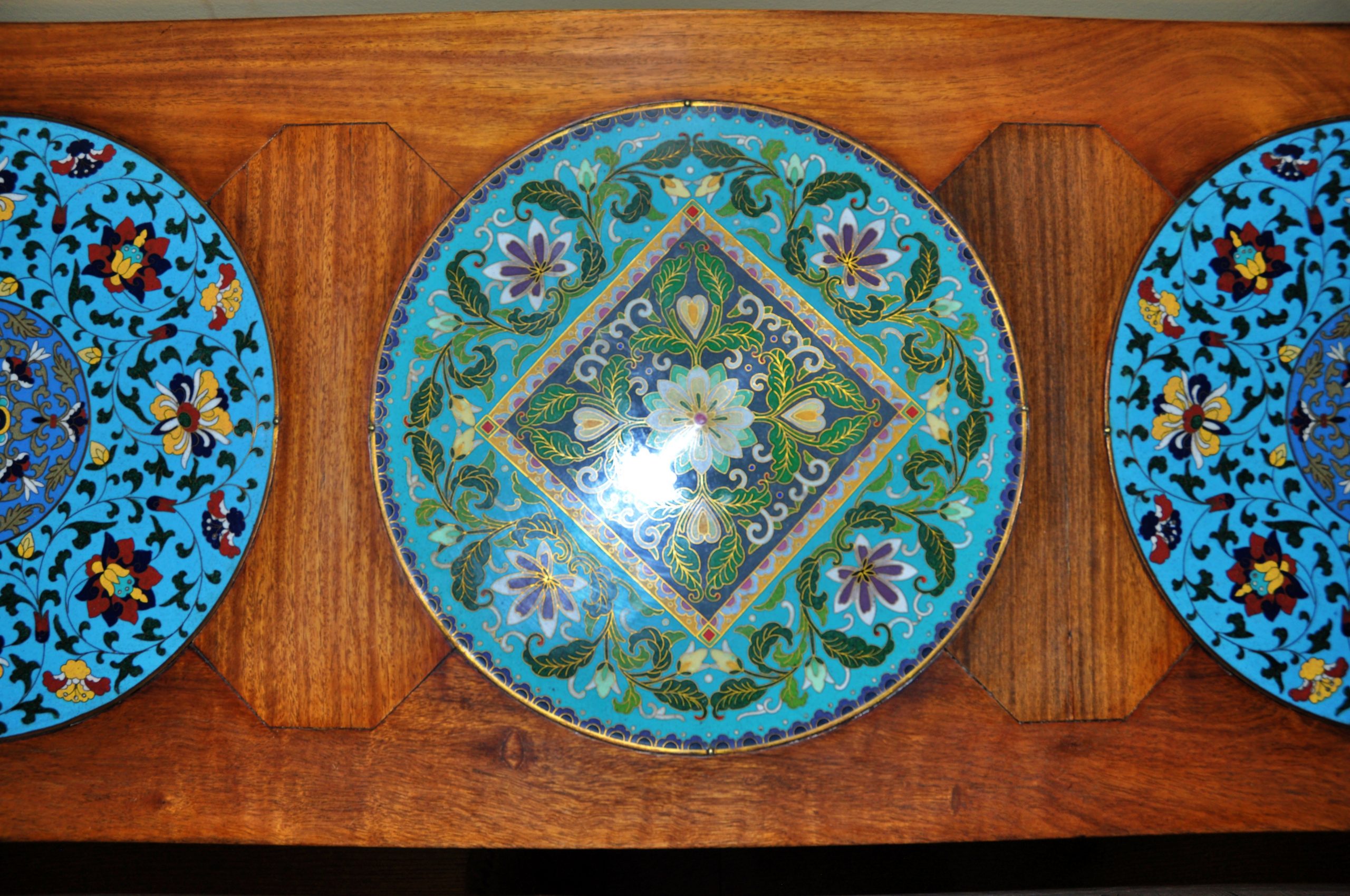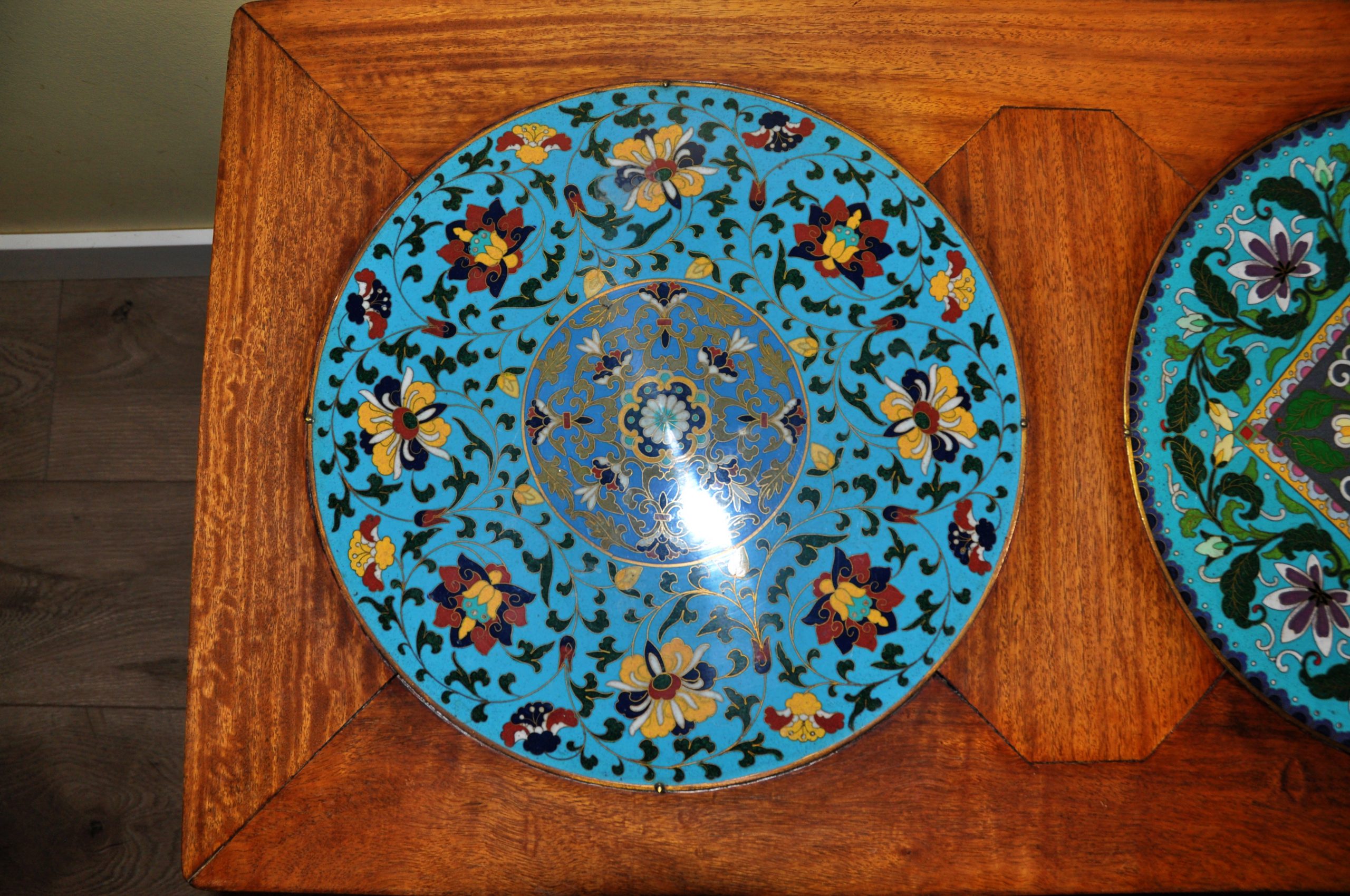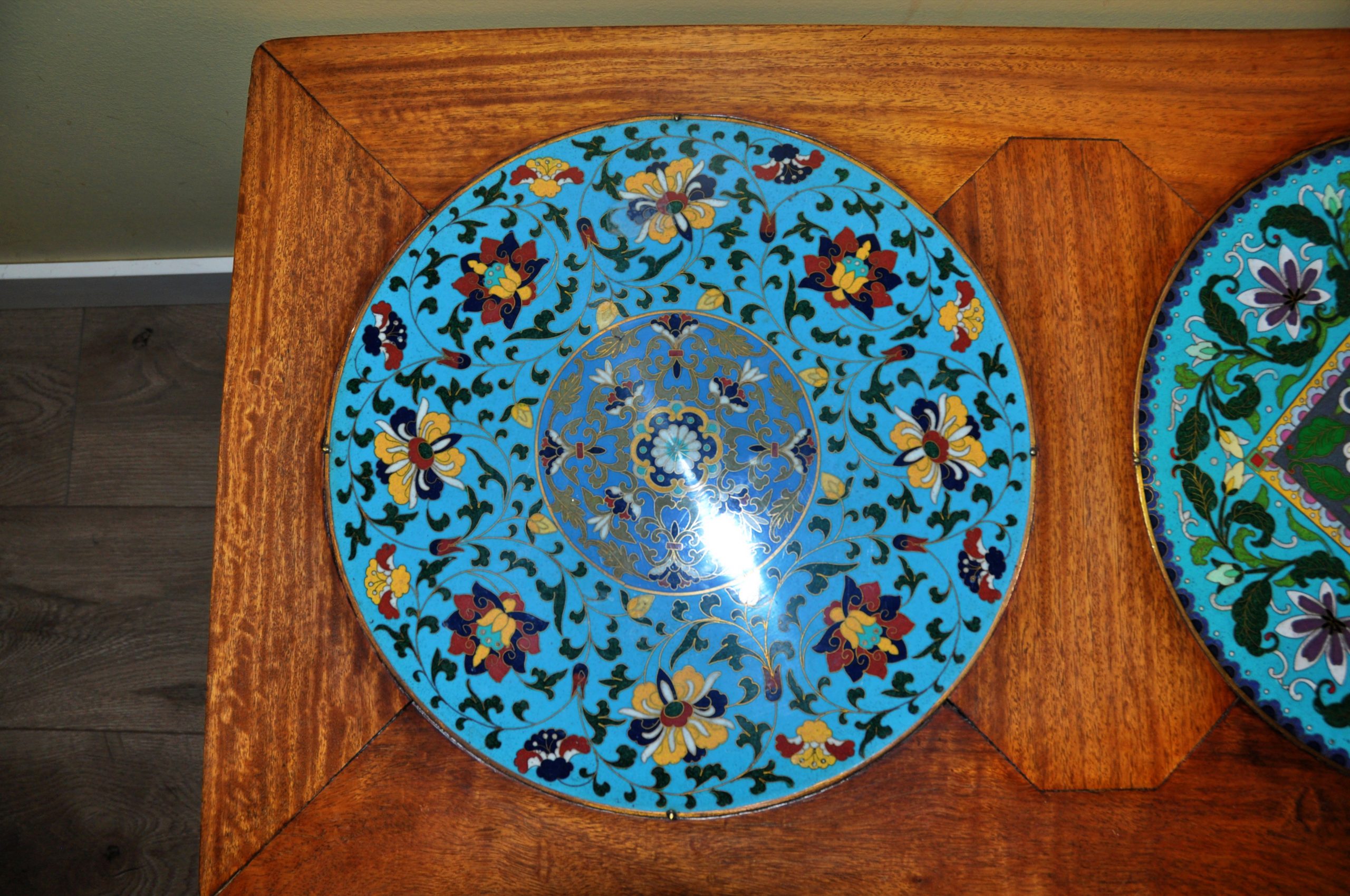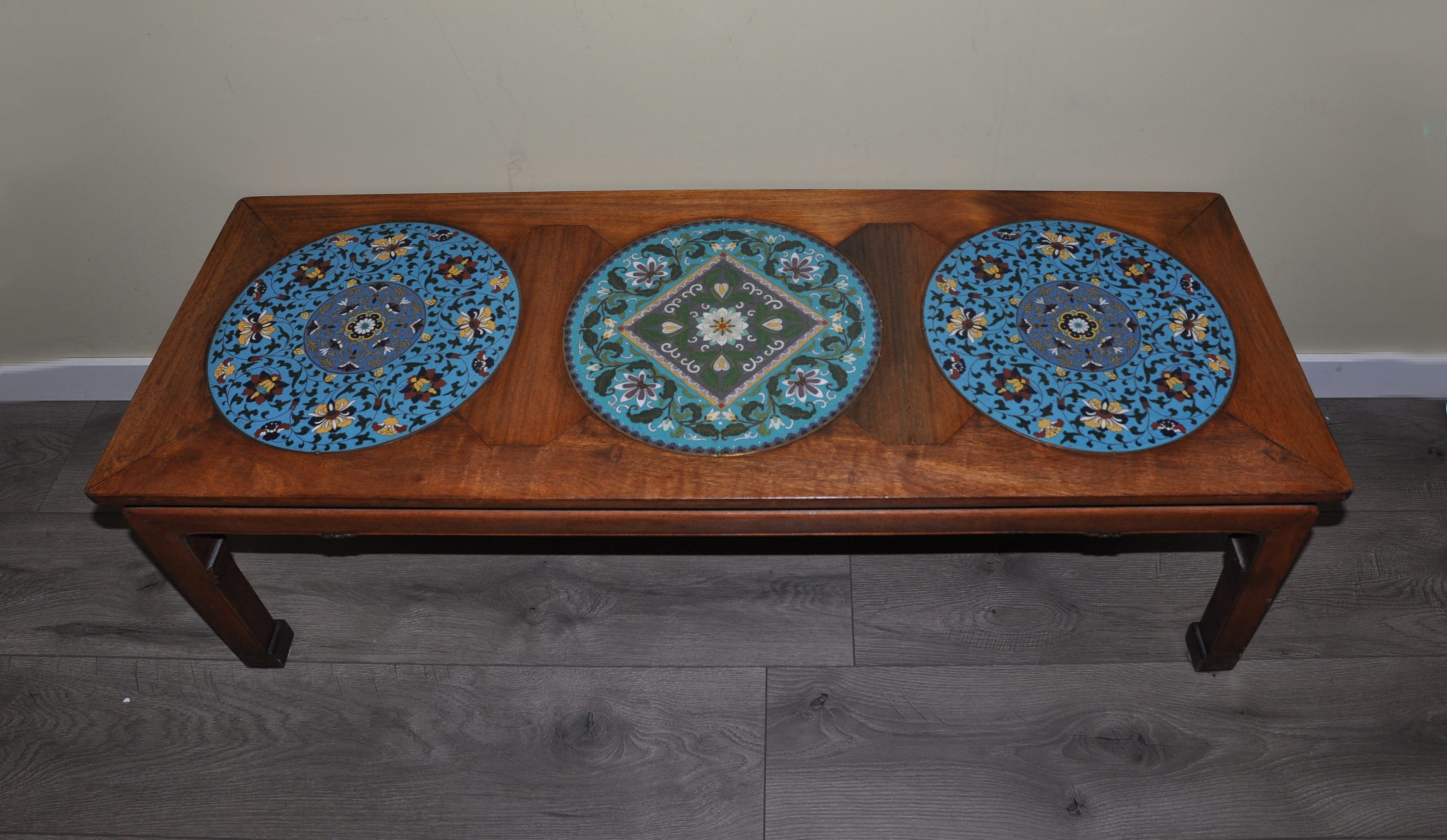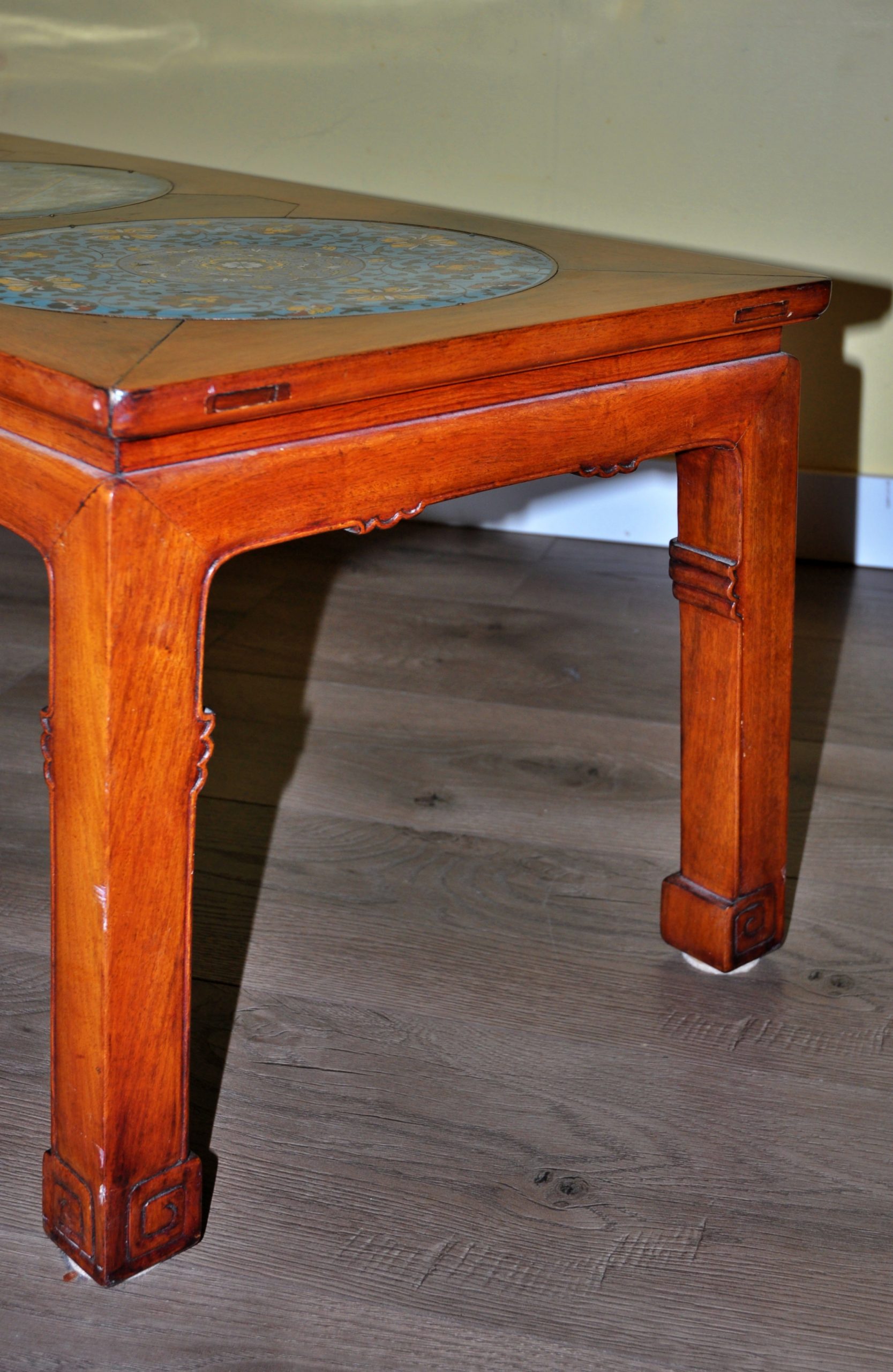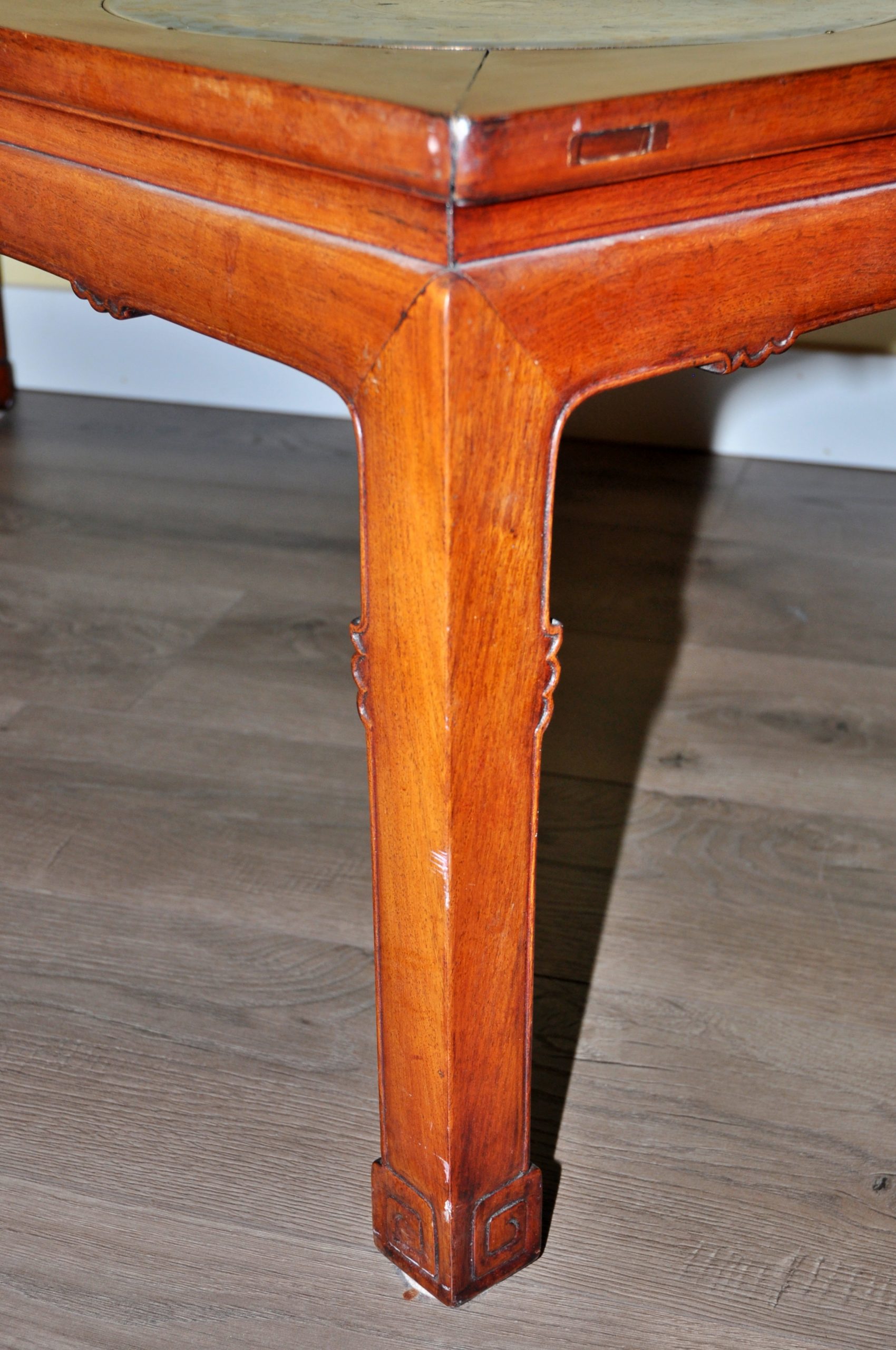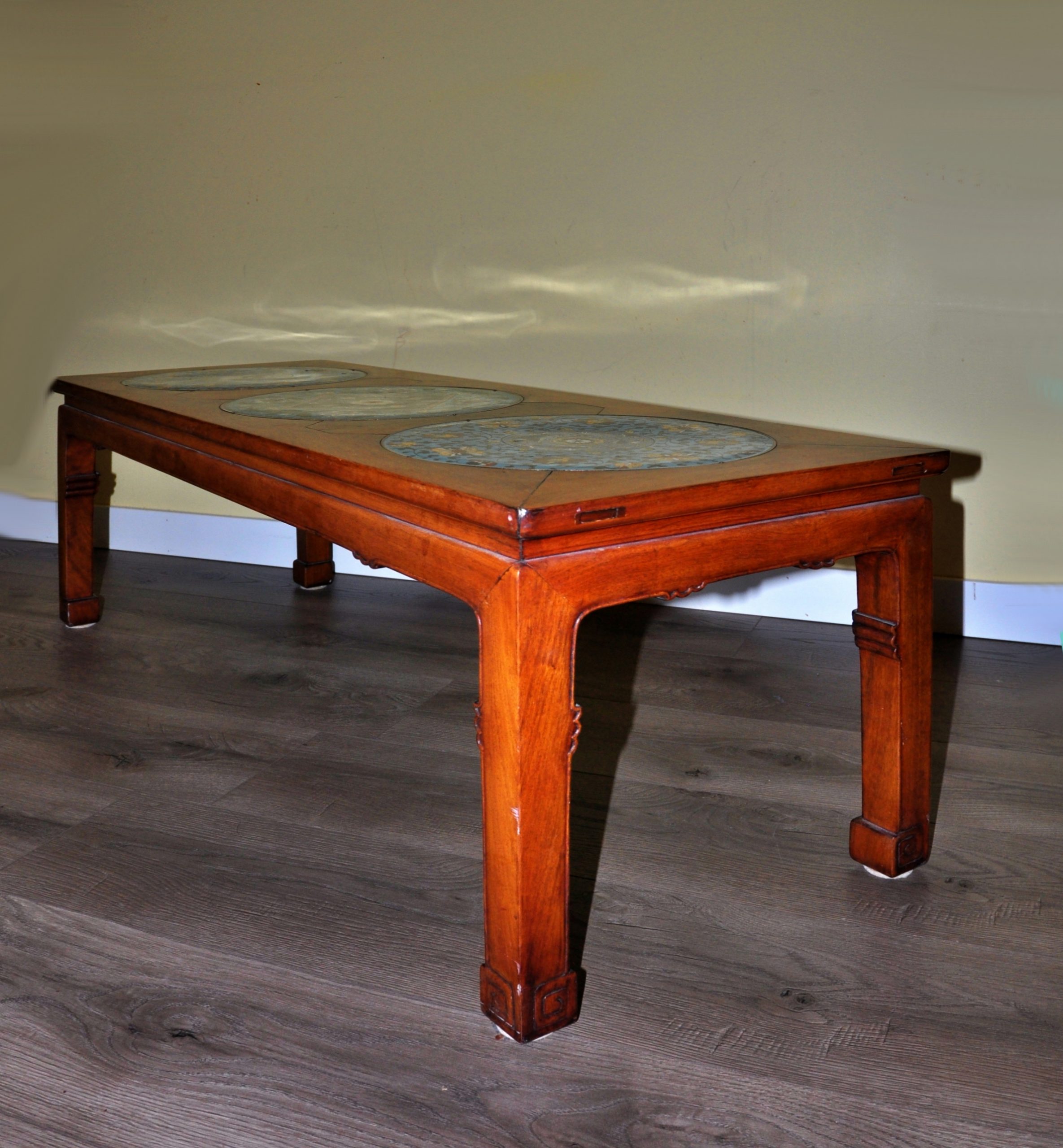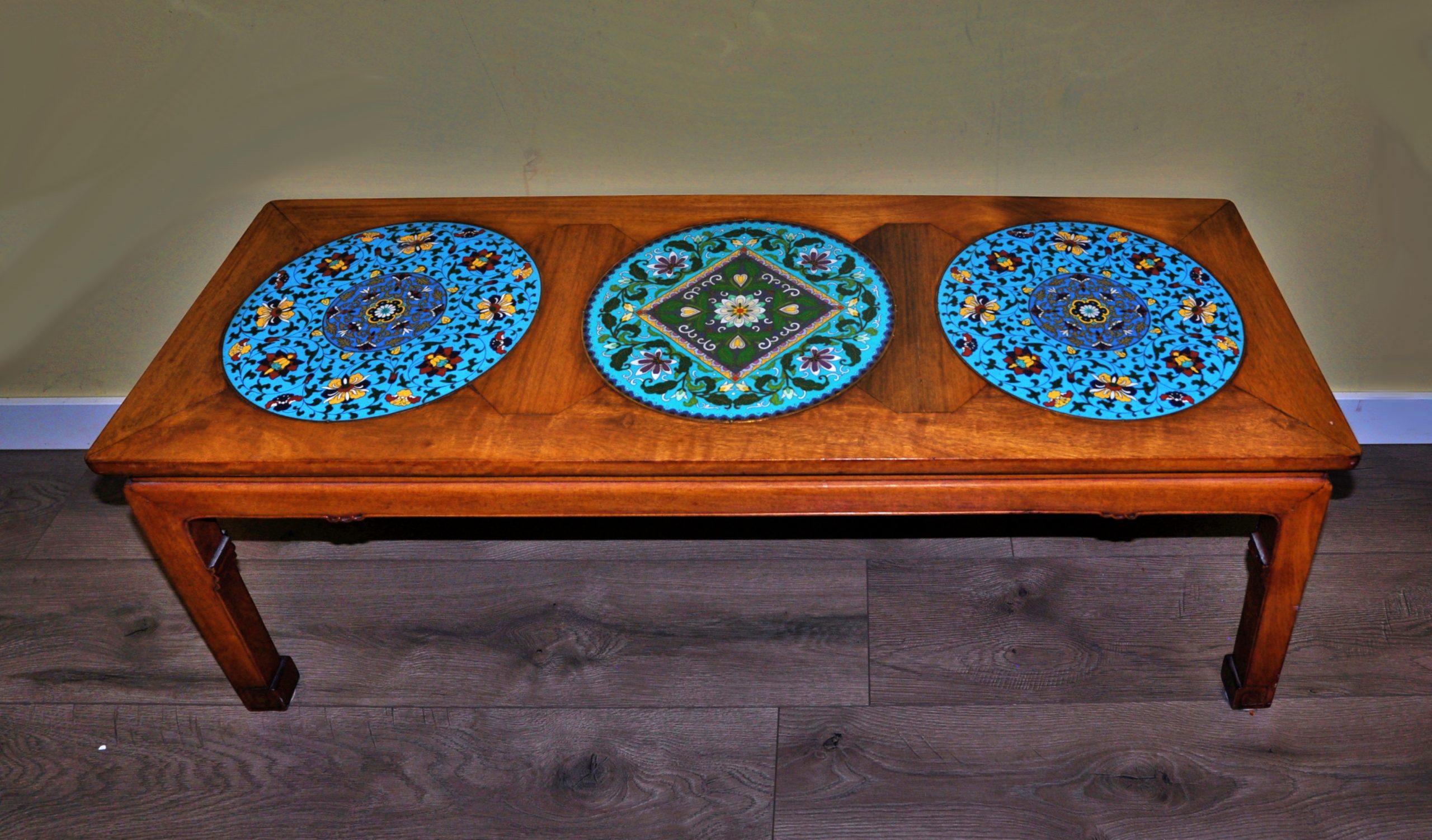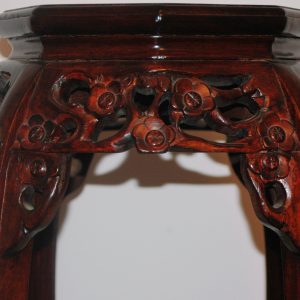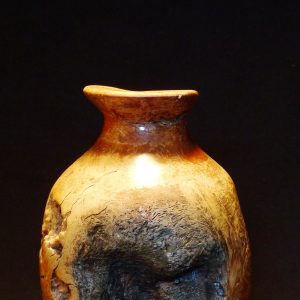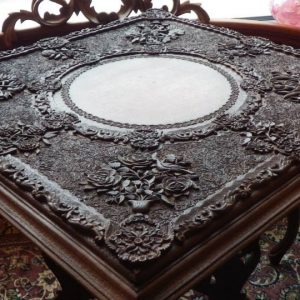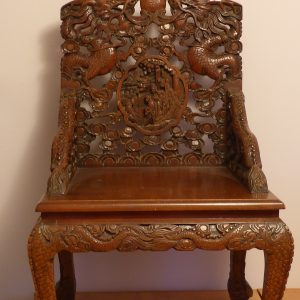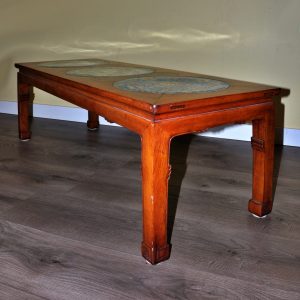Description
明 黄花梨镶珐琅彩盘长几炕桌
参考:佳士得
網上拍賣 18417
24 7月 2020
中國瓷器及工藝精品
拍品 81 清十八世紀 黃花梨矮方桌
美國私人珍藏
18TH CENTURY
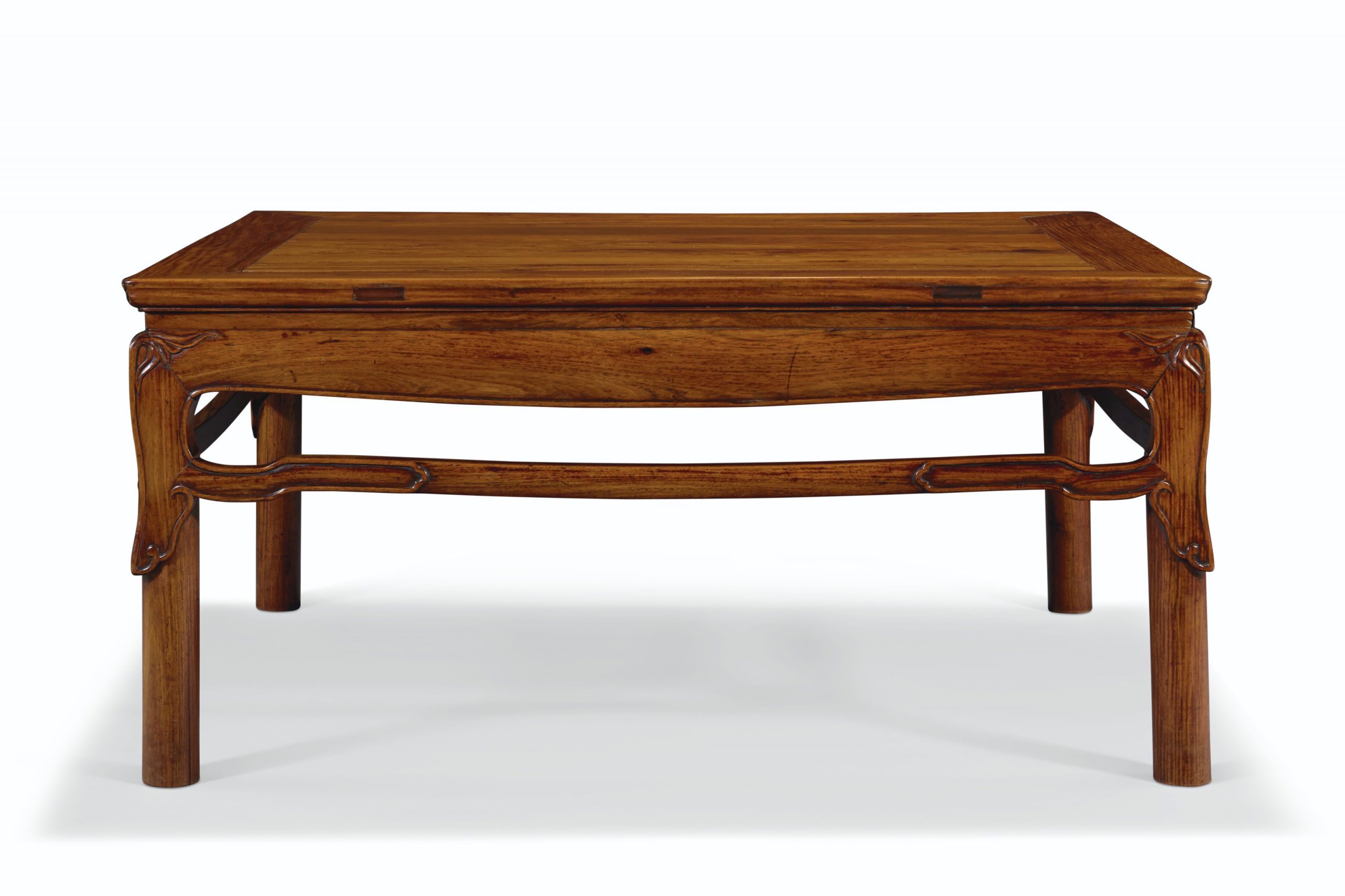
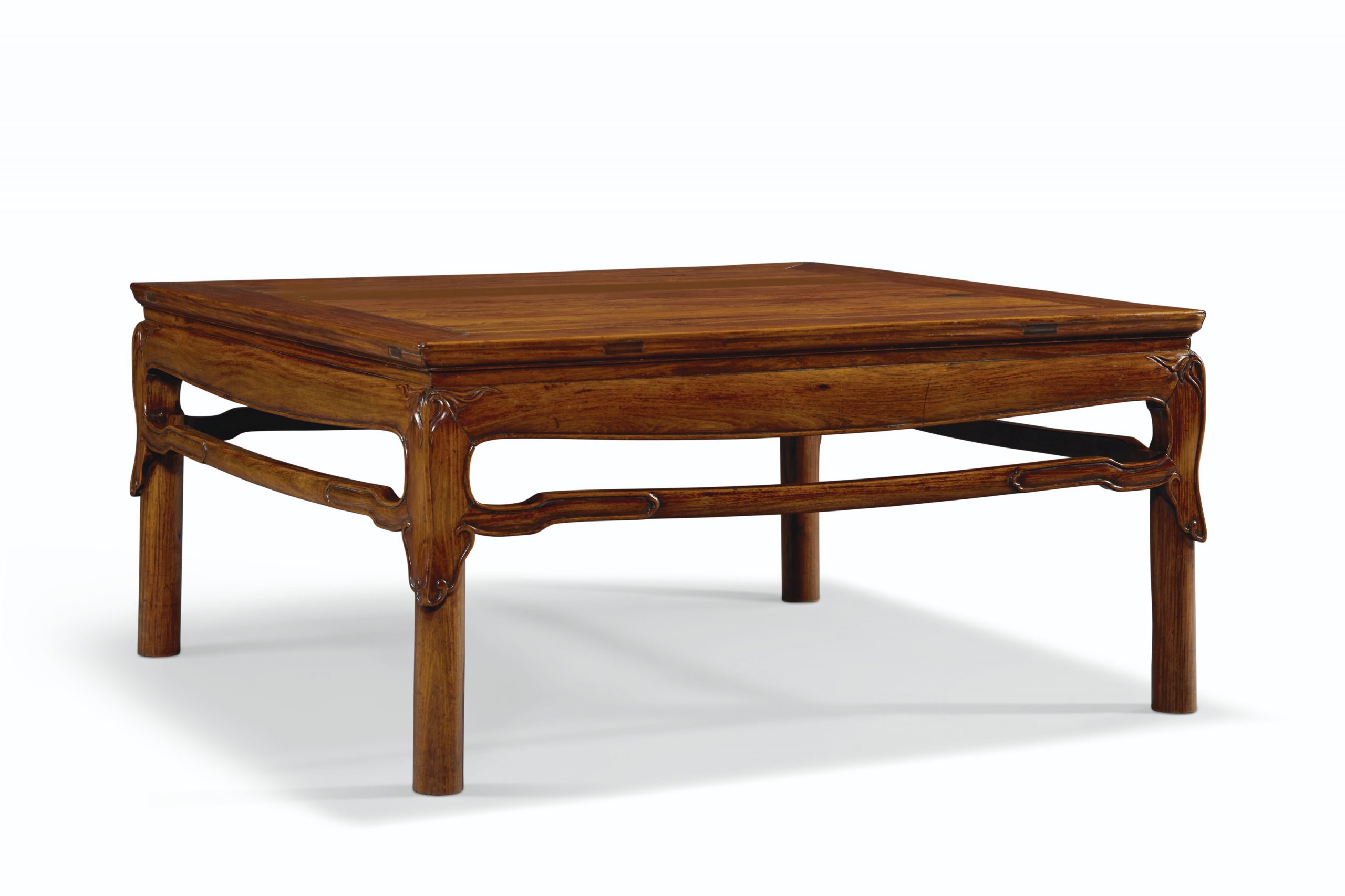
成交價 USD 40,000
估價 USD 8,000 – USD 12,000
清十八世紀 黃花梨矮方桌
18TH CENTURY
19 in. (48.1 cm.) high, 401⁄4 in (102 cm.) wide, 371⁄2 in. (95 cm.) deep
來源
William H. Wolff,紐約。
紐約及佛羅里達私人珍藏,1992-2019年。
狀況報告
– 方桌高度經截短
– 桌面與邊框以及邊框一角有正常輕微分離
– 邊框一外沿有一小處經打磨
– 邊沿有輕微舊裂及微磕,屬正常現象
参考:苏富比
HOTUNG | 何東 The Personal Collection of the late Sir Joseph Hotung: Part 1
October 8, 06:37 AM PDT
Premium Lot
Lot 14 A very rare huanghuali painting table, Qing dynasty, Kangxi period
清康熙 黃花梨束腰拐子龍紋畫桌
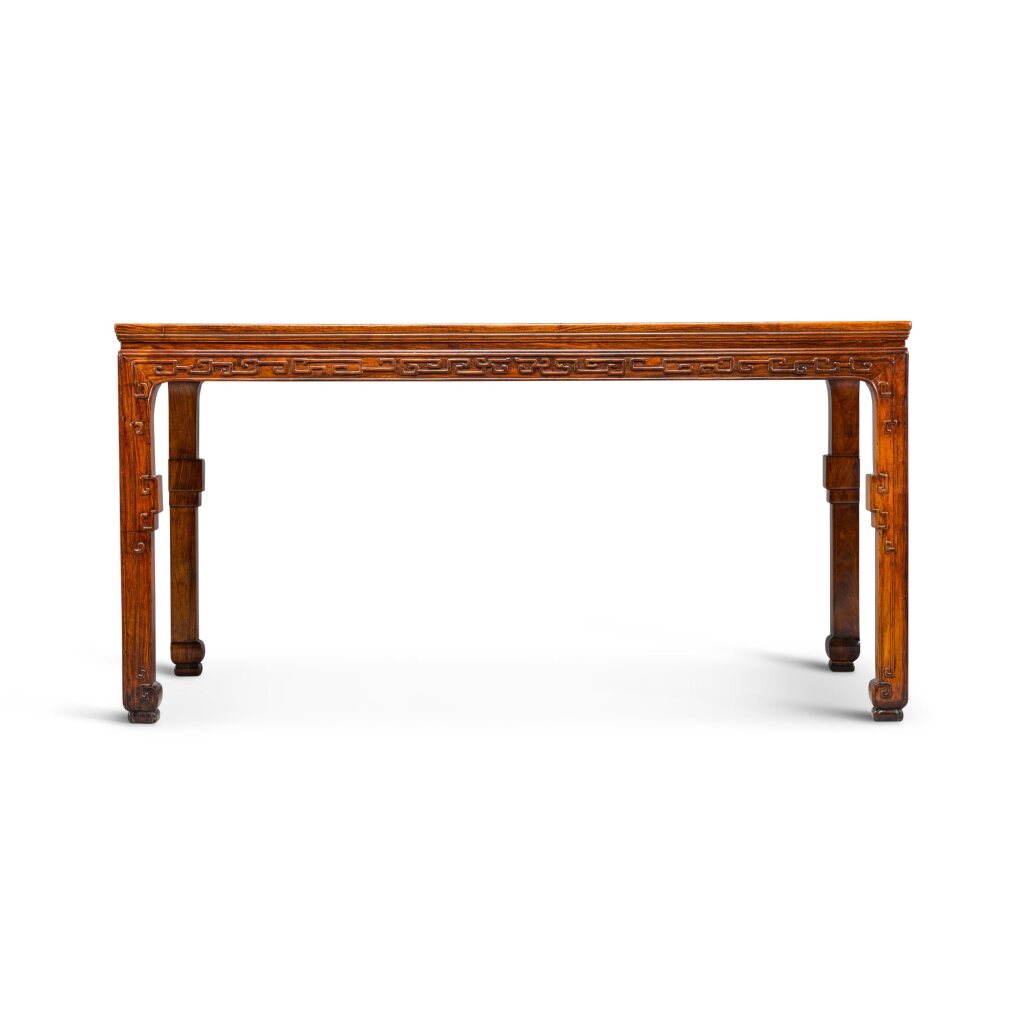
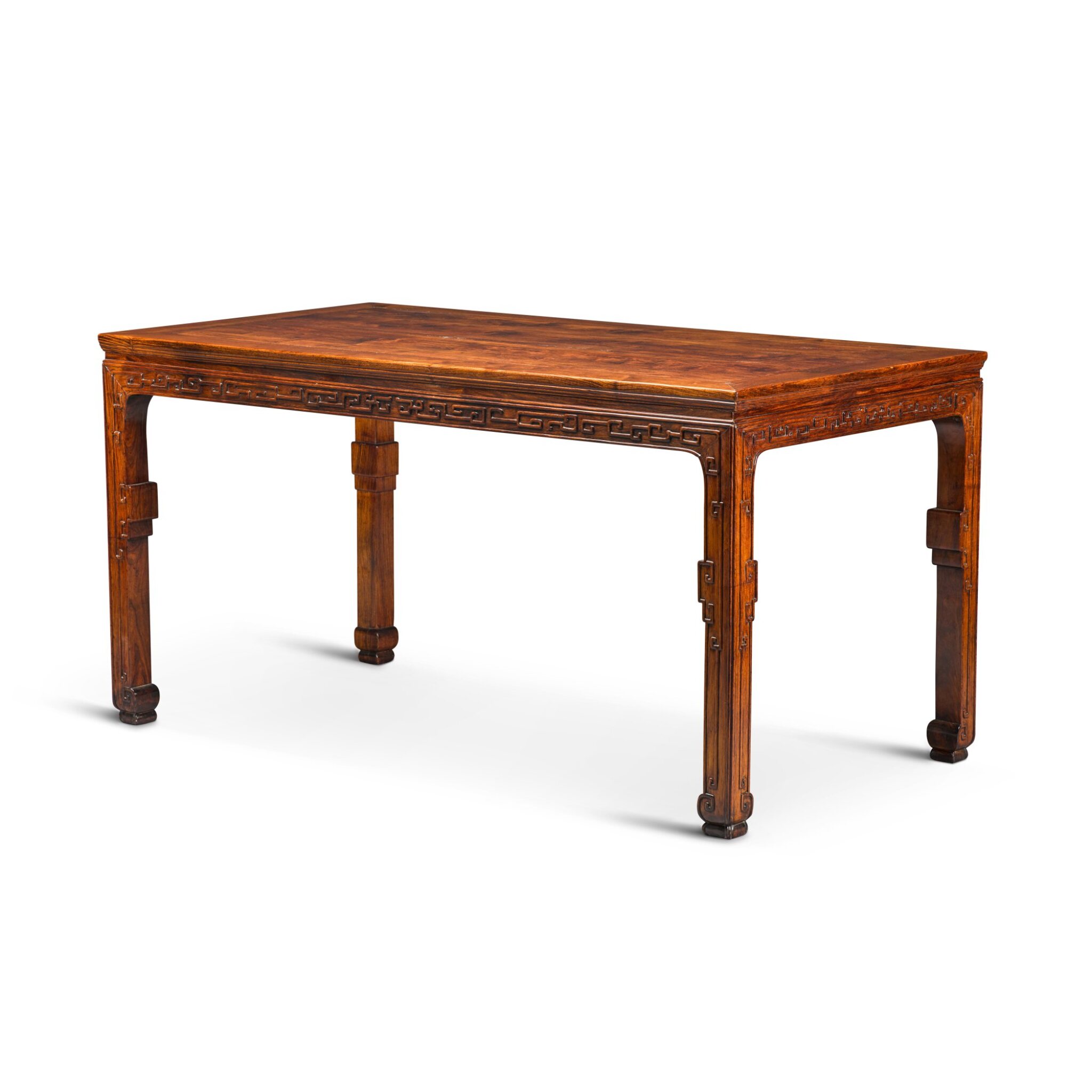
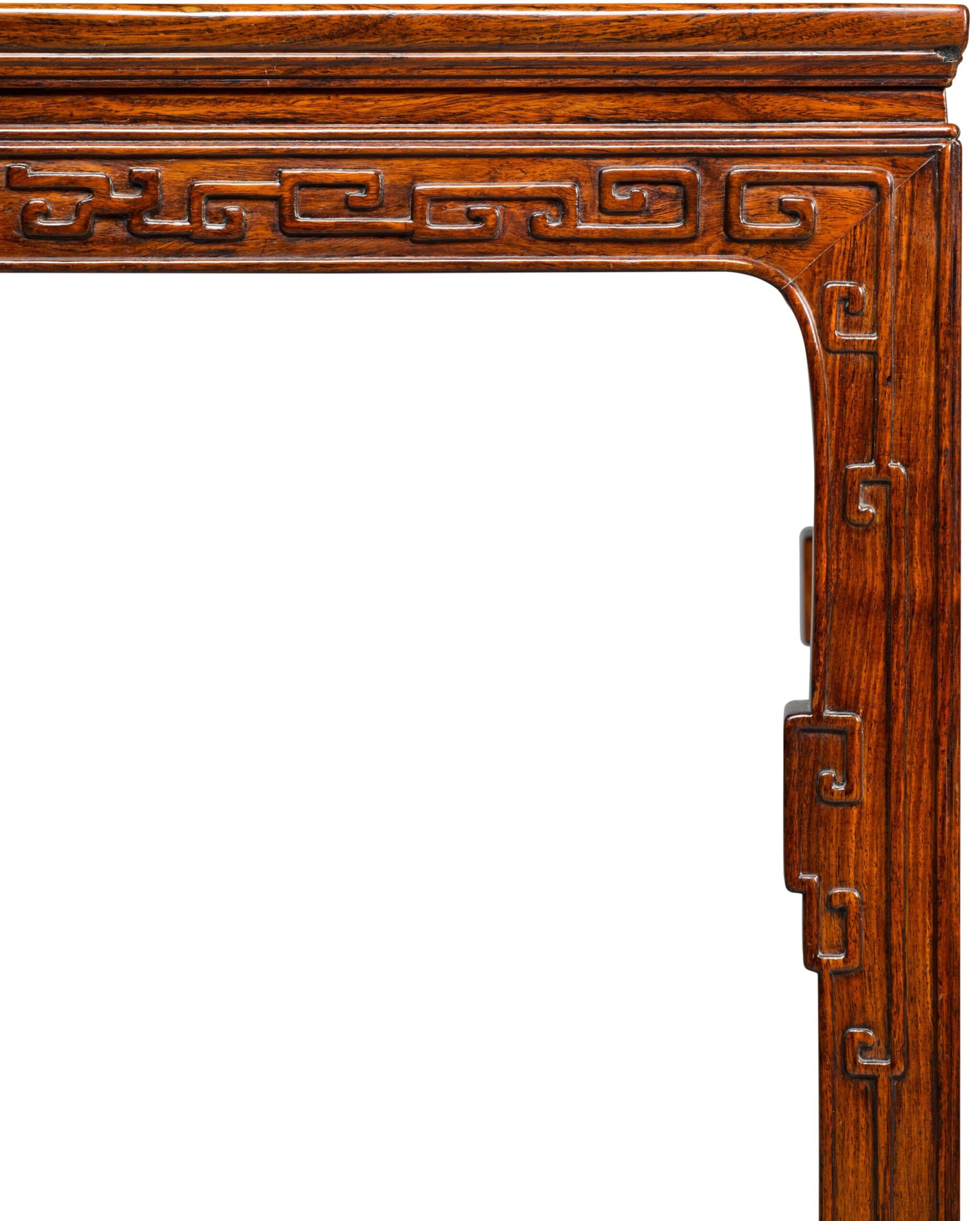
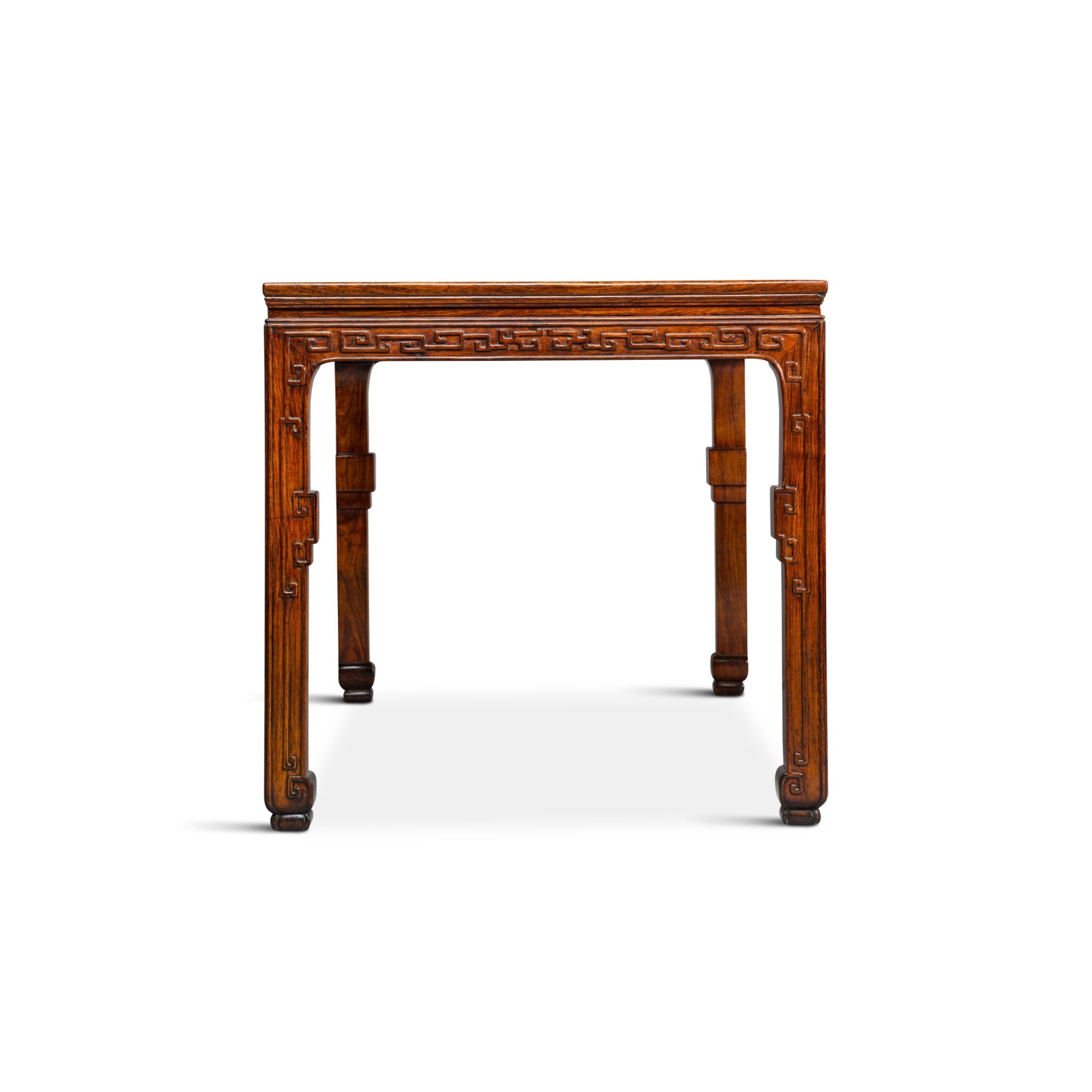

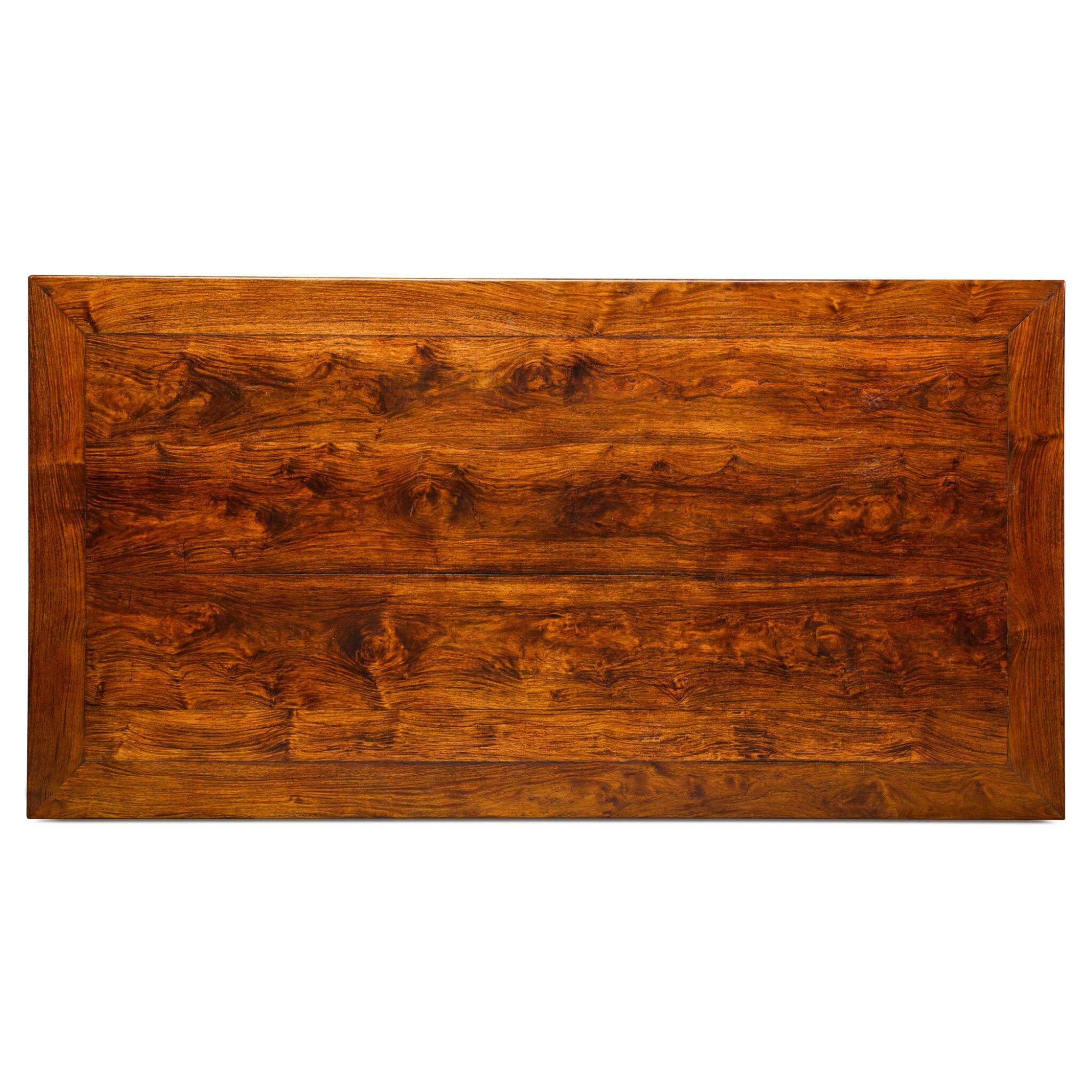
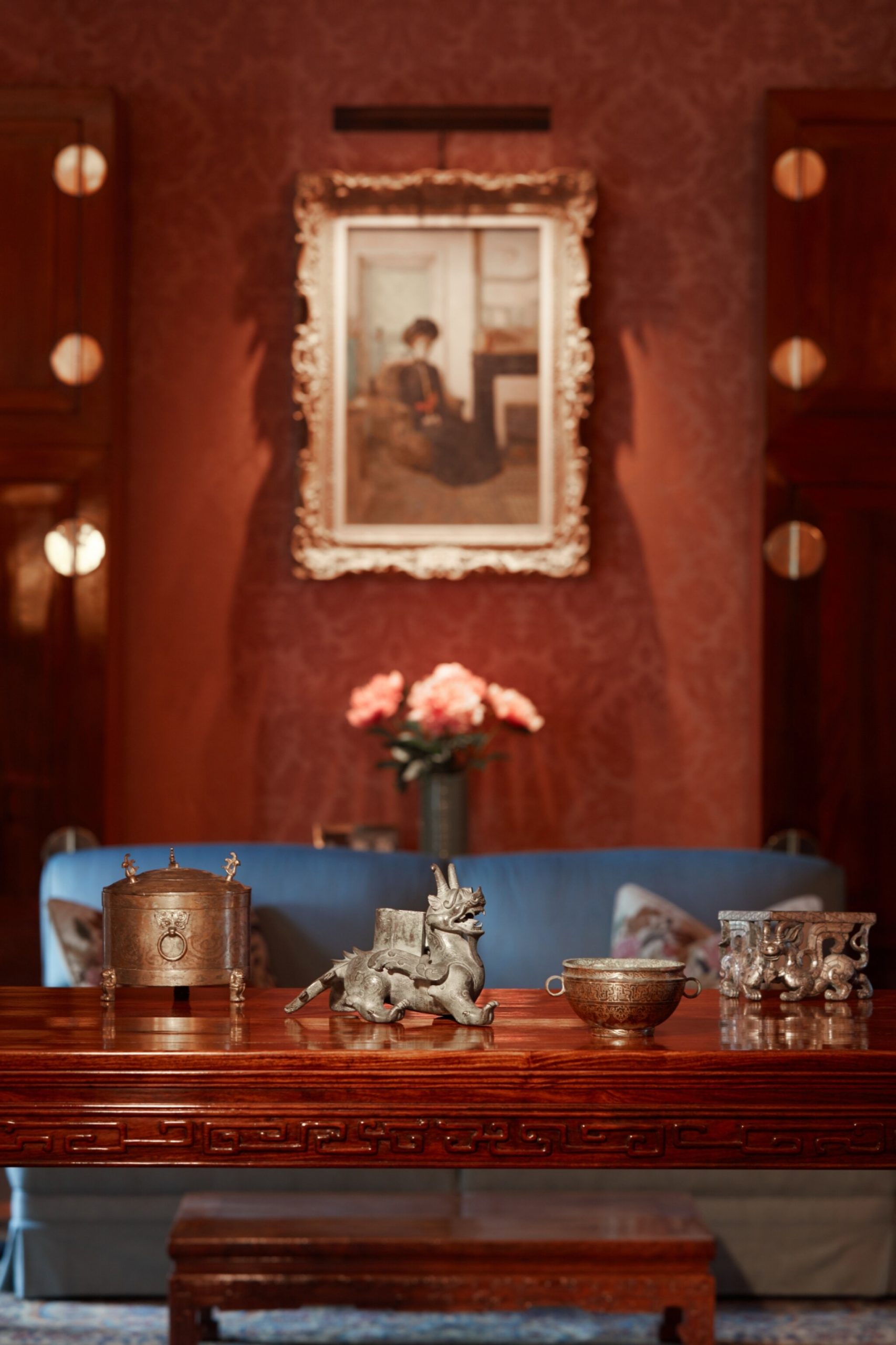
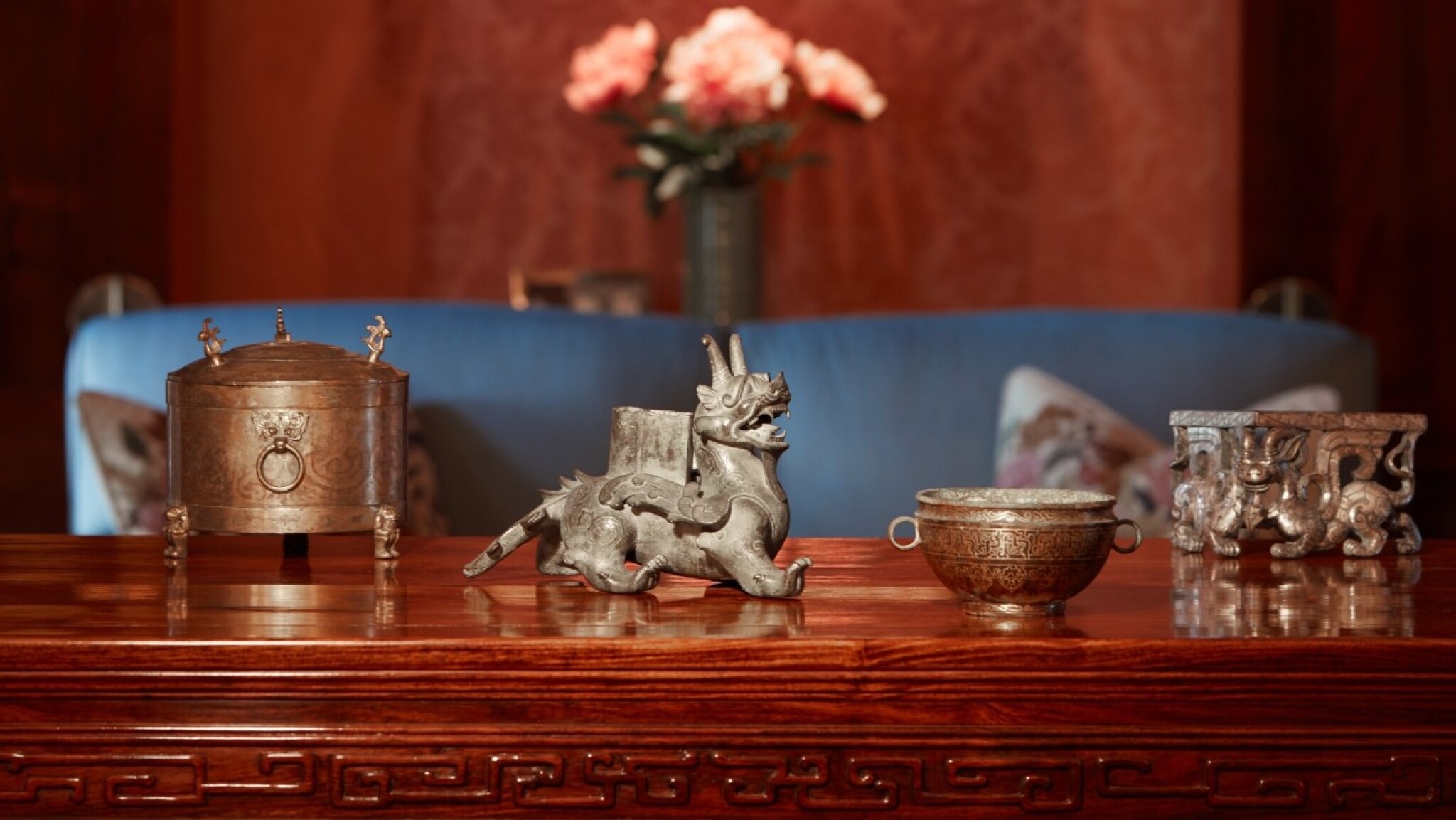
Estimate 6,000,000 – 8,000,000 HKD
Lot Sold 10,055,000 HKD
A very rare huanghuali painting table,
Qing dynasty, Kangxi period
清康熙 黃花梨束腰拐子龍紋畫桌
the top of a standard mitred, mortise-and-tenoned frame with a four-board floating panel, surmounting a narrow recessed waist and a straight apron decorated with confronting stylised kui dragons rendered in beaded angular scrollwork that continues down the inside edge of the square-section legs terminating in hoof feet, with the scrollwork protruding at the midsection of the legs
171 by 89.5 by h. 86.5 cm
Condition Report
One foot has been restuck (approx. h. 8.5 cm from the bottom); The reverse side of the top frame and panel have been cleaned and lightly re-varnished; There are expected surface scratches and blistering to the varnish to the top and expected nicks and dents to the edges consistent with use and age.
一腳馬蹄足重接(自下往上約8.5公分);邊框及面板反面經清理並略罩清漆;表面有劃痕,頂板清漆有小泡,邊沿有微磕、凹痕,皆於年代、使用相符。
Provenance
R.H. Ellsworth Ltd, New York, 12th June 1982.
安思遠,紐約,1982年6月12日
Catalogue Note
This table is exceptional in many respects and no related piece appears to be recorded. Rectangular tables of these broad proportions are unusual and the intriguing carving on the apron of the present piece is extremely rare. The sensitive decoration of two confronting kui dragons of stylised form with sinuous bodies almost completely dissolved into abstract scrollwork lends this table a strikingly elegant presence. Drawing from Chinese traditional iconography, the archaistic kui dragons grant a sense of opulence. The table legs, shaped to an articulated profile and continuing the angular scrollwork, are also not commonly found on contemporary pieces.
Painting tables are distinguished by their generous length and depth, the absence of drawers, as well as their simple decorations beneath the tabletops, creating ample space for free, unimpeded movement for painting, writing or reading. Tables of this type were the most important piece of furniture in the scholar’s studio. The renowned Chinese furniture scholar Wang Shixiang discusses the form of these tables in his publication Connoisseurship of Chinese Furniture, Hong Kong, 1990, vol. 1, p. 68 and notes that “the popular arrangement for all tables was with one end against a window where abundant natural light made writing, painting or reading a more pleasant exercise. In this position, the opposite side could also be used by an assistant to hold the sheet of paper or for some other purpose. It was also common to place these tables in a room, away from walls, with or without chairs.” Such tables are often depicted in contemporary paintings and woodblock-printed books, as in an illustration in Guzhang Juechen [Fantastic tales of society] published in the Chongzhen period (1628-44), as illustrated in Grace Wu, The Best of the Best. The MQJ Collection of Ming Furniture, vol. 1, Beijing, 2017, p. 134, which depicts a lady sitting on a stool and leaning on a large painting table to read a letter, with a vase and a few other decorative objects placed on the opposite end.
With its beautifully vibrant colour and highly figured grain, huanghuali wood was reserved for high-quality furniture since the Ming dynasty (1368-1644). Craftsmen made use of the special features of the timber by creating furniture with smooth, plain surfaces and restrained adornment to celebrate the natural beauty of the distinctive grain. The wood continued to be treasured by the imperial court and the upper classes during the Qing period (1644-1911) and was used extensively to produce sophisticated furniture such as the present piece.
此案之寬綽比例與精緻的牙條雕紋極為罕見,群書無類例見載。牙子雕變形䕫龍,簡約抽象,洋溢清秀氣息,同顯富盛。腿上添飾方卷紋,內翻馬蹄狀似卷草,均與上方拐子龍相呼應,在同代例子中亦不常見。
畫桌寬廣,牙條簡潔,不設抽屜,下方更為空敞,便於起坐揮筆,為文人雅士書齋必備。王世襄指此類寬長桌案,一般倚窗而置,光線明亮有利讀寫,也便於侍從在對面握紙提絹;另一種擺法則是室內居中,四周或設椅、或騰空(見《明式家具研究》,卷1,香港,1990年,頁68)。相類桌案屢見於同代繪畫及插圖,見崇禎 (1628-44年)刊本《鼓掌絕塵》,描繪女士坐凳上倚靠畫案讀信,末端擺放花瓶及陳設品,載於伍嘉恩,《木趣居:家具中的嘉具》,卷1,北京,2017年,頁134。
黃花梨色澤溫潤,紋理清晰細膩。自明朝(1368-1644年),工匠利用木材之獨特品質,製作光滑樸素的家具,以凸顯其自然美。入清(1644-1911年)以後,黃花梨受宮廷貴冑珍視,廣泛採用,家具設計更趨複雜,此例正是當中典範。
参考:苏富比
CHINA / 5000 YEARS
September 26, 2023
PROPERTY FROM THE PERSONAL COLLECTION OF THE LATE SIR JOSEPH HOTUNG
Lot 1359
A ‘huanghuali’ and ‘jichimu’ low table (Kangzhuo), 17th / 18th century
十七 / 十八世紀 黃花梨拼鸂鶒木羅鍋棖有束腰馬蹄足炕桌
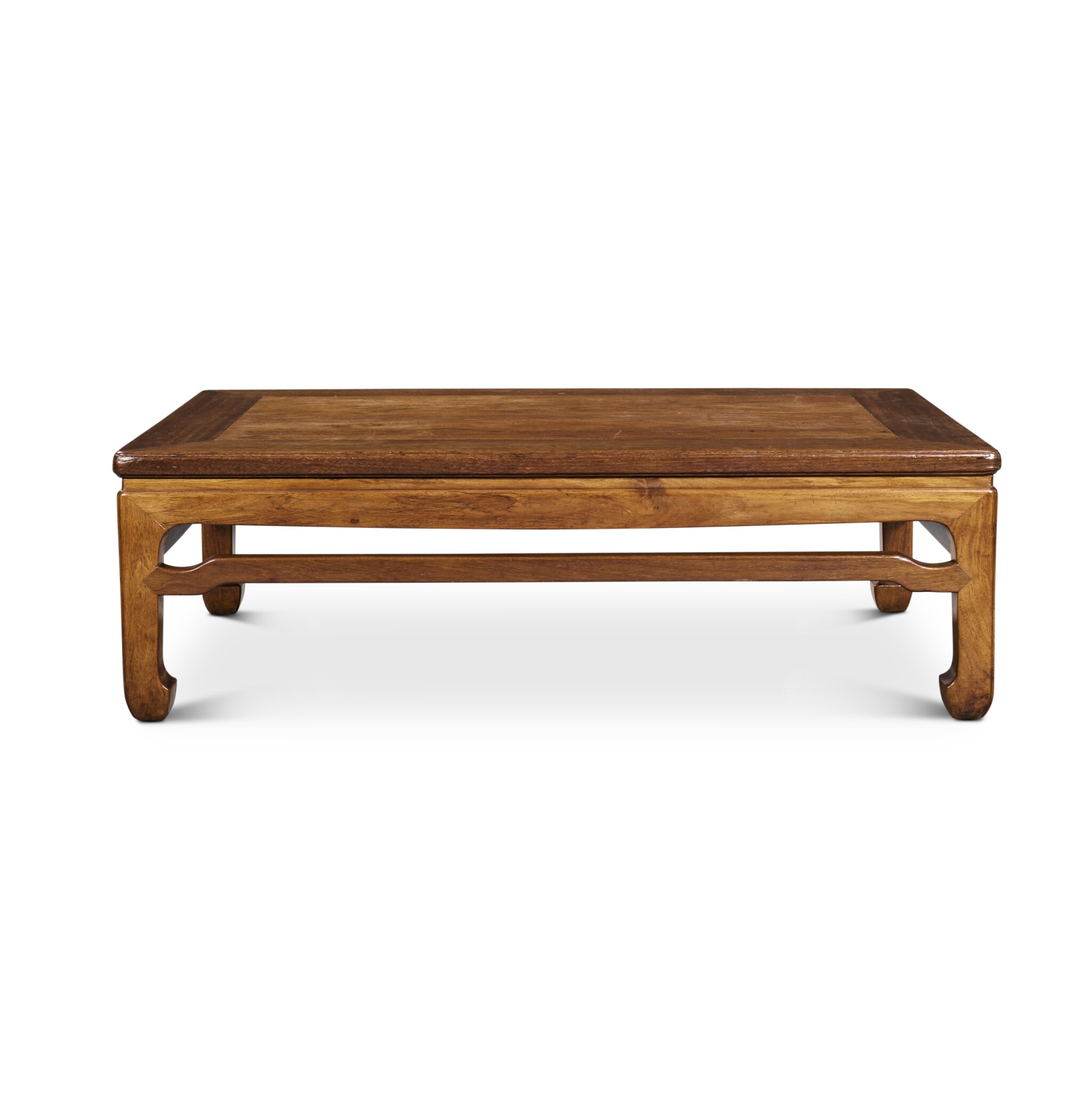
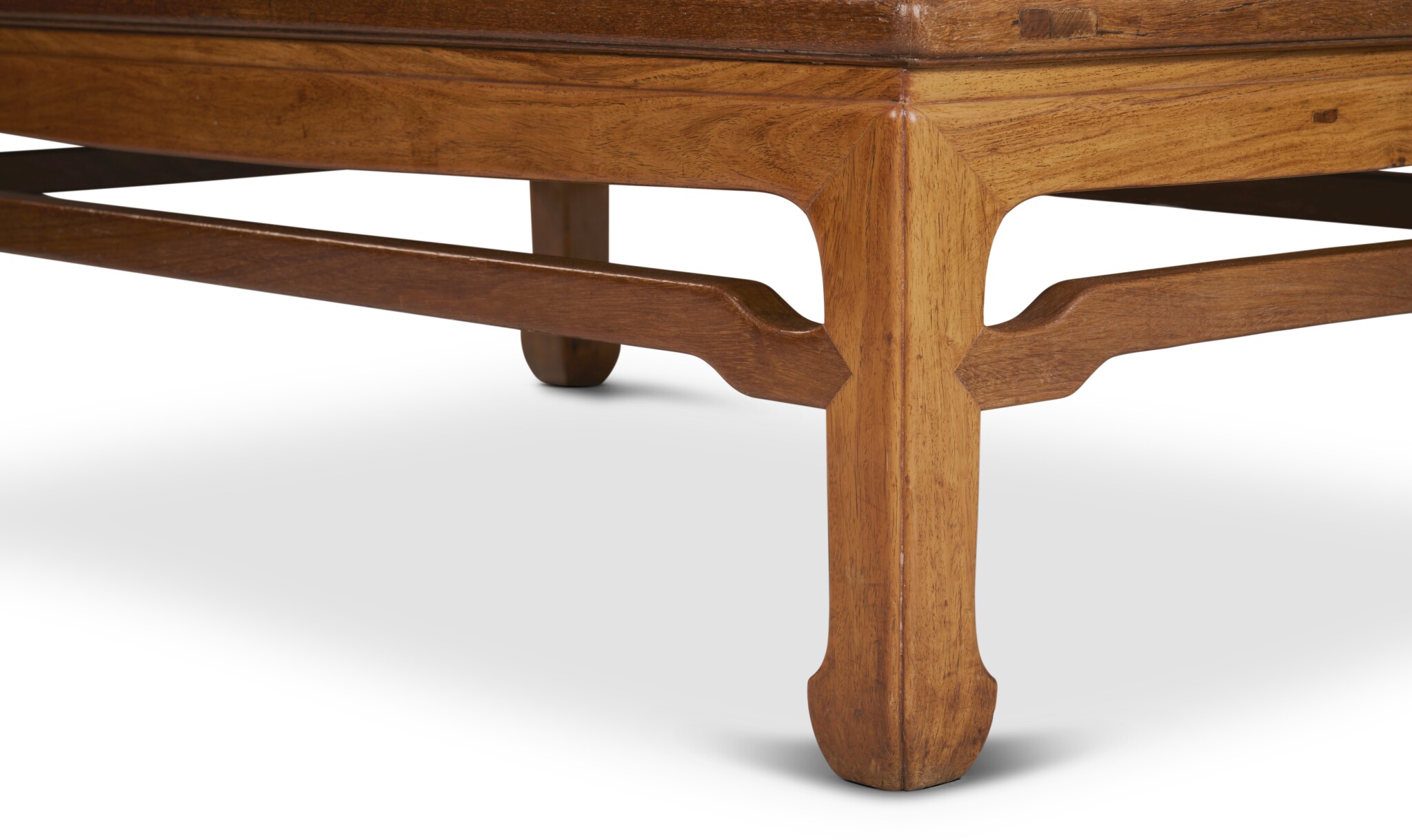
Estimate 6,000 – 8,000 USD
Lot Sold 8,890 USD
A ‘huanghuali’ and ‘jichimu’ low table (Kangzhuo)
17th / 18th century
十七 / 十八世紀 黃花梨拼鸂鶒木羅鍋棖有束腰馬蹄足炕桌
‘huanghuali’ top panels, waisted-apron and legs, ‘jichimu’ frame and stretchers
Height 12¼ in., 31.1 cm; Width 39¼ in., 99.7 cm; Depth 25¼ in., 64.1 cm
Condition Report
The table with one filled tenon on the apron. There are some minor filled and patch repairs and overall consolidation of the joinery. There are scattered nickes, wear, slight staining, and some splitting at the feet consistent with age and use. 一側束腰下方見一小補。整體見些許輕微小補及補修,榫卯結合處經加固。另見些許小磕、磨損、輕微污漬及足部微細裂紋,與其年代及使用相符。
Provenance
Robert H. Ellsworth, New York, 24th April 1985.
Important Chinese Art
Lot 544
A ‘huanghuali’ and ‘jichimu’ low table (Kangzhuo), 17th / 18th century
十七 / 十八世紀 黃花梨拼鸂鶒木羅鍋棖有束腰馬蹄足炕桌
March 22, 01:01 PM PDT
Estimate 20,000 – 30,000 USD
A ‘huanghuali’ and ‘jichimu’ low table (Kangzhuo)
17th / 18th century
十七 / 十八世紀 黃花梨拼鸂鶒木羅鍋棖有束腰馬蹄足炕桌
huanghuali top panels, waisted-apron and legs, jichimu frame and stretchers
Height 12¼ in., 31.1 cm; Width 39¼ in., 99.7 cm; Depth 25¼ in., 64.1 cm
Condition Report
The table with one filled tenon on the apron. There are some minor filled and patch repairs and overall consolidation of the joinery. There are scattered nickes, wear, slight staining, and some splitting at the feet consistent with age and use.
一側束腰下方見一小補。整體見些許輕微小補及補修,榫卯結合處經加固。另見些許小磕、磨損、輕微污漬及足部微細裂紋,與其年代及使用相符。
Provenance
Robert H. Ellsworth, New York, 24th April 1985.
参考:苏富比 October 9, 2023
THE PERSONAL COLLECTION OF THE LATE SIR JOSEPH HOTUNG
何鴻卿爵士私人珍藏
Lot 3687
A very rare huanghuali painting table, Qing dynasty, Kangxi period
清康熙 黃花梨束腰拐子龍紋畫桌
Restricted Species
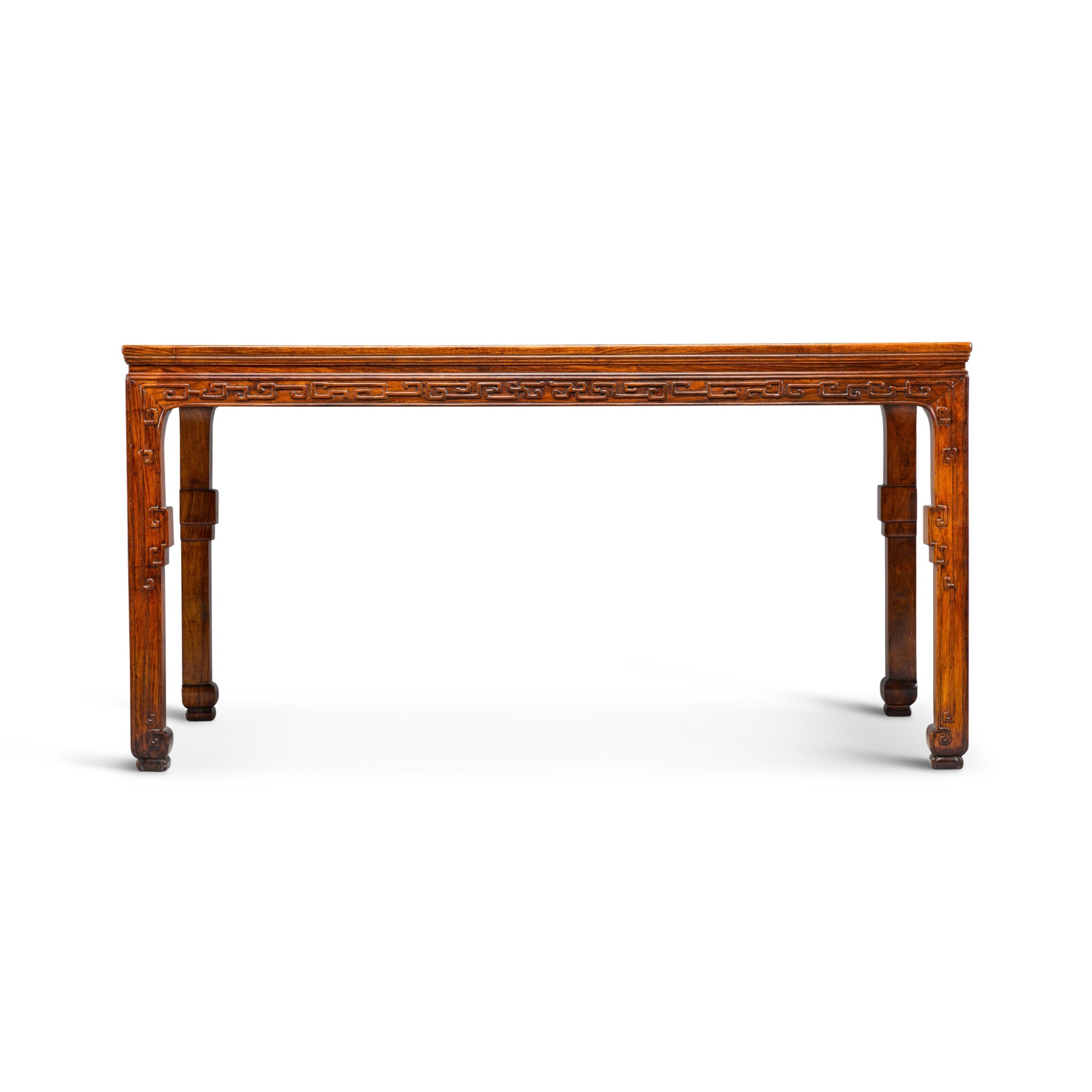
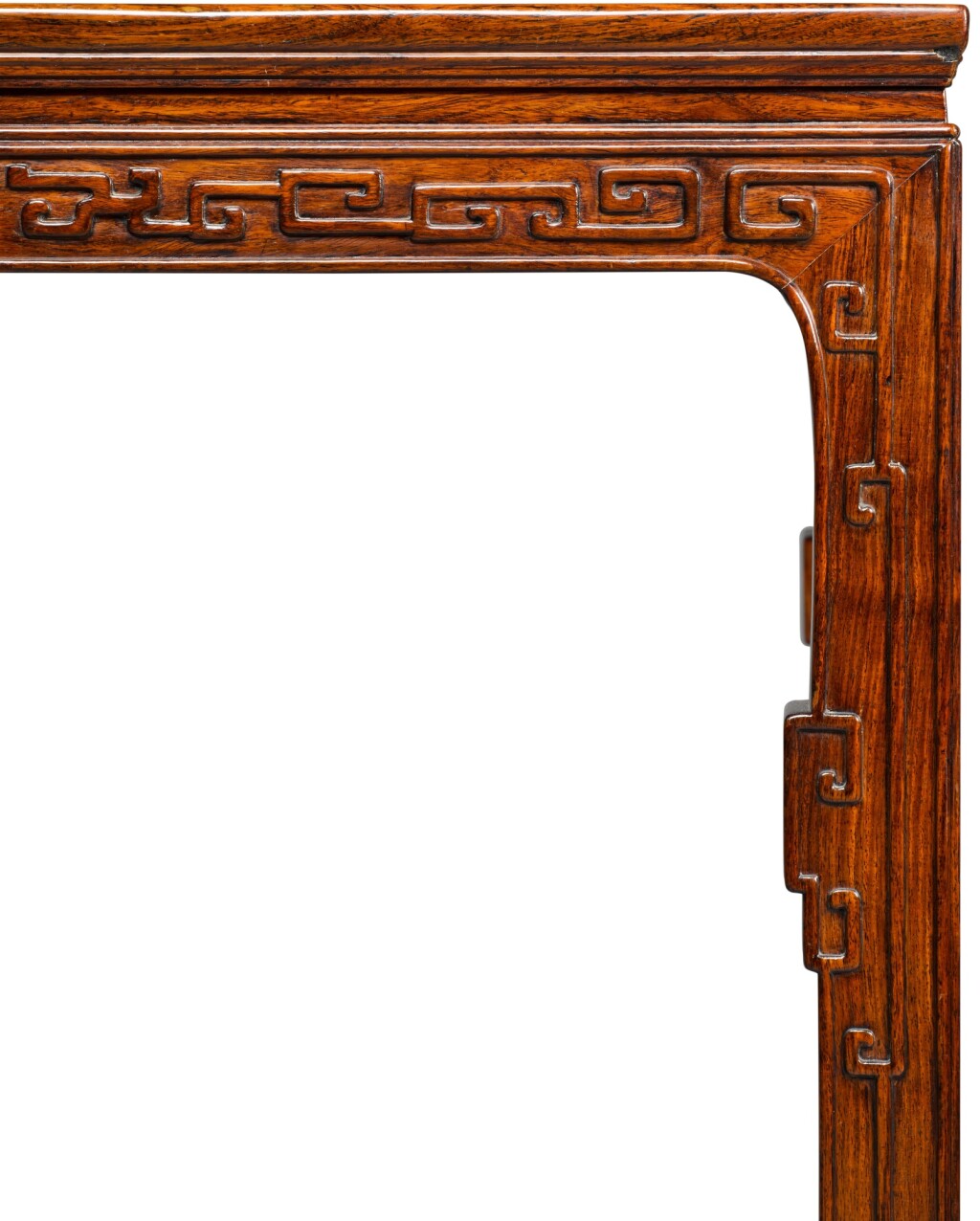
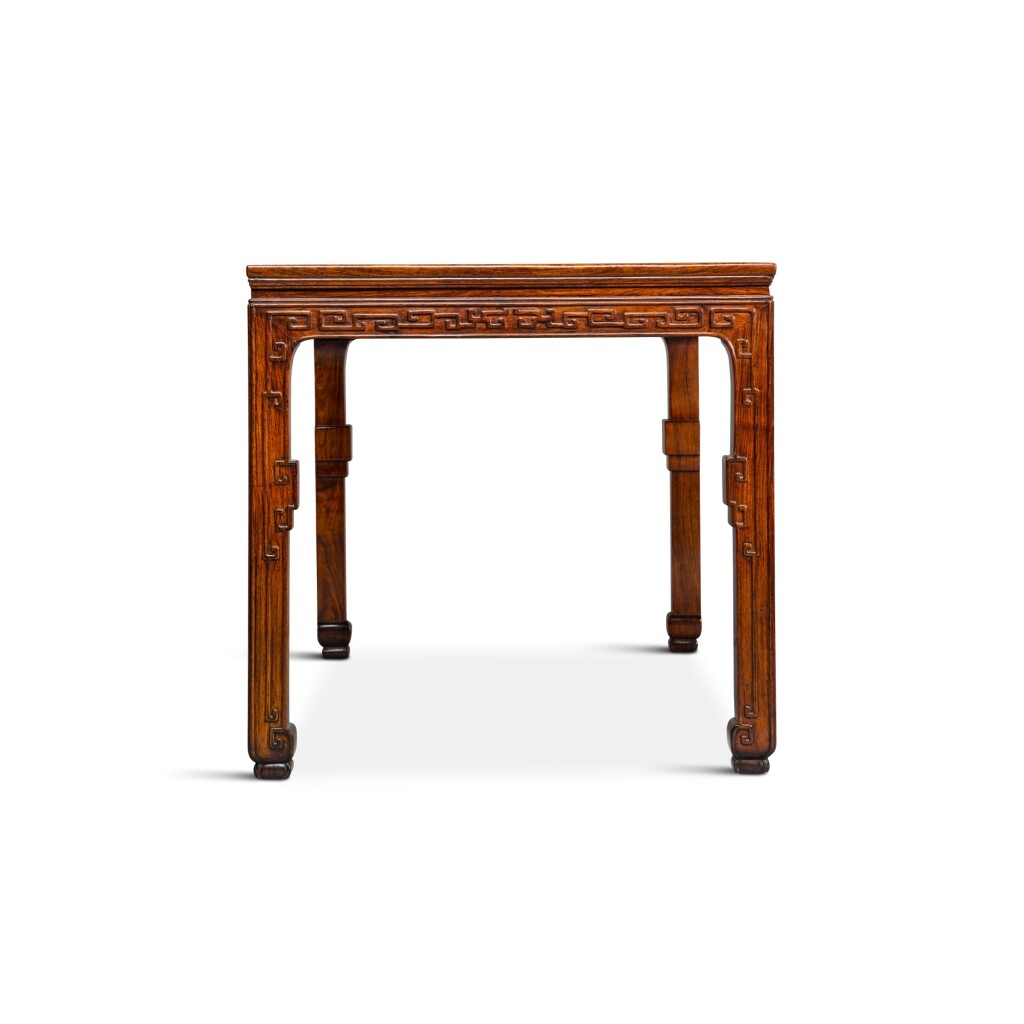

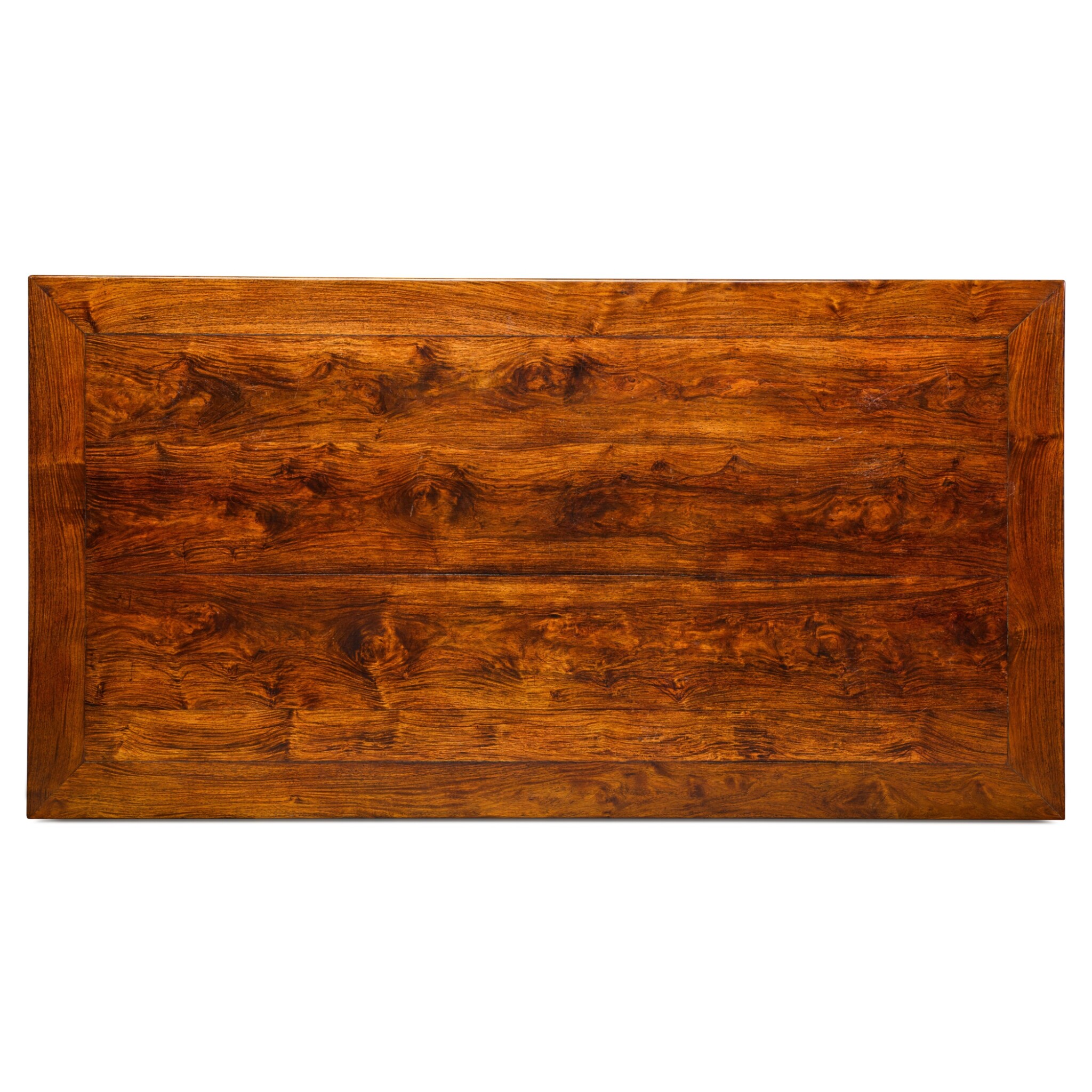
Estimate 3,000,000 – 5,000,000 HKD
Lot Sold 4,445,000 HKD
The personal collection of the late Sir Joseph Hotung
A very rare huanghuali painting table,
Qing dynasty, Kangxi period
何鴻卿爵士私人珍藏
清康熙 黃花梨束腰拐子龍紋畫桌
171 by 89.5 by h. 86.5 cm
Provenance
R.H. Ellsworth Ltd, New York, 12th June 1982.
安思遠,紐約,1982年6月12日
Condition Report
One foot has been restuck (approx. h. 8.5 cm from the bottom); The reverse side of the top frame and panel have been cleaned and lightly re-varnished; There are expected surface scratches and blistering to the varnish to the top and expected nicks and dents to the edges consistent with use and age.
一腳馬蹄足重接(自下往上約8.5公分);邊框及面板反面經清理並略罩清漆;表面有劃痕,頂板清漆有小泡,邊沿有微磕、凹痕,皆於年代、使用相符。
Catalogue Note
This table is exceptional in many respects and no related piece appears to be recorded. Rectangular tables of these broad proportions are unusual and the intriguing carving on the apron of the present piece is extremely rare. The sensitive decoration of two confronting kui dragons of stylised form with sinuous bodies almost completely dissolved into abstract scrollwork lends this table a strikingly elegant presence. Drawing from Chinese traditional iconography, the archaistic kui dragons grant a sense of opulence. The table legs, shaped to an articulated profile and continuing the angular scrollwork, are also not commonly found on contemporary pieces.
Painting tables are distinguished by their generous length and depth, the absence of drawers, as well as their simple decorations beneath the tabletops, creating ample space for free, unimpeded movement for painting, writing or reading. Tables of this type were the most important piece of furniture in the scholar’s studio. The renowned Chinese furniture scholar Wang Shixiang discusses the form of these tables in his publication Connoisseurship of Chinese Furniture, Hong Kong, 1990, vol. 1, p. 68 and notes that “the popular arrangement for all tables was with one end against a window where abundant natural light made writing, painting or reading a more pleasant exercise. In this position, the opposite side could also be used by an assistant to hold the sheet of paper or for some other purpose. It was also common to place these tables in a room, away from walls, with or without chairs.” Such tables are often depicted in contemporary paintings and woodblock-printed books, as in an illustration in Guzhang Juechen [Fantastic tales of society] published in the Chongzhen period (1628-44), as illustrated in Grace Wu, The Best of the Best. The MQJ Collection of Ming Furniture, vol. 1, Beijing, 2017, p. 134, which depicts a lady sitting on a stool and leaning on a large painting table to read a letter, with a vase and a few other decorative objects placed on the opposite end.
With its beautifully vibrant colour and highly figured grain, huanghuali wood was reserved for high-quality furniture since the Ming dynasty (1368-1644). Craftsmen made use of the special features of the timber by creating furniture with smooth, plain surfaces and restrained adornment to celebrate the natural beauty of the distinctive grain. The wood continued to be treasured by the imperial court and the upper classes during the Qing period (1644-1911) and was used extensively to produce sophisticated furniture such as the present piece.
此案之寬綽比例與精緻的牙條雕紋極為罕見,群書無類例見載。牙子雕變形䕫龍,簡約抽象,洋溢清秀氣息,同顯富盛。腿上添飾方卷紋,內翻馬蹄狀似卷草,均與上方拐子龍相呼應,在同代例子中亦不常見。
畫桌寬廣,牙條簡潔,不設抽屜,下方更為空敞,便於起坐揮筆,為文人雅士書齋必備。王世襄指此類寬長桌案,一般倚窗而置,光線明亮有利讀寫,也便於侍從在對面握紙提絹;另一種擺法則是室內居中,四周或設椅、或騰空(見《明式家具研究》,卷1,香港,1990年,頁68)。相類桌案屢見於同代繪畫及插圖,見崇禎(1628-44年)刊本《鼓掌絕塵》,描繪女士坐凳上倚靠畫案讀信,末端擺放花瓶及陳設品,載於伍嘉恩,《木趣居:家具中的嘉具》,卷1,北京,2017年,頁134。
黃花梨色澤溫潤,紋理清晰細膩。自明朝(1368-1644年),工匠利用木材之獨特品質,製作光滑樸素的家具,以凸顯其自然美。入清(1644-1911年)以後,黃花梨受宮廷貴冑珍視,廣泛採用,家具設計更趨複雜,此例正是當中典範。
参考:苏富比
PROPERTY FROM A EUROPEAN PRIVATE COLLECTION
歐洲私人收藏
November 1, 09:48 AM PDT
A ‘huanghuali’ waistless daybed (Ta), Ming dynasty, 17th century
明十七世紀 黃花梨馬蹄足榻
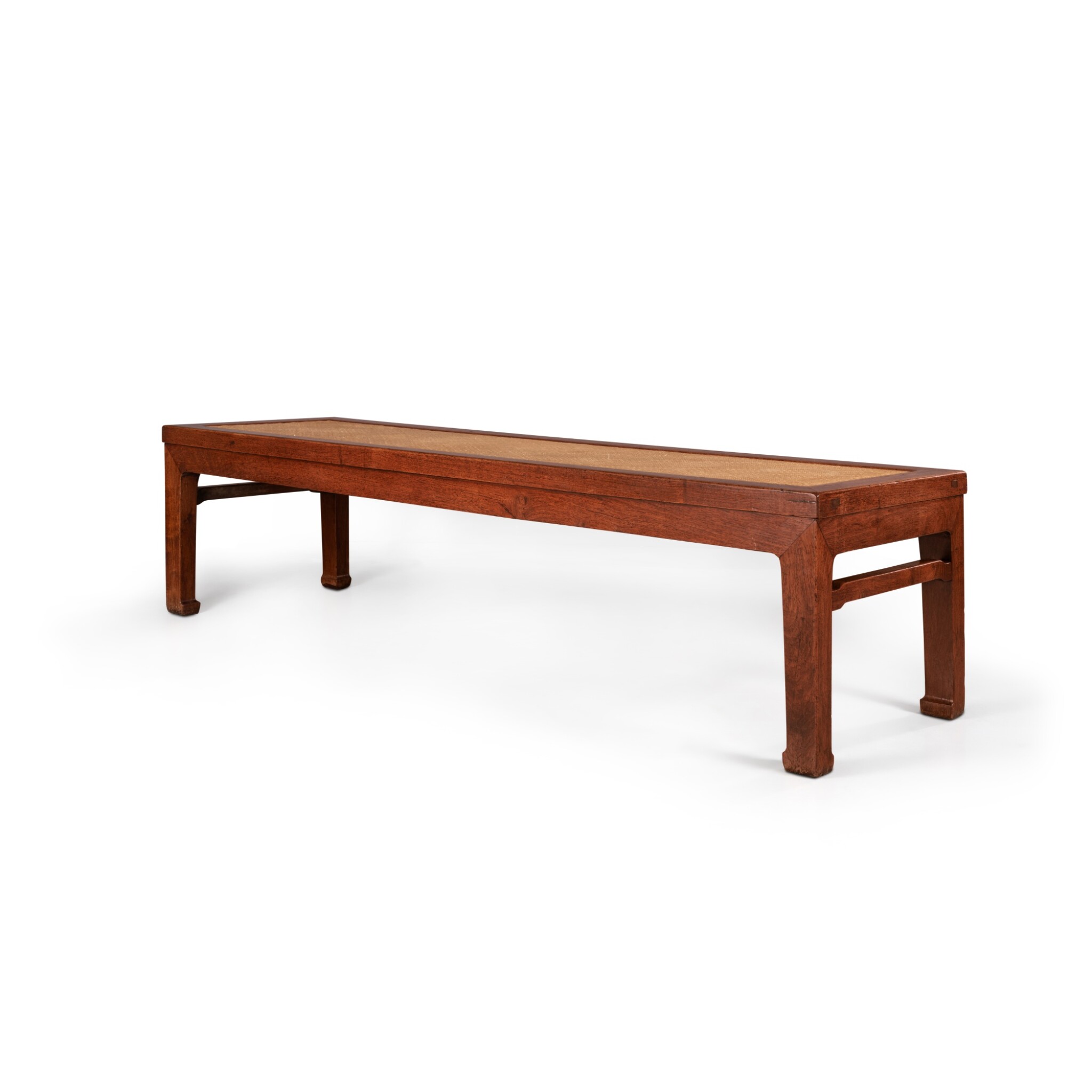
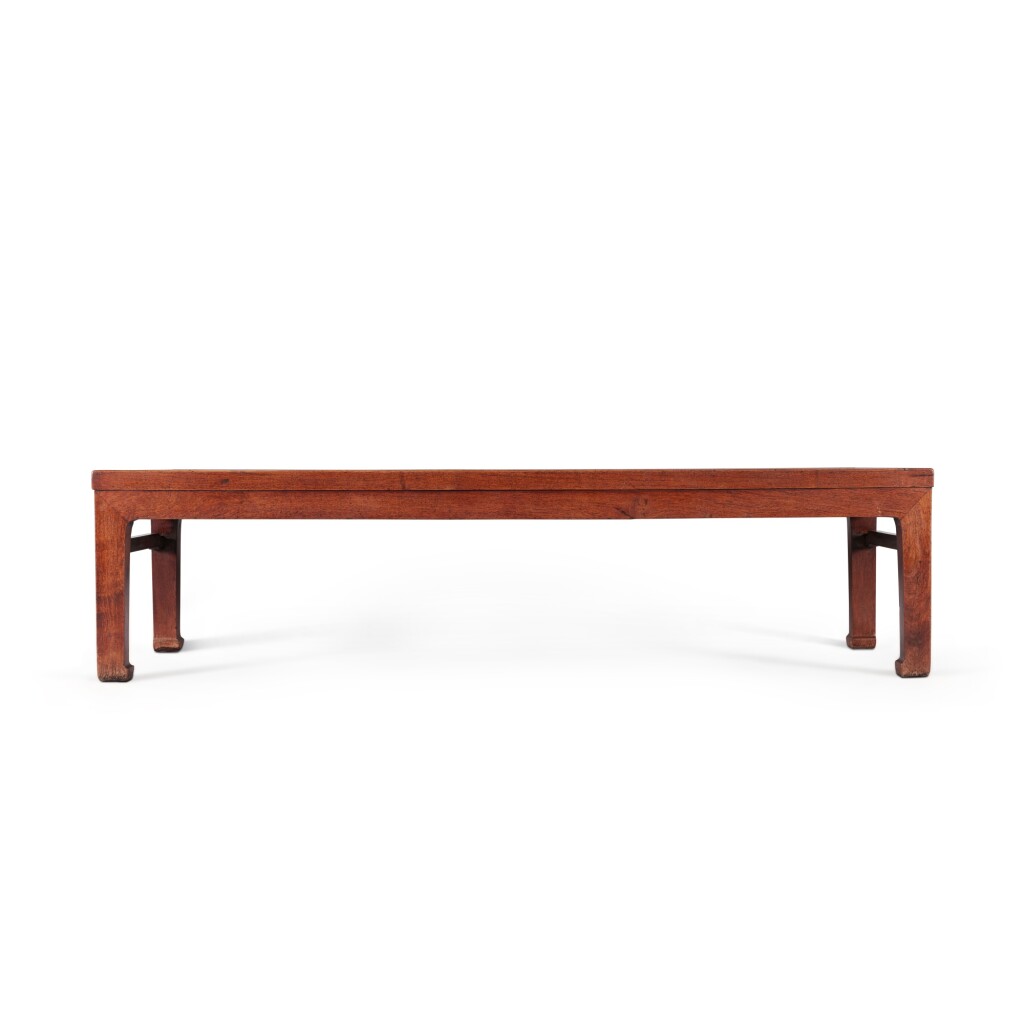
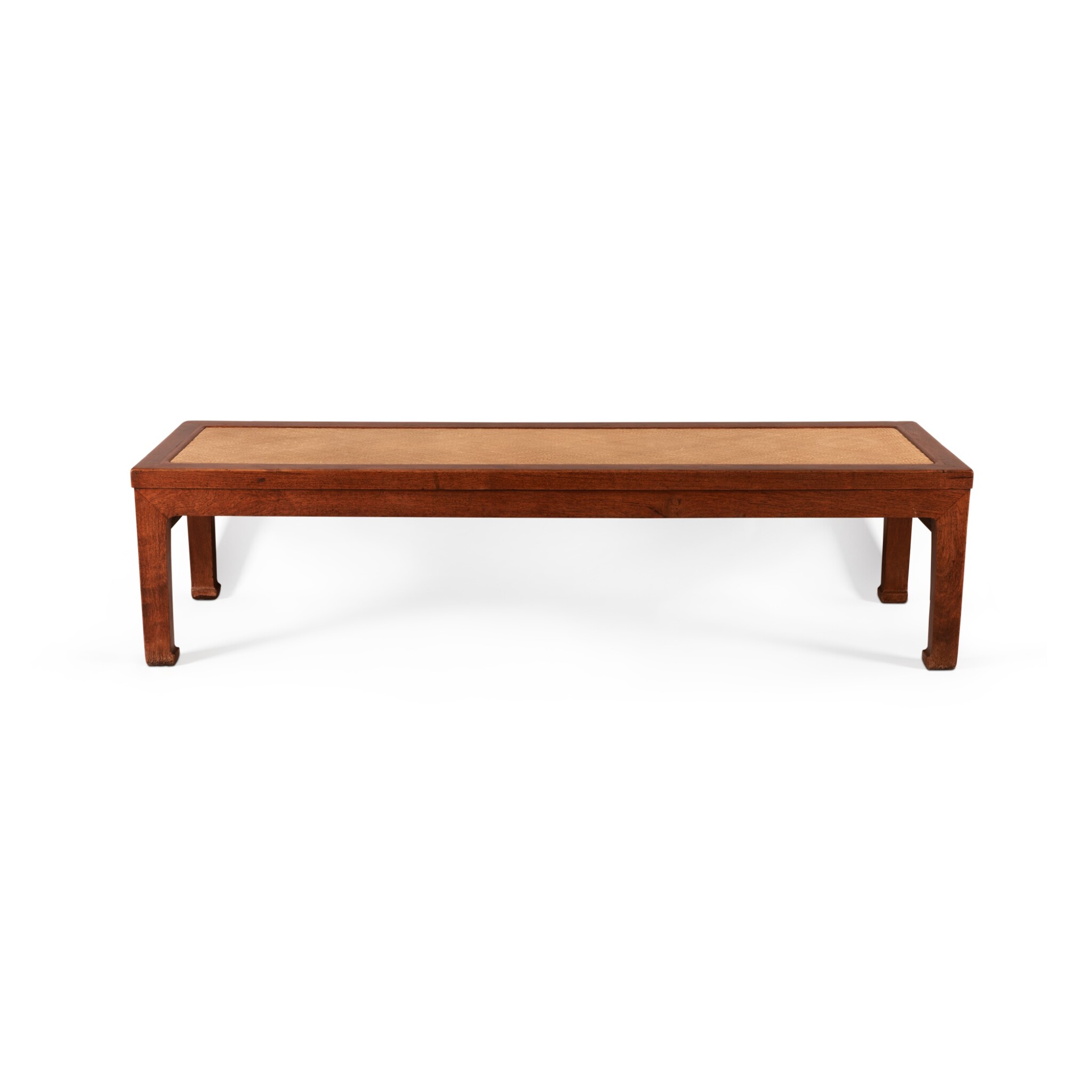
Lot Sold 482,600 GBP
Estimate 150,000 – 200,000 GBP
Description
Property from a European Private Collection
歐洲私人收藏
54 by 211.5 by 62.5 cm, 21 1/4 by 83 1/4 by 24 5/8 in.
Condition Report
Feet lost height, consistent with age. Some general wear to the surface overall.
Saleroom Notice
This lot contains endangered species. Sotheby’s recommends that buyers check with their own government regarding any importation requirements prior to placing a bid. For example, US regulations restrict or prohibit the import of certain items to protect wildlife conservation. Please note that Sotheby’s will not assist buyers with the shipment of this lot to the US. A buyer’s inability to export or import these lots cannot justify a delay in payment or sale cancellation. 此編號含有瀕臨絕種物料。蘇富比建議買家在投標之前,先理解有關地方政府的入口限制。如美國為保護野生動物而對有關材質所實行的出入口規條及限制。蘇富比將不會協助此編號運往美國的運輸。買家無權因為未能得到出入口許可而取消拍賣及延遲付款。
说明
这俱床塌内敛优雅是通过其四面平或“四角齐平”结构实现的,其中腿与顶部齐平。 它被认为是明式家具最吸引人、最经典的特征之一。 这种类型的设计有时在中国文献中也被称为“厚拙”,字面意思是“坚固、笨拙”,这在明式家具收藏家眼中被认为是一种品质。 线条简洁,凸显木纹之美,传达出精致和低调的财富感。
比较黄花梨床塌及其下部类似的“四角平齐”结构,参见 Grace Wu Bruce,《中国古典家具》,香港,1995 年,图版 11。 22. 另一种坐卧两用床塌具有相关的无腰结构和尺寸,但在腿上连接有驼背担架,发表于 Sarah Handler,“私人房间中的杰出作品:新美国收藏中的中国古典家具”,Orientations,1993 年 1 月,图 1。 4. 并于 2016 年 3 月 16 日在我们的纽约拍卖行出售,拍品 227,并于 2021 年 5 月 13 日在伦敦邦瀚斯再次出售,拍品 11,来自 H Collection。 另请参阅我们香港拍卖行于 2022 年 10 月 9 日出售的相同形式的无担架四面平长凳,拍品 158,来自何东爵士的个人收藏。
高台是最古老、最基本的家具形式。 早在商代,青铜台不仅用于支撑稀有珍贵的青铜礼器,而且还通过将其高举于地面来强调其重要性。 到了汉代,在墓葬中发现了陶瓷和石头上的“塔”的例子,表明这种形式已被广泛使用,并且它表明了社会地位,如许多宴会场景所示,只有最重要的人物坐在高台上。 这种形式的微缩模型在明代潘元正墓(1589年)中的其他家具模型中被发现,现藏于上海博物馆,并在王世襄的《中国艺术鉴赏》卷 11 中进行了插图。 1,香港,1990 年,图版。 1.3a。 有关形式的进一步讨论,请参阅 Sarah Handler,Austere Luminosity of Chinese Classical Furniture,香港,2001 年,第 105-158 页。
Catalogue Note
The restrained elegance of the present daybed, ta, is achieved through its simianping or ‘four corner’s flush’ construction where the legs are set flush to its top. It is considered one of the most attractive and classic features of Ming furniture. This type of design is sometimes also referred to as houzhuo, in the Chinese literature, literally meaning ‘robust, clumsy’ which is considered a quality in the eyes of Ming furniture collectors. The simplicity of the lines, highlighting the beauty of the wood grain conveys here a sense of refinement and understated wealth.
Compare a huanghuali daybed with its lower section similarly constructed with a ‘four corner’s flush’ structure, illustrated in Grace Wu Bruce, Chinese Classical Furniture, Hong Kong, 1995, pl. 22. Another daybed, ta, of related waistless construction and size but with humpback stretchers joining the legs, is published in Sarah Handler, ‘Outstanding Pieces in Private Rooms: Chinese Classical Furniture in New American Collections’, Orientations, January 1993, fig. 4. and was sold in our New York rooms, 16th March 2016, lot 227, and again at Bonhams London, 13th May 2021, lot 11, from the H Collection. See also a simianping bench of the same form without stretchers sold in our Hong Kong rooms, 9th October 2022, lot 158, from the personal collection of Sir Joseph Hotung.
The raised platform is the oldest and most fundamental of furniture forms. As early as the Shang dynasty, bronze platforms were used not simply to support rare and precious bronze ritual vessels but also to emphasize their importance by raising them up above the ground. By the Han dynasty examples of ta in ceramic and stone have been found in tombs indicating that the form was in regular use and that it indicated social status as illustrated in numerous banquet scenes where only the most significant figures are shown seated on raised platforms. A miniature of this form was found among other models of furniture in the Ming dynasty tomb of Pan Yuan Zheng (1589) now in the Shanghai Museum and illustrated in Wang Shixiang, Connoisseurship of Chinese Art, vol. 1, Hong Kong, 1990, pl. 1.3a. For further discussion on the form see Sarah Handler, Austere Luminosity of Chinese Classical Furniture, Hong Kong, 2001, pp. 105-158.
参考:观复博物馆 清雍正 紫檀锦地拼面书桌
Data by Guamfu Museum on 2020-02-18
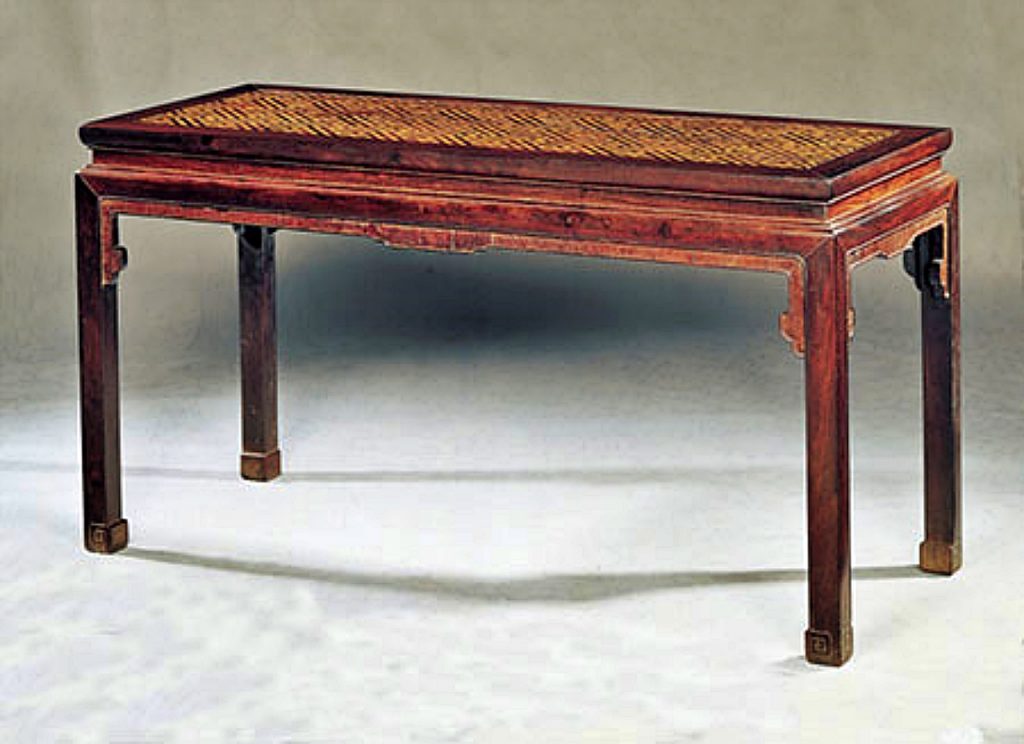
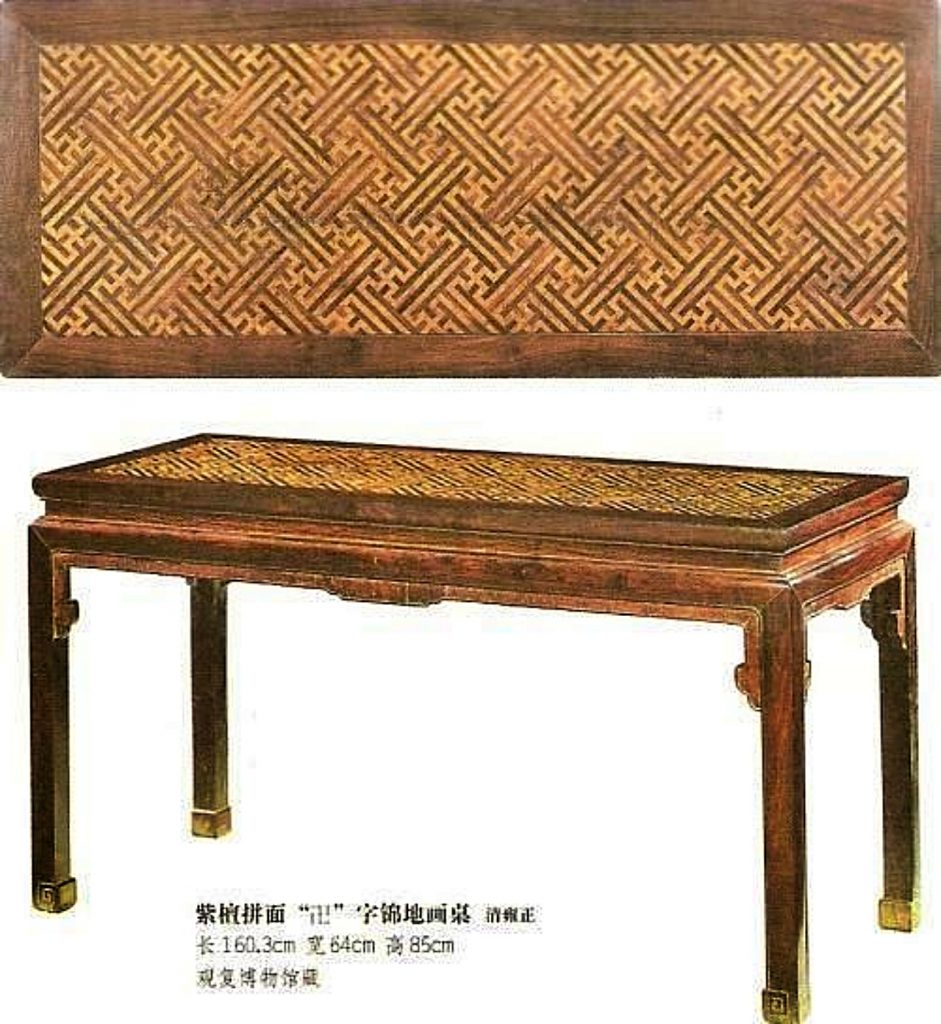
长160.3cm 宽64cm 高85cm
古代工匠在家具制做中常常显示出高超的手艺,尤其大内造办处的工匠,穷极工巧,极尽能事。清朝康雍乾三朝,天下能工巧匠均被召集进宫,一年到头为皇帝尽职。由于皇帝常亲临督阵,工匠不敢有丝毫懈怠,这件锦地拼面的画桌就记录了这一时期的奢华。整个桌面用了大约数千块细碎小木拼成,以万字锦地隐喻幸福延绵不断,每个部件都以榫卯相接,而不是随意粘贴了事。这种工艺,对于工匠也是难事,故清雍正造办处文档有记载,由于费工费时,造办处曾打报告请示皇上,说此工艺太费工时,恳请皇上明鉴。雍正帝还算开明,稍加思索朱笔御批:再做几件,余下就不要再做了。所以,雍正一朝为其此类家具的下限。这种锦地拼面的工艺,除故宫尚存几十件外,流出故宫的目前只发现这一件,原藏于北京著名的那家花园。
紫檀书桌不足为奇,但紫檀拼面书桌可就是稀罕物了,锦地拼面是雍正皇帝御用的艺术品,整个桌面看似杂乱无章,却是用五千多块的细碎小木,以榫铆拼接,背后的工艺复杂无比,目前世上仅存十余件,几乎都收藏在故宫之中,在民间的仅有马未都手上的一件,其价值自然非比寻常。
参考:保利2014春季拍卖会
山中商会宝藏乾隆御题天青釉笠式碗,宫廷艺术与重要瓷器、玉器、工艺品
6287 清乾隆 御制紫檀高浮雕西番莲方桌
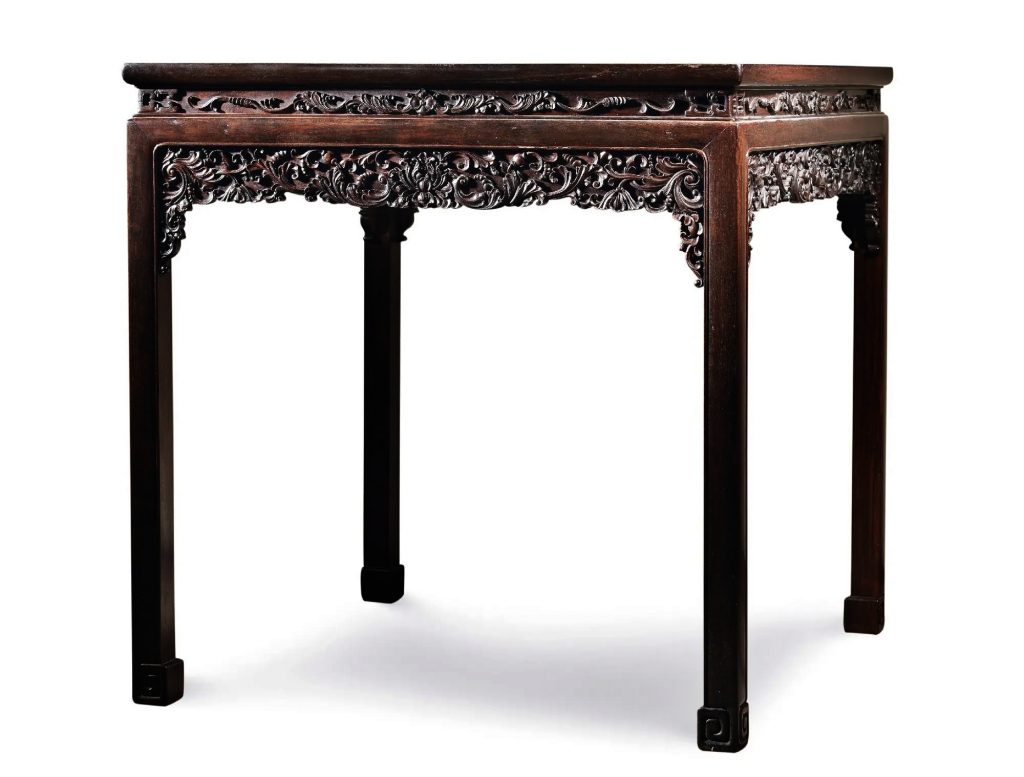
尺寸 87.5×87.5×88cm
估价 4,500,000-6,500,000
成交价 RMB 5,980,000
出版:《紫檀》第82页,寒舍出版社,1996年8月
备注:
1.香港拍卖,1995.04.30,Lot 566A;
2.香港拍卖,2007.11.27,lot 1673
此桌小叶紫檀质地,体呈长方形。取材整装壮硕,颇为罕见。其色泽古雅沉静,木质纹理细腻秀润。造型敦厚稳重,极为典雅富丽。桌面以暗榫攒边框装板而成。边抹及面芯特别选用纹路一致的木料做成,拼合严密,仿若一体,足见做工之考究,显得格外美观。冰桌边收盘沿,琢磨浑圆,沿下起阳线,连接高束腰。束腰上铲地高浮雕西番莲纹。减底处平滑如砥。西番莲枝叶花朵宽大饱满,曲线蜿蜒流畅,凹凸感极强。束腰四角处,装饰高浮雕独立拐子纹。束腰下端亦起阳线。牙头、牙板亦铲地浮雕西番莲纹,与束腰上纹饰相映成趣,这种带有西洋味道的纹饰,和圆明园中所遗存下来许多建筑石雕风格,如出一辙,表现出浓郁的时代风貌和皇家的审美意识。方材桌腿憨实规整,其下收内翻卷云足,足体稳实方正,乃典型清代风格。此桌材质珍贵,制作精细,装饰纹样华美非凡,体现了雍容大气的艺术特点。无论从选用材料或纹饰雕刻的风格来看,皆属乾隆年间之宫廷御用家具精品。
故宫【紫檀木雕花长桌】
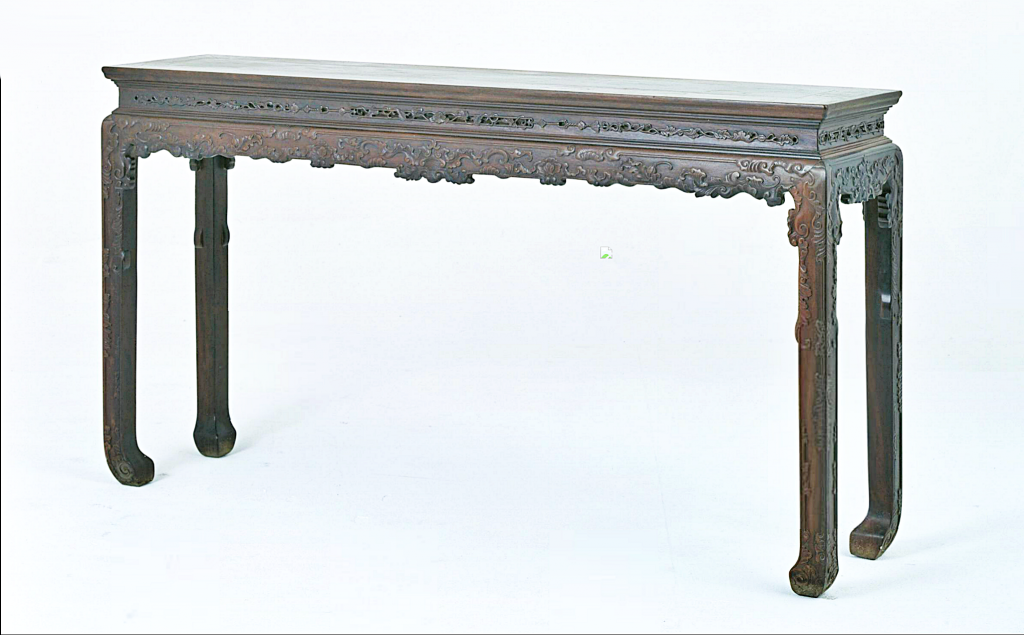
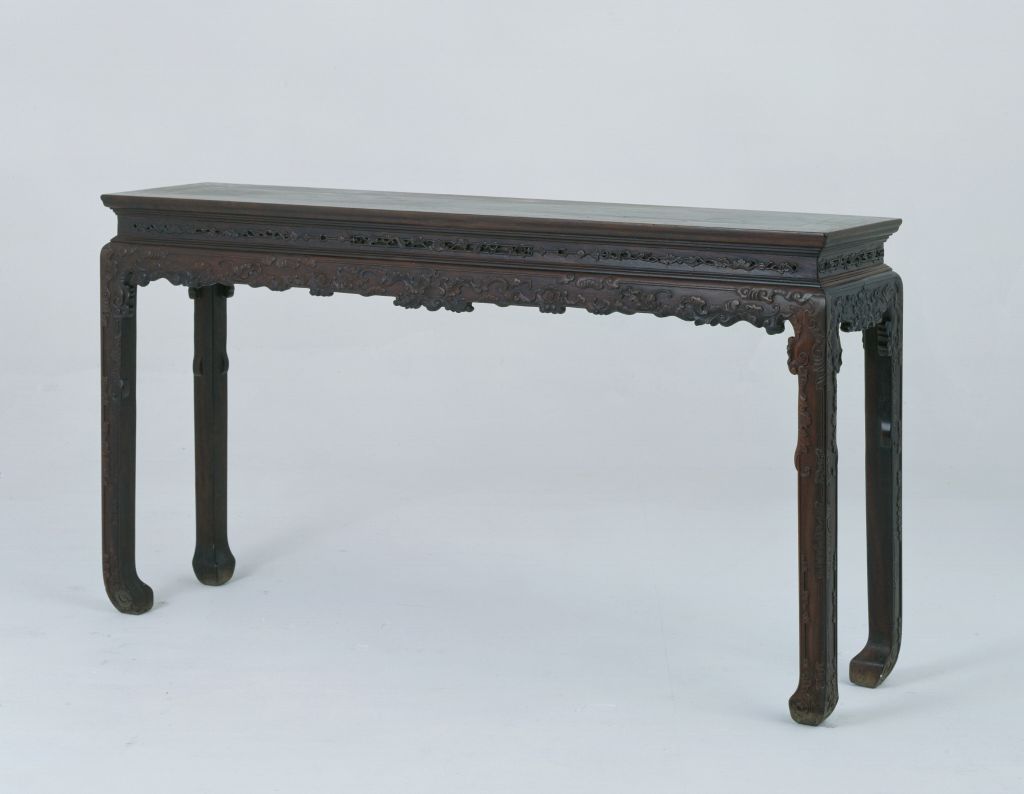
清,高89.2厘米,长165.5厘米,宽38.7厘米。
桌紫檀木质。桌面板心用一块整板镶成,下面辅以穿带四条。面下束腰,中间镂雕串枝西洋卷草花纹。束腰下托腮与上托腮对称。再下是牙板,浮雕西洋卷草花纹,牙板下沿随花纹形态作成曲边。四角立四腿,由于上下托腮的作用,桌沿喷出较多,因而四腿的拱肩也较大。四条腿通体饰西洋花纹。四腿与牙板结合的拐角处作出翅式牙,其与四腿一木连作,且与牙板的曲线相呼应。腿下端为内翻马蹄形足。
撰稿人:胡德生
关键词: 紫檀木 穿带 束腰 镂雕 串枝 卷草 托腮 牙板 浮雕 拱肩 一木连作 内翻马蹄
参考:故宫 储秀宫 内置
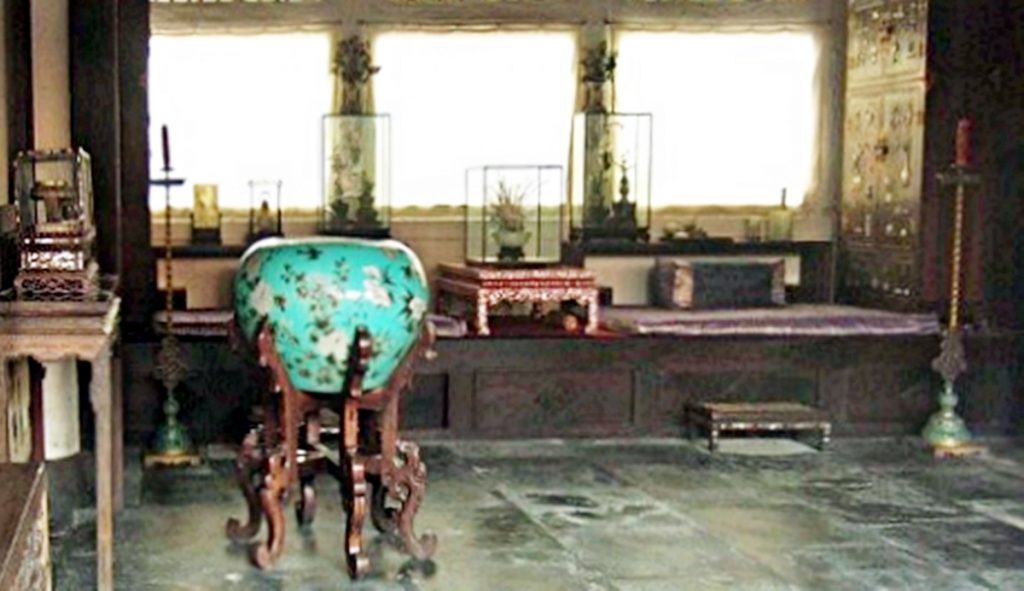
参考:保利第42期精品拍卖会
瓷器 玉器 工艺品
0557 清 黄花梨明式条桌
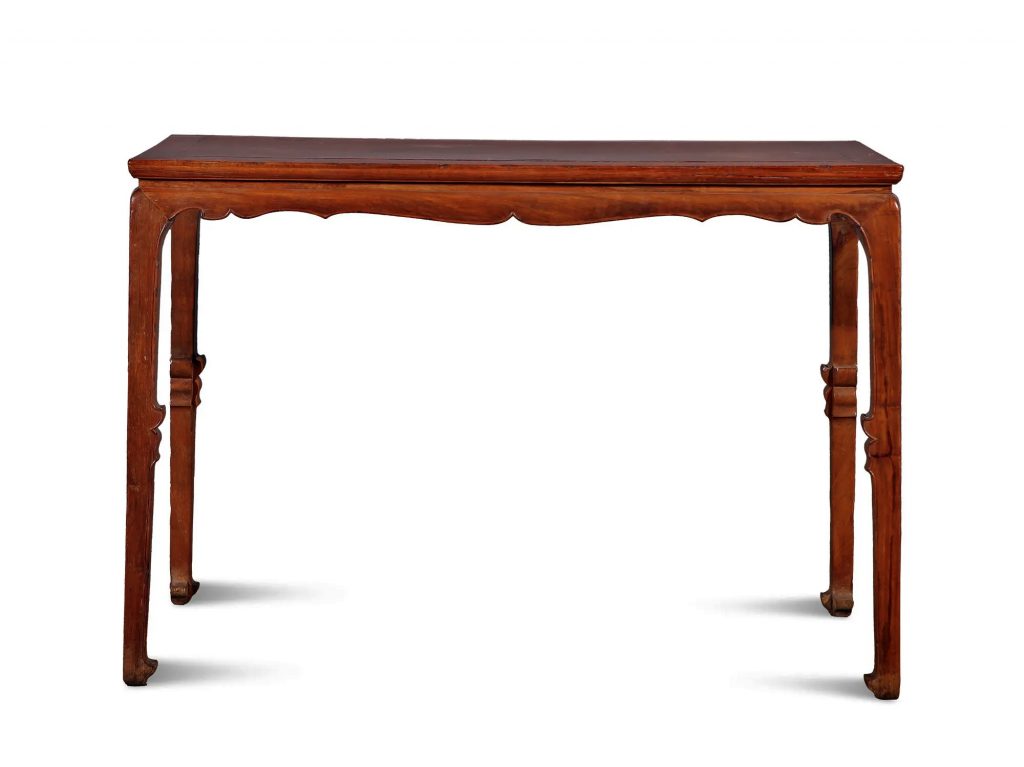
尺寸 120×57×84cm
估价 无底价
成交价 RMB 253,000
参考:北京保利第51期古董精品拍卖会
瓷器·玉器·工艺品
0705 清 黄花梨明式条桌
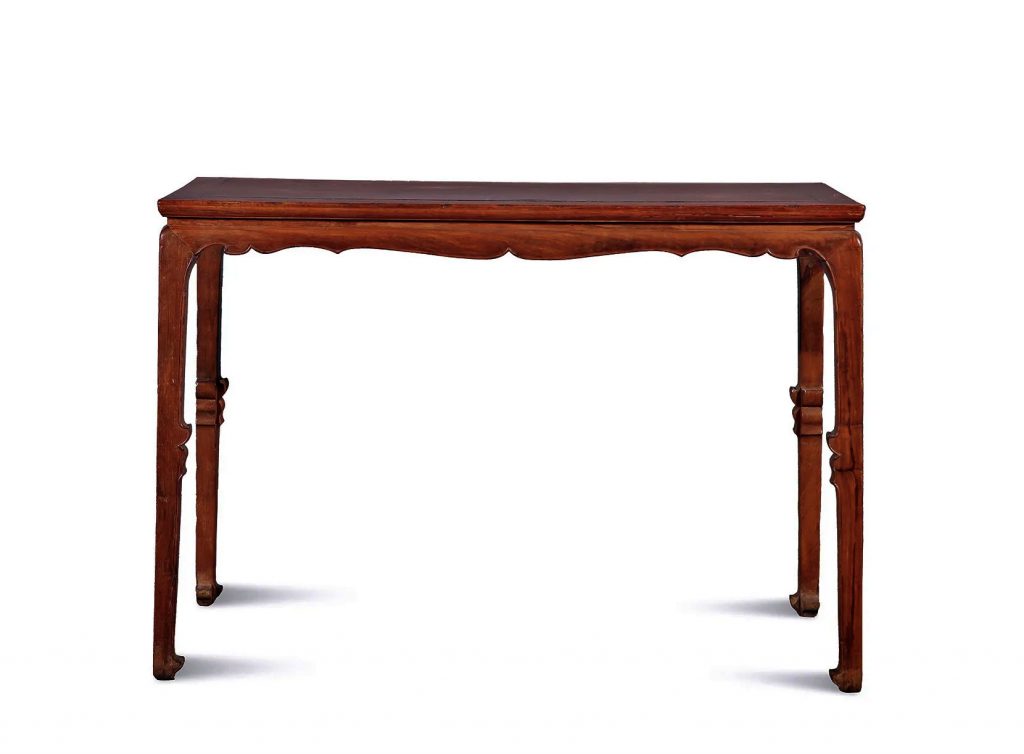
尺寸 120×57×84cm
估价 无底价
成交价 RMB 138,000
简居—私家藏家具专场(Lot640-727)
参考:
第47期(义乌)精品拍卖会
书画·瓷器·玉器·工艺品
1129 清 黄花梨带托泥香几 (一对)
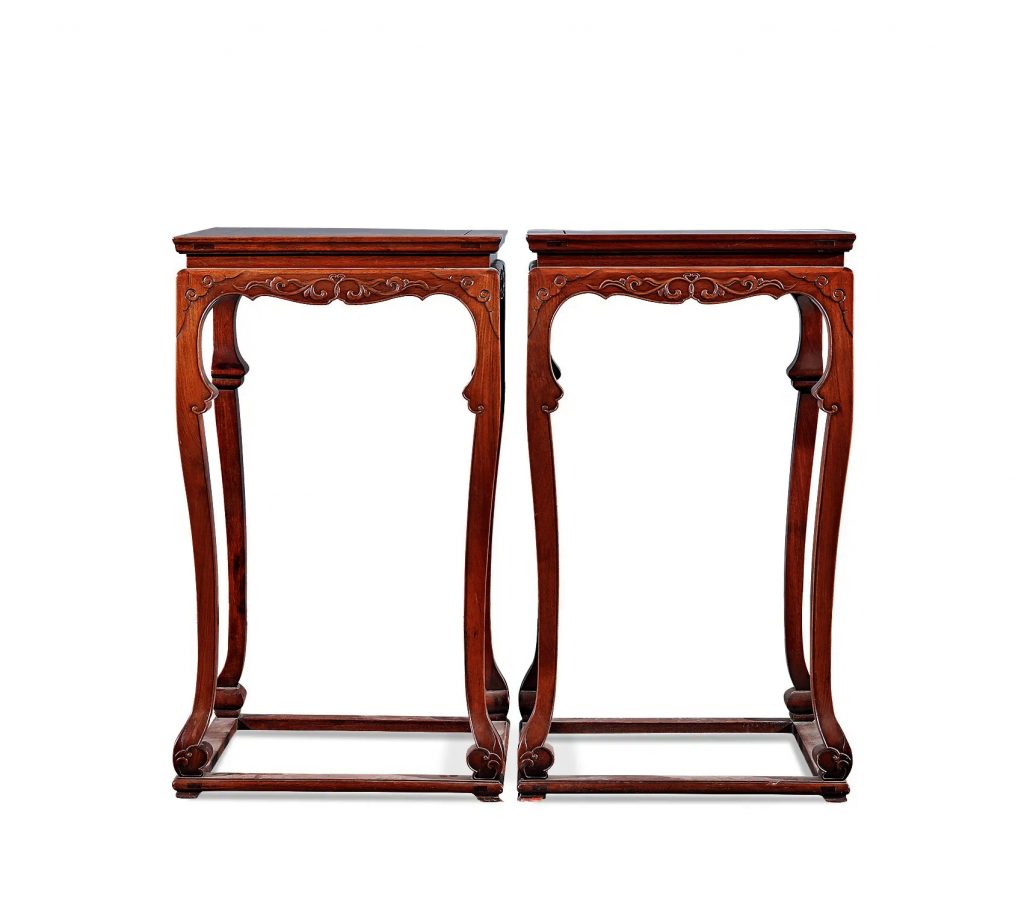
尺寸 52×52×91cm
估价 38,000-58,000
成交价 RMB 43,700
参考:北京保利
第39期古董精品拍卖会
瓷器 玉器 工艺品(二)
2563 黄花梨条桌
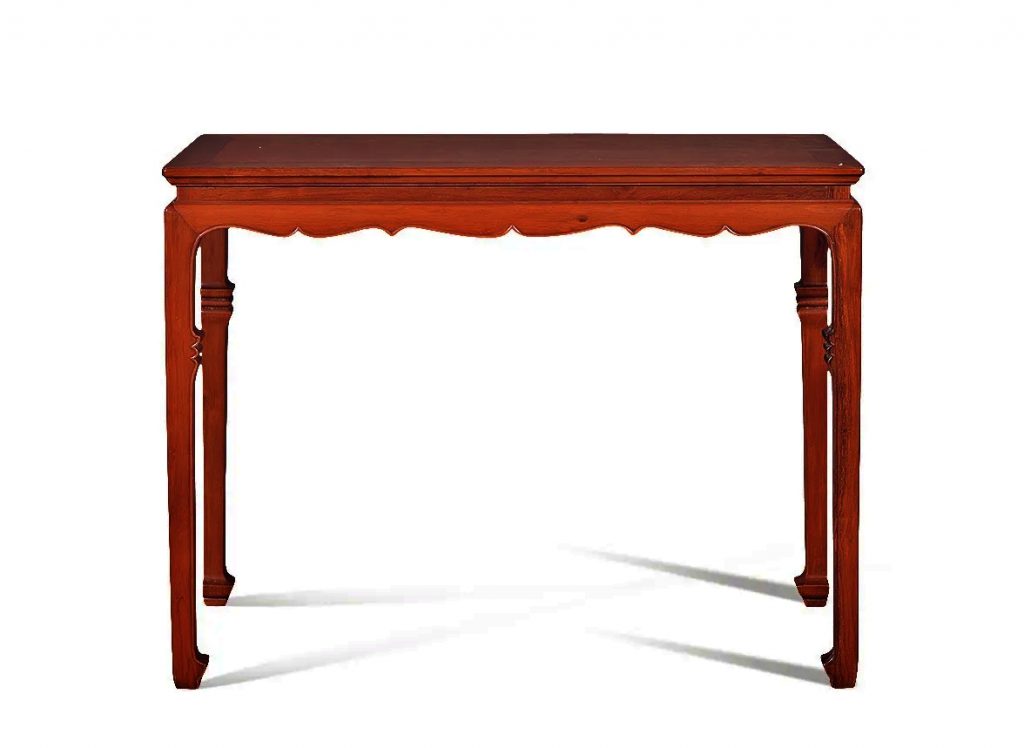
尺寸 106×46×82cm
估价 36,000-55,000
成交价 RMB —
参考:
第36期古董精品拍卖会
瓷器 玉器 工艺品二
2099 民国 黄花梨小翘头案
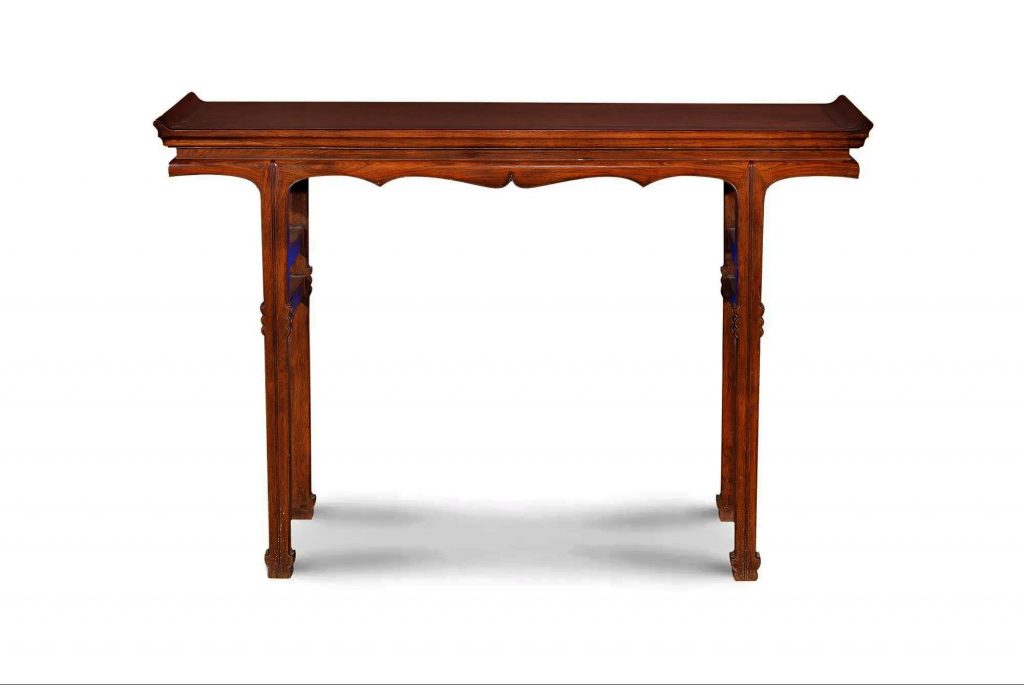
尺寸 126×37×83cm
估价 55,000-80,000
成交价 RMB —
参考:
北京保利十二周年春季拍卖会
中国古董珍玩(II)
7047 清 黄花梨条桌
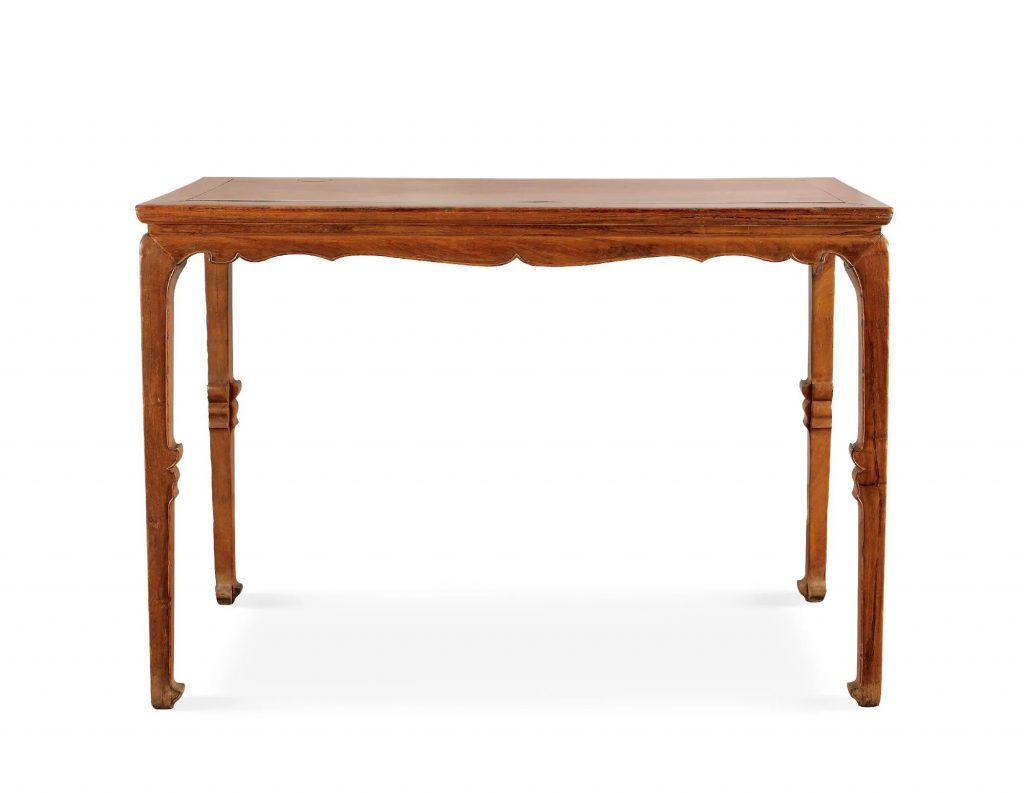
尺寸 长119.5×58×83.7cm
估价 450,000-650,000
成交价 RMB —
此桌的上部采用束腰形式,下部没有托泥,用一块素板做束腰,故显得亭亭玉立,牙板的两头用大进小出的互错透榫连接桌腿,形成了优美的壸门结体,壸门轮廓非常完整。腿足中部花叶突出处,断面作曲尺形,即所谓挖缺作。马蹄有一双向上翘起的尖足。此桌最为优美的是牙板与腿部一气呵成的壶门曲线,牙板曲线与腿部曲线衔接,天衣无缝,在腿中部做一停留,然后至足处又翻起,悄然结束,去拙取巧,美不胜收。
备注:原北京家具厂库出
参考:北京保利拍卖
2022年春季艺术品拍卖会
挹古芳—宫廷艺术与重要瓷器、玉器、工艺品
6762 清 黄花梨独板面插肩榫小翘头案
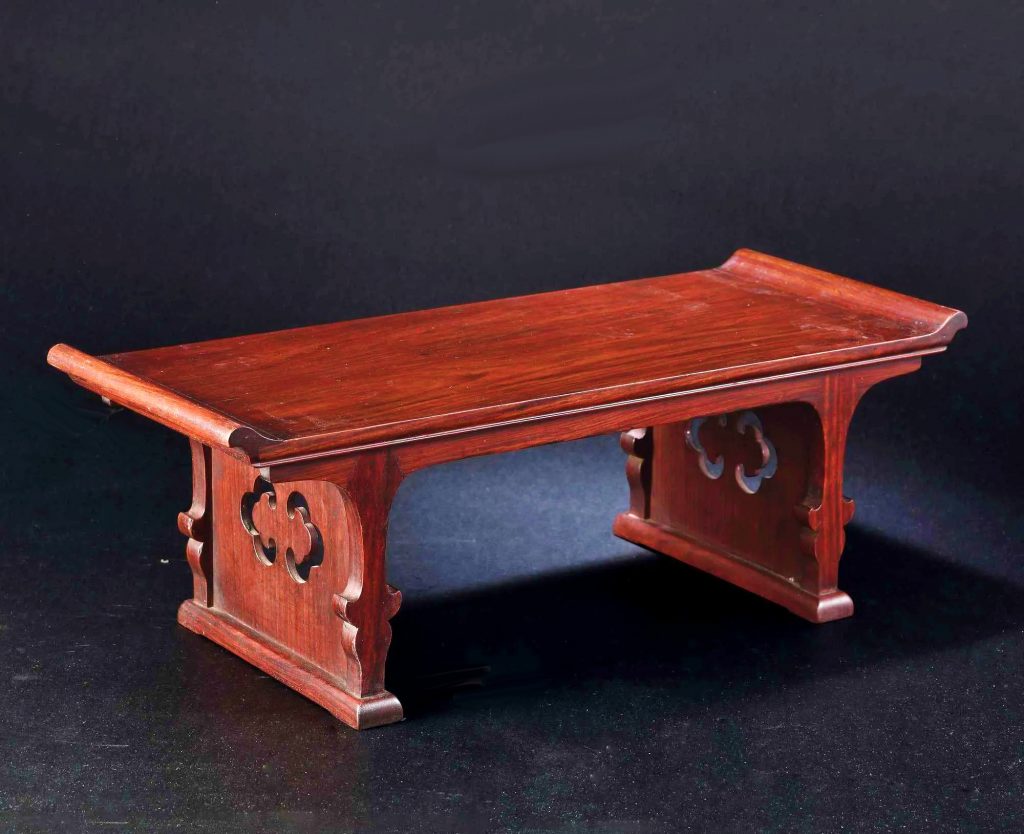
尺寸 47.2×19×16.3cm
估价 300,000-500,000
成交价 RMB 345,000
通体以黄花梨为材,独板面,案面两端嵌入小翘头。边抹四边底端押窄线,下接牙板,牙头铲地浮雕卷云纹,边缘起线。腿足以插肩榫纳入案面,足端做箭腿,下承托泥台。腿足间绦环板透雕装饰云头,雅致可观。与常见大案相比,是件小案虽不及大案宏伟巨制,但足以在小中见大,其比例协调,结构精整,造型文静而端庄秀丽,可于精整中颇见法度,于秀美中透出大方,精气内敛而不张扬,气息温和含蓄。其制作至精至巧,纹理优美,包浆厚重,品相完美。
参考:北京保利2019金秋
第49期精品拍卖会 古董珍玩
瓷器·玉器·工艺品
1086 清 黄花梨剑腿平头案
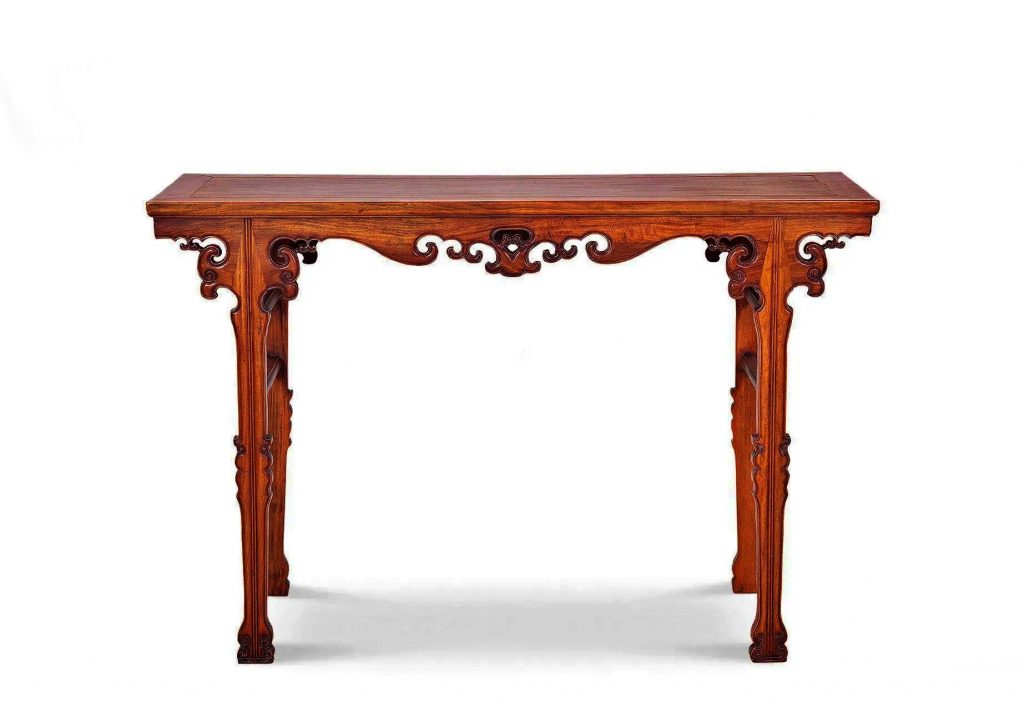
尺寸 119×40×80cm
估价 无底价
成交价 RMB 20,700
参考:
北京保利2021春季拍卖会
逍遥座—重要名藏明清古典家具
6710 明晚期 黄花梨对卷云纹榻
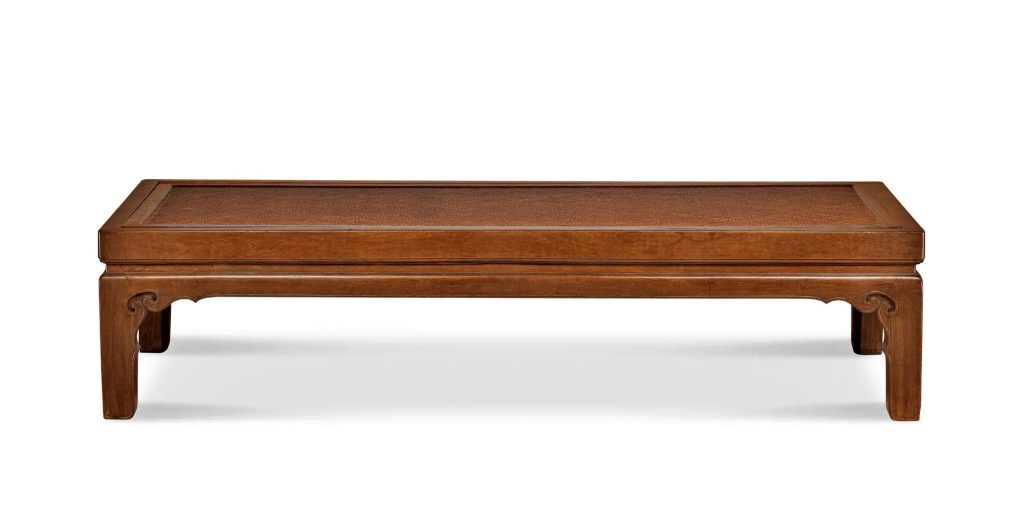
尺寸 长191cm;宽80.7cm;高44.5cm
估价 2,600,000-3,600,000
成交价 RMB 2,990,000
【备注】
纽约佳士得,2013年9月,Lot1567
黄花梨小榻,尺寸小巧,为一人所用之“独眠床”,制式高古,尚有大漆家具造型特征。
面框为立帮式,上方平素,至下端做成冰盘沿,宛如石板,平整雅洁。转角处外缘做成大弧角,柔和过渡,有“折钗股”之妙。边框内为可拆卸活床屉,前后大边上有杉木托带,既起连接边框的作用,又可承托床屉。束腰与牙板一木连做,牙板上斫出一道弦线为托腮。直牙板,用料充裕,颇厚重,其内有燕尾销加固其与边框的连接,牙板两头则制成与腿足相组成的“猫耳朵式”对卷云纹牙头,牙板沿边起宽皮条线,延伸至牙头与腿足处。对卷云纹不透雕,采用高浮雕做法,以求不破坏腿足和牙板间的支撑力量。
腿足与牙板以斜格肩榫相合,榫卯线横跨牙板、束腰,尚余部分腿足在束腰处,即所谓“露明”做法。腿足直落于地,内侧为挖缺做,即将内转角挖去部分,形成“L”形截面,这种做法可以上溯至战汉时期的壸门家具,今日本家具尚保留这种造型。黄花梨采用这种做法,除了增造型变化,平衡腿足与整体体量关系外,也更方便取料,是一种合理、科学、美观的做法。

![[临渊阁]天地一家春](https://www.antiquekeeper.ca/wp-content/uploads/2023/04/BW-Erping-1a-17-6-1.jpg)
